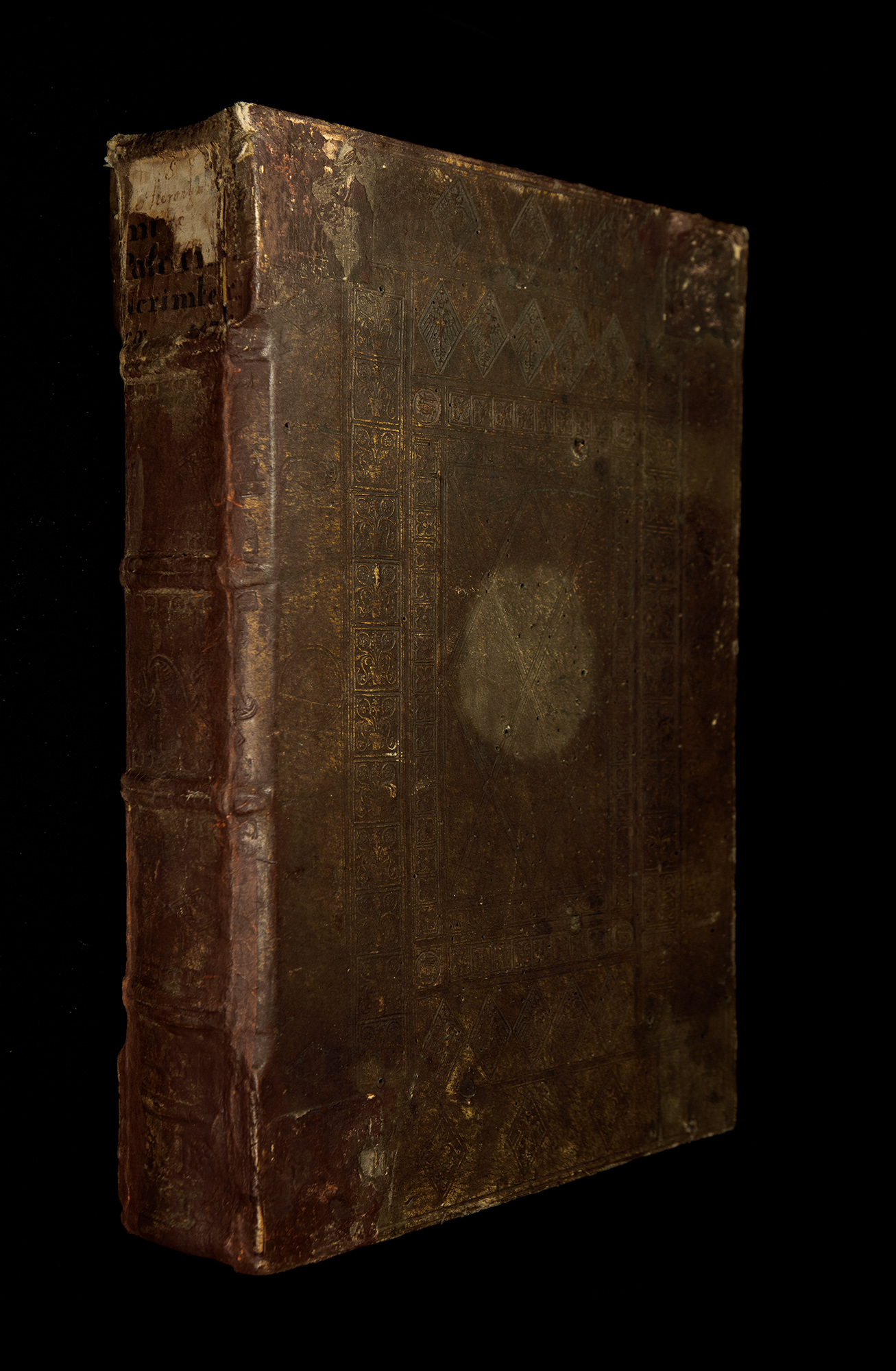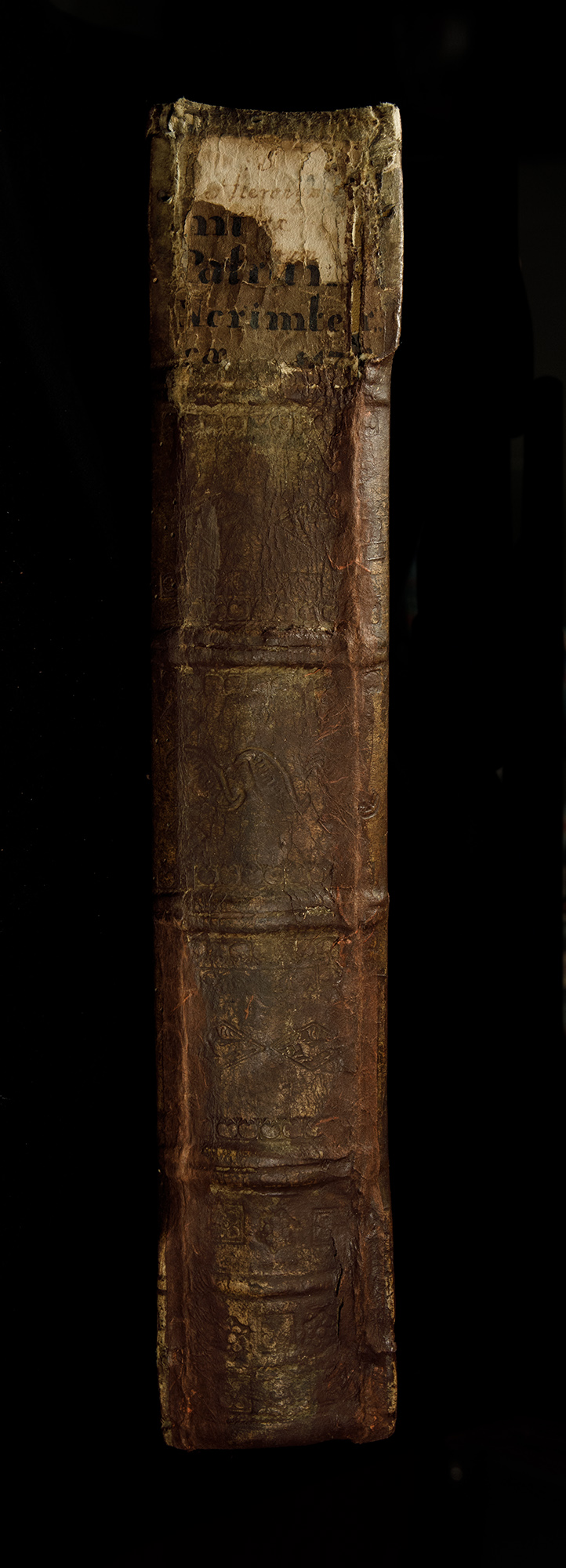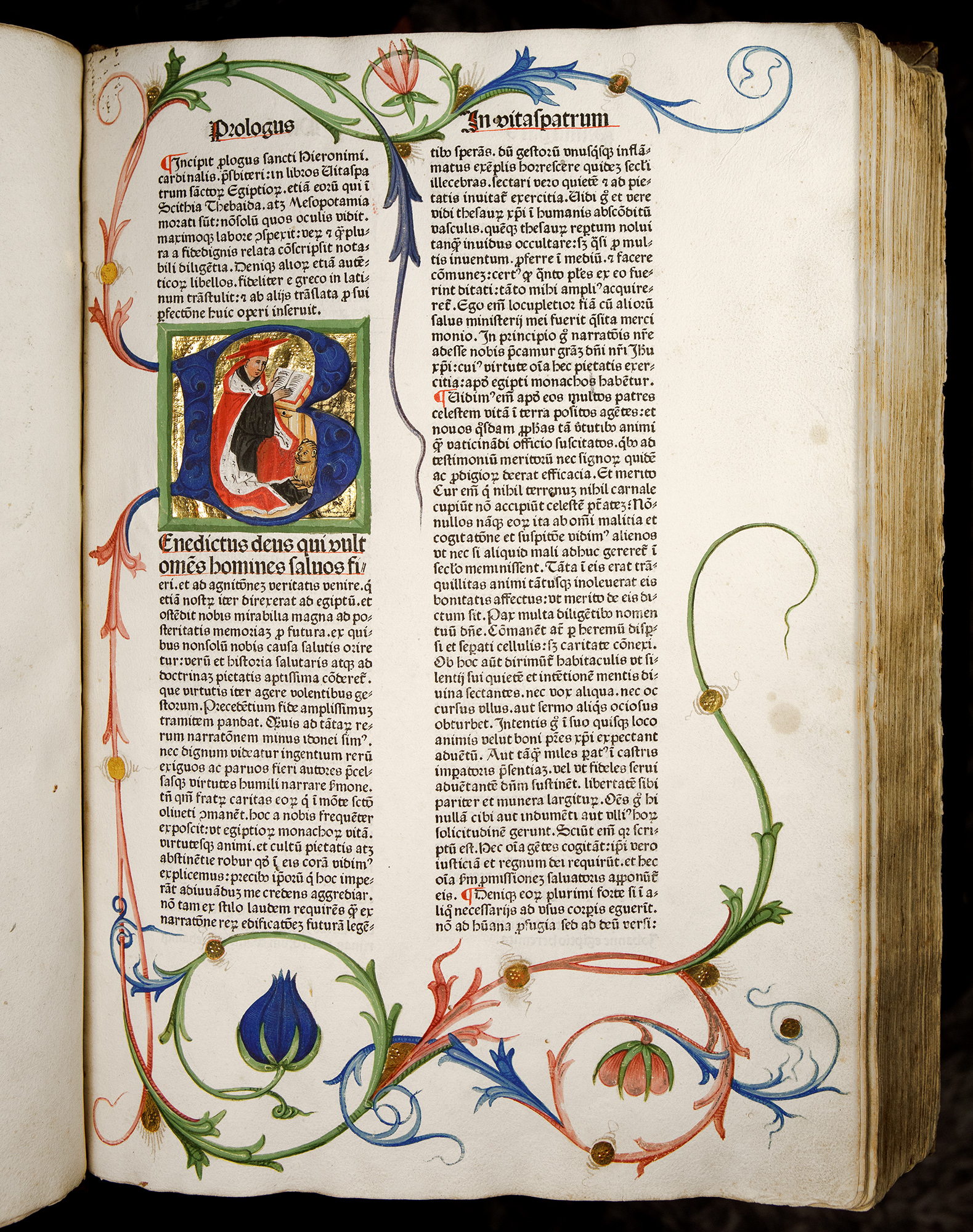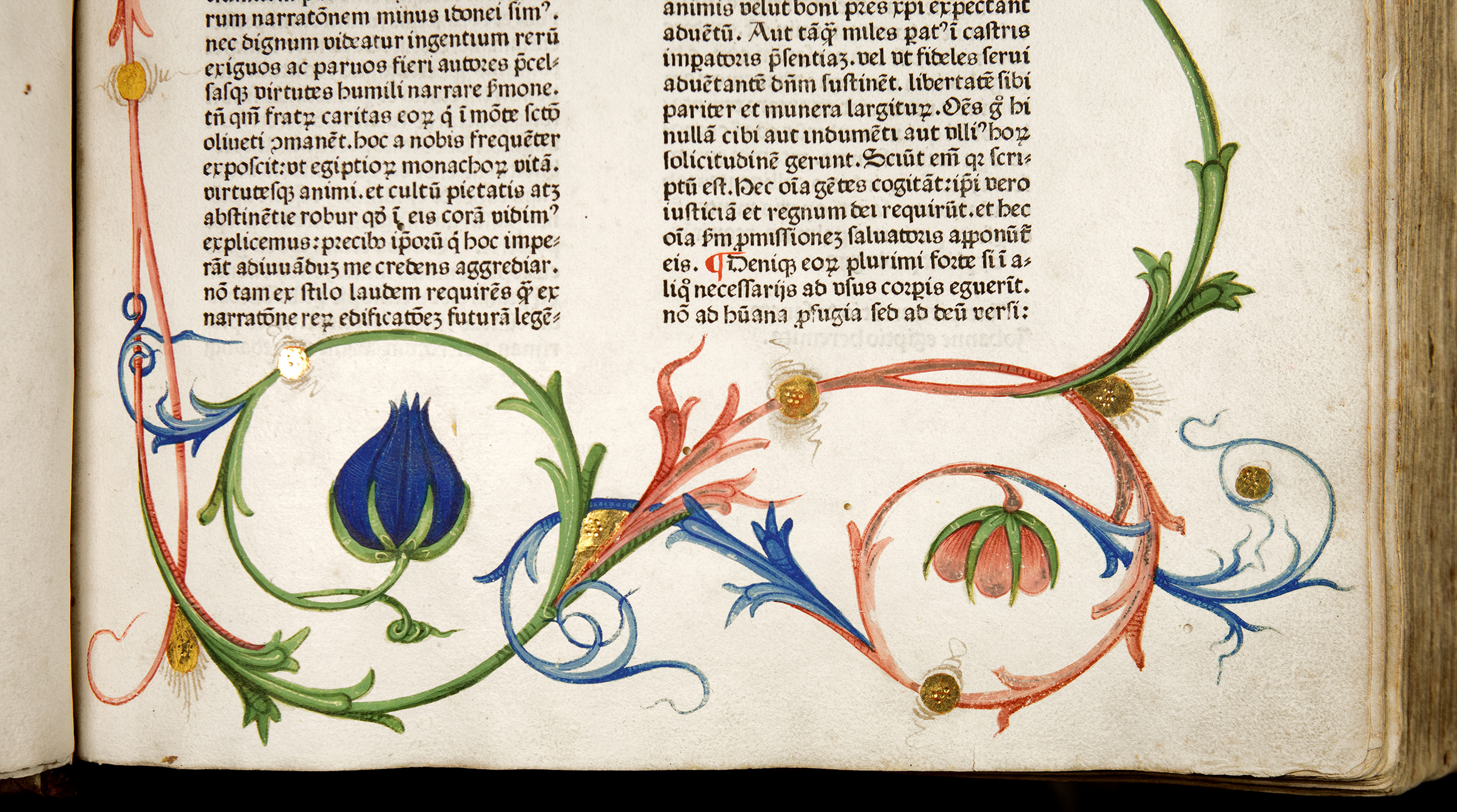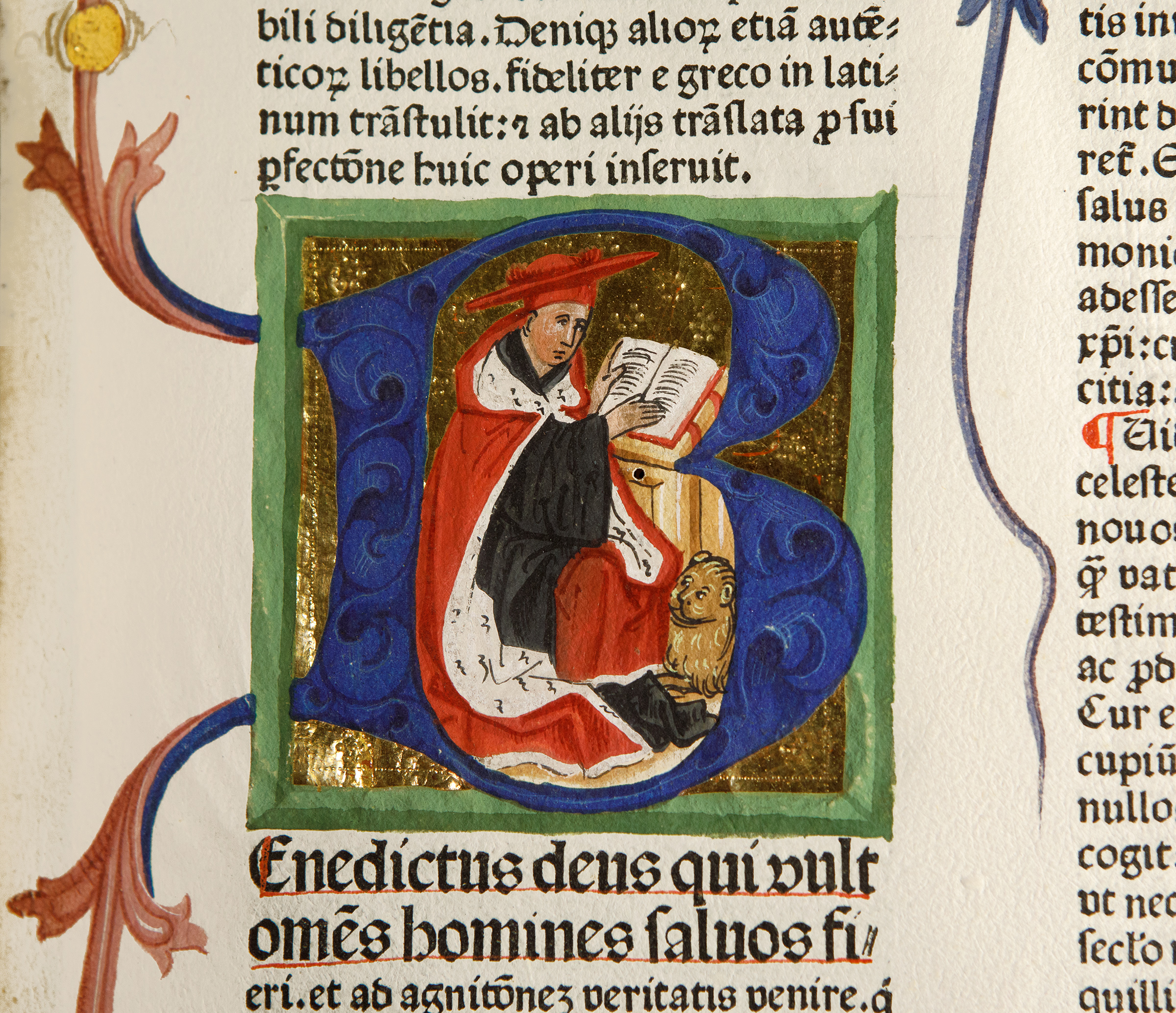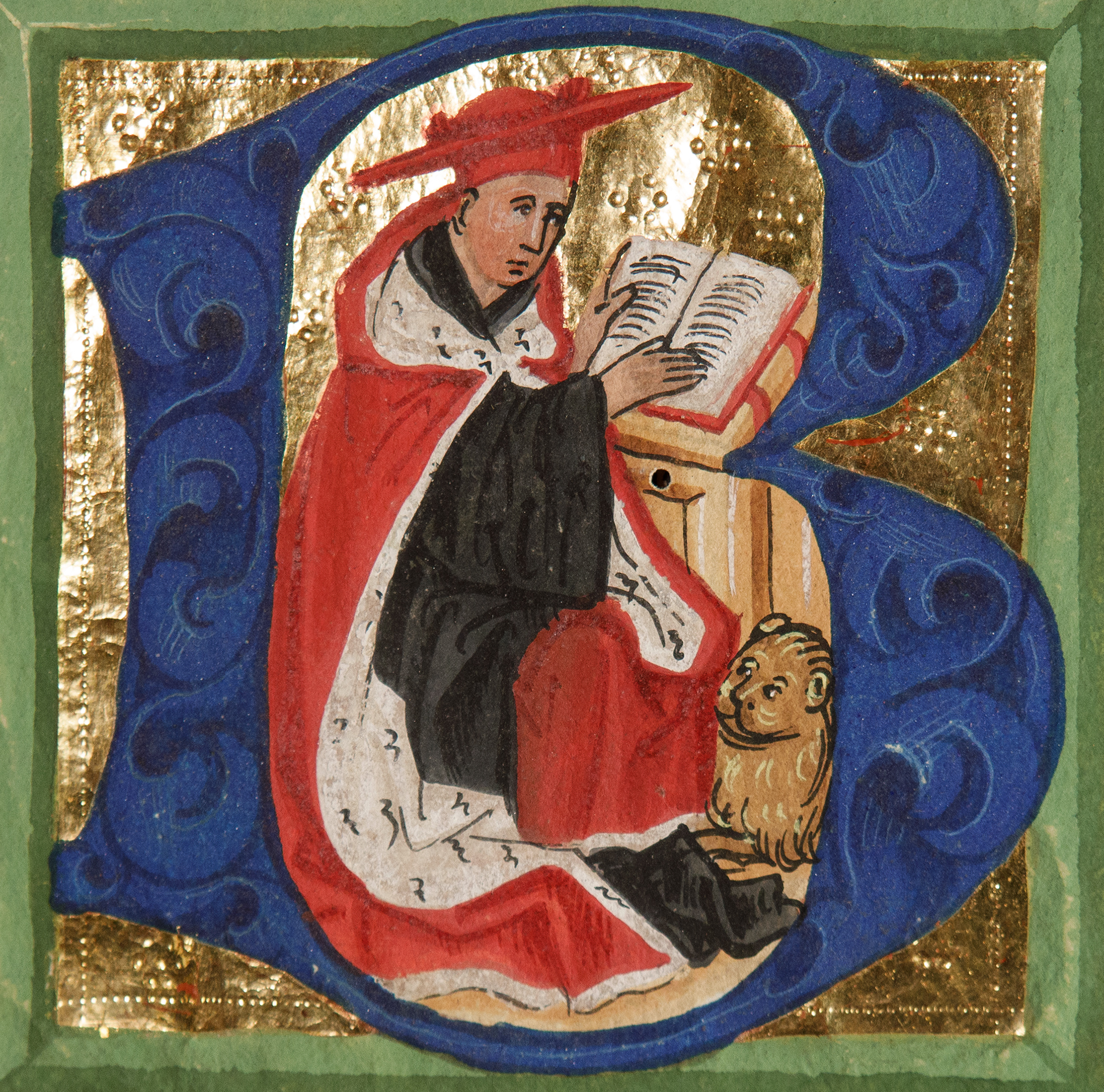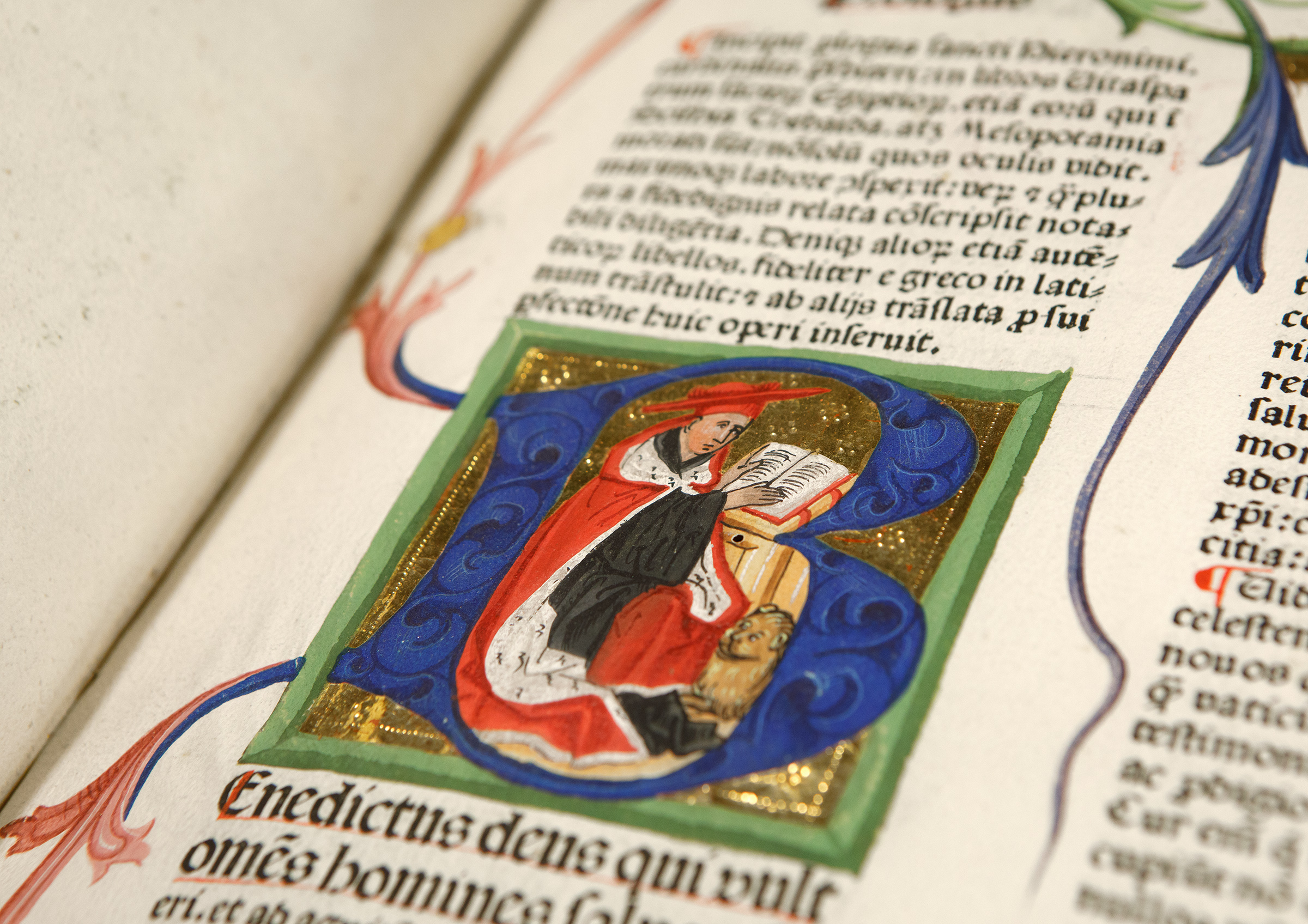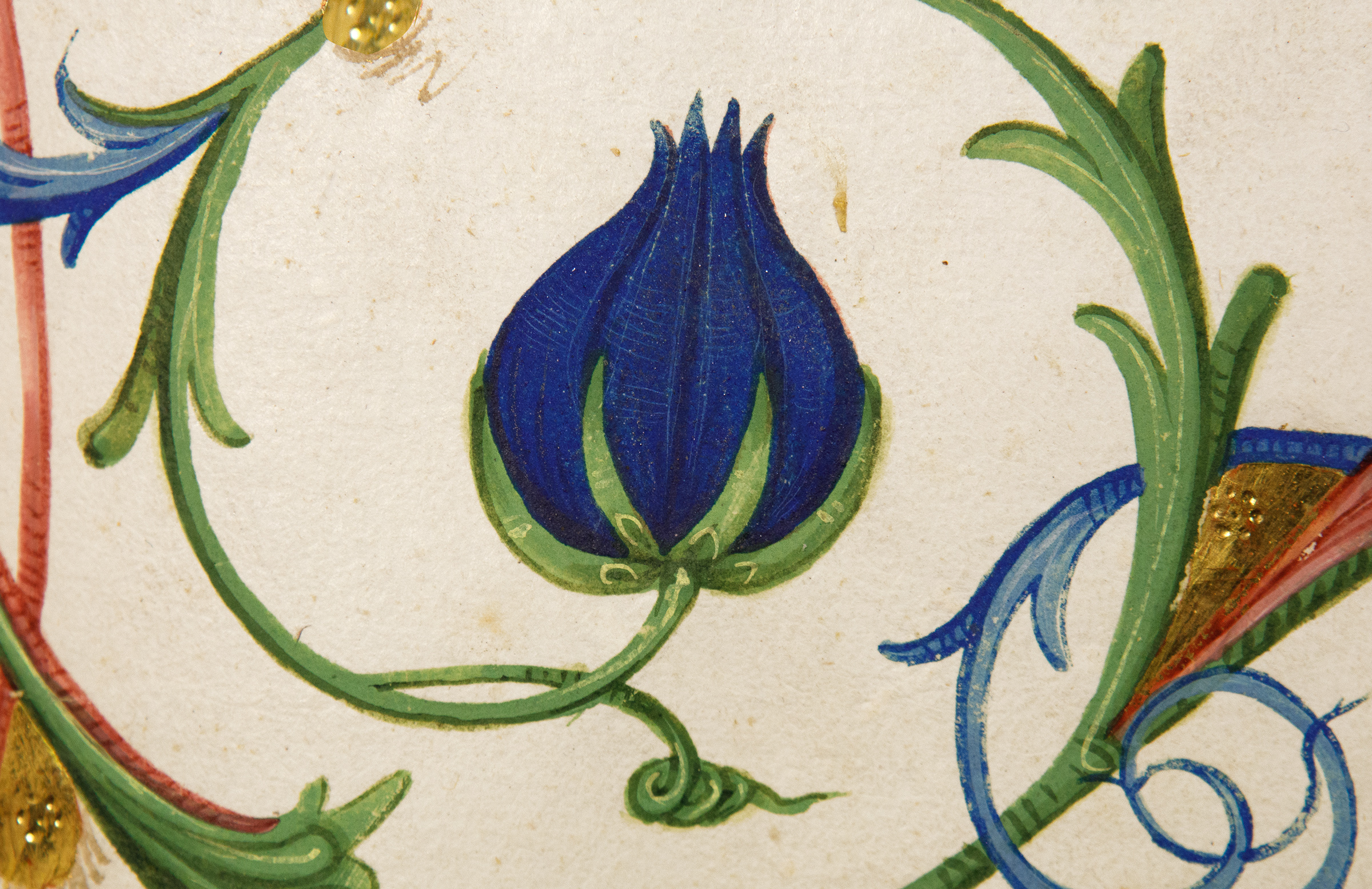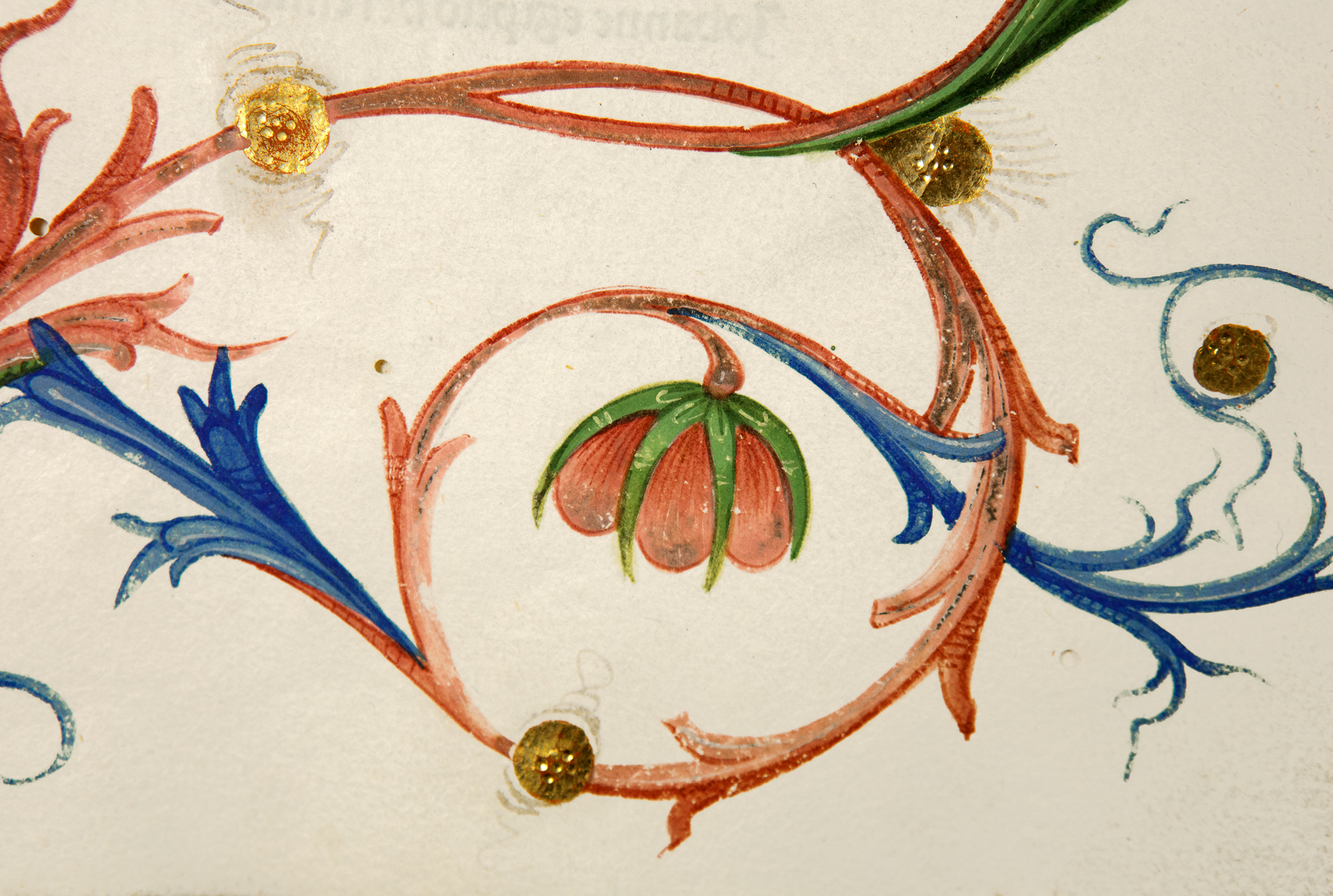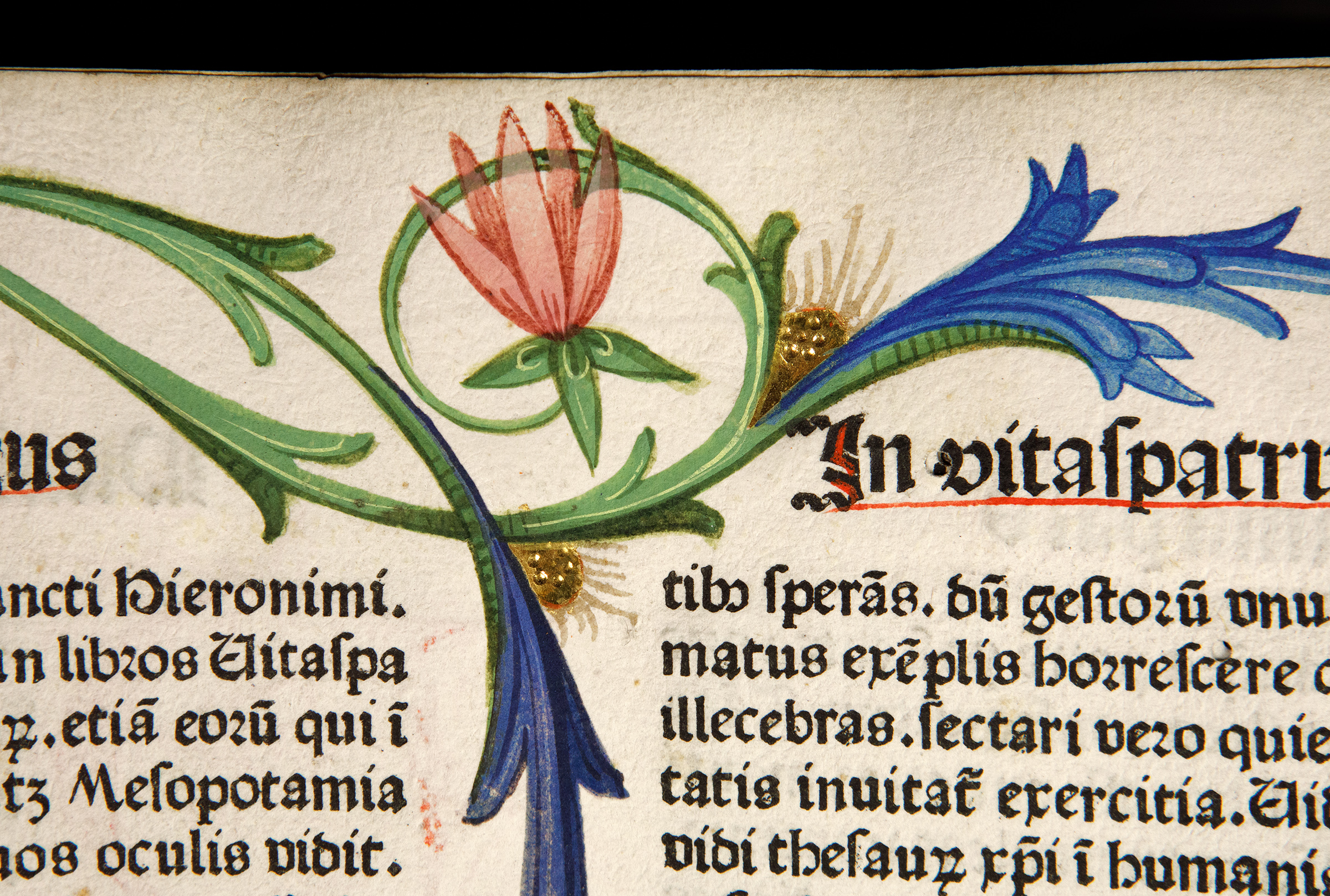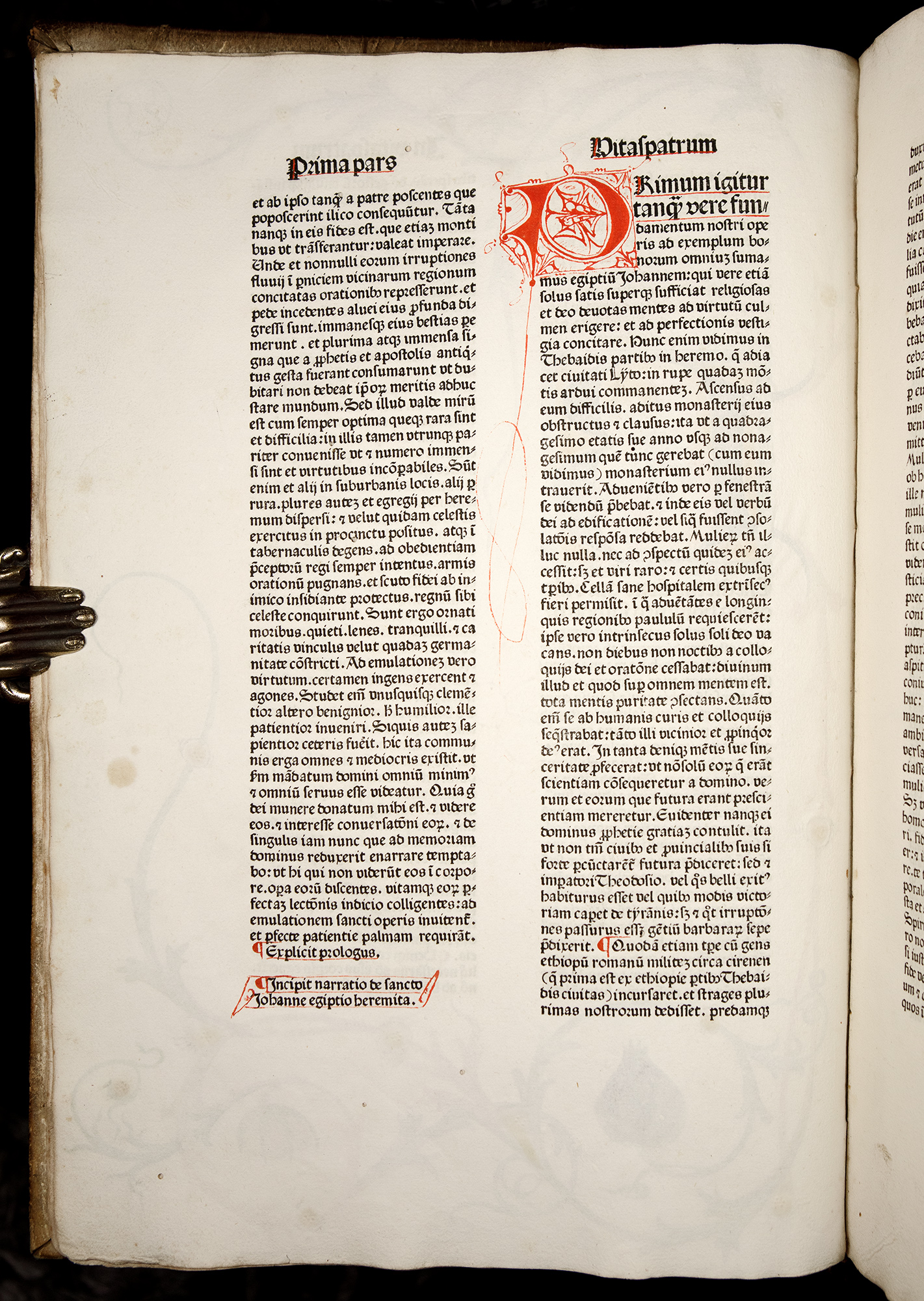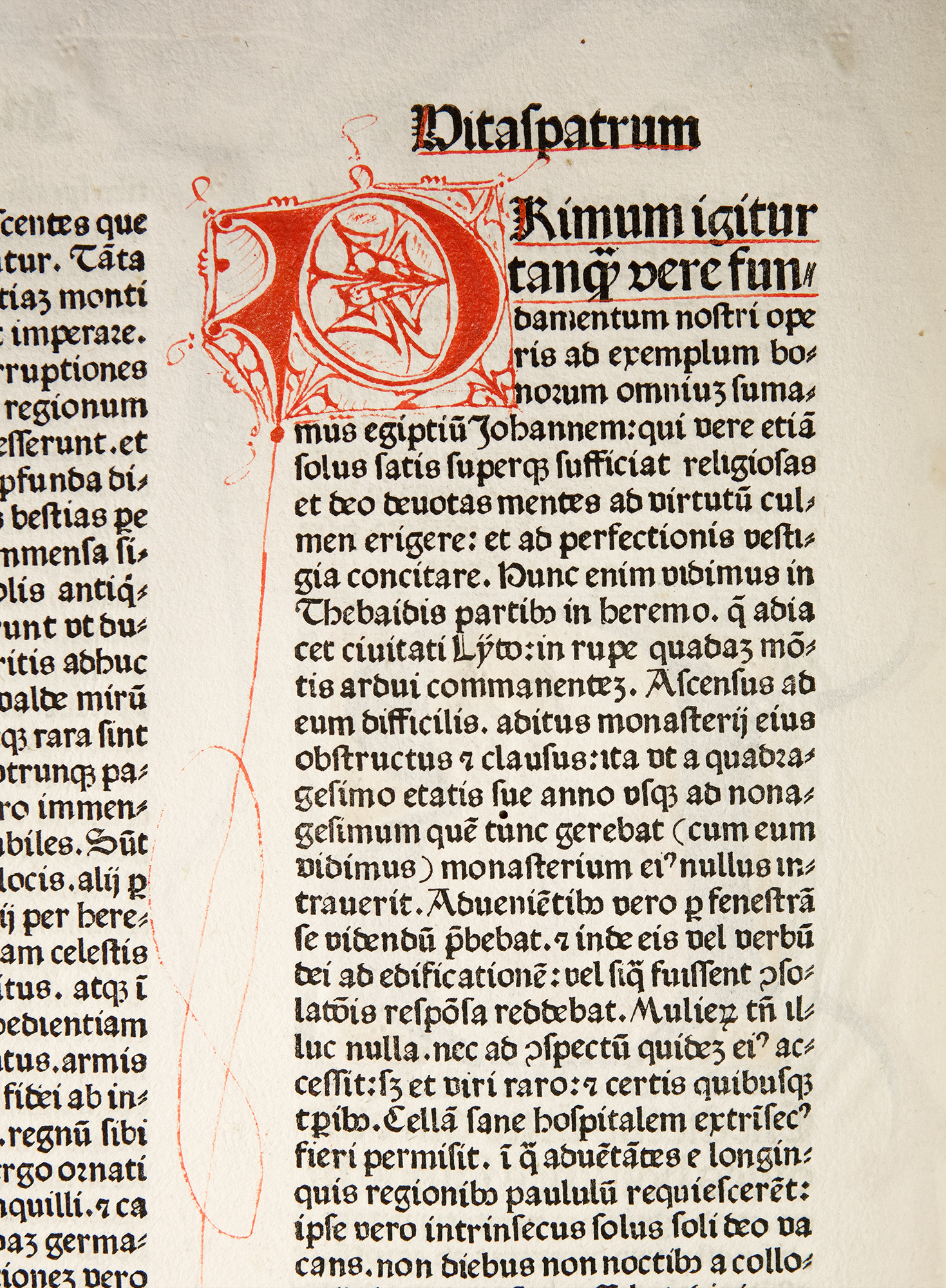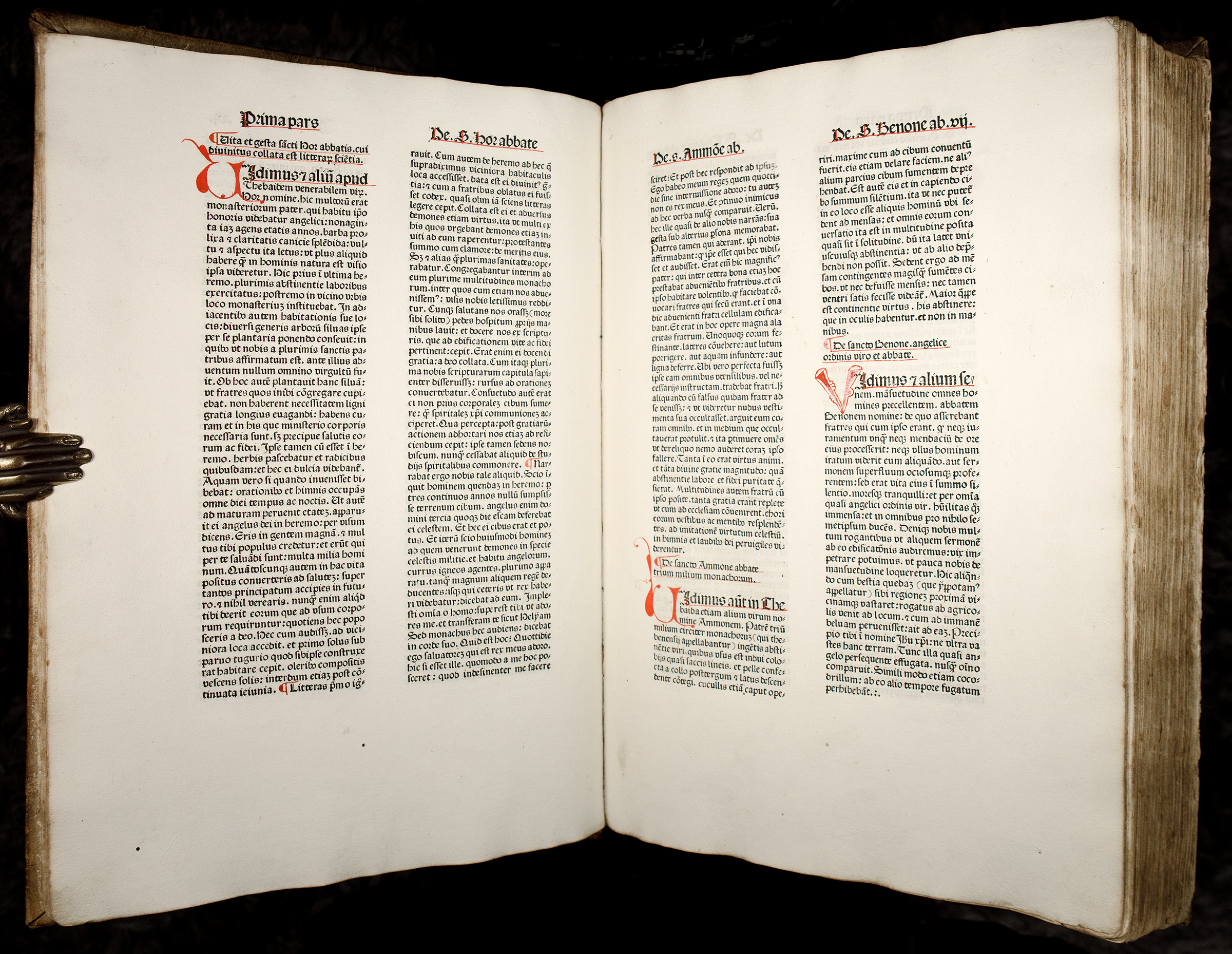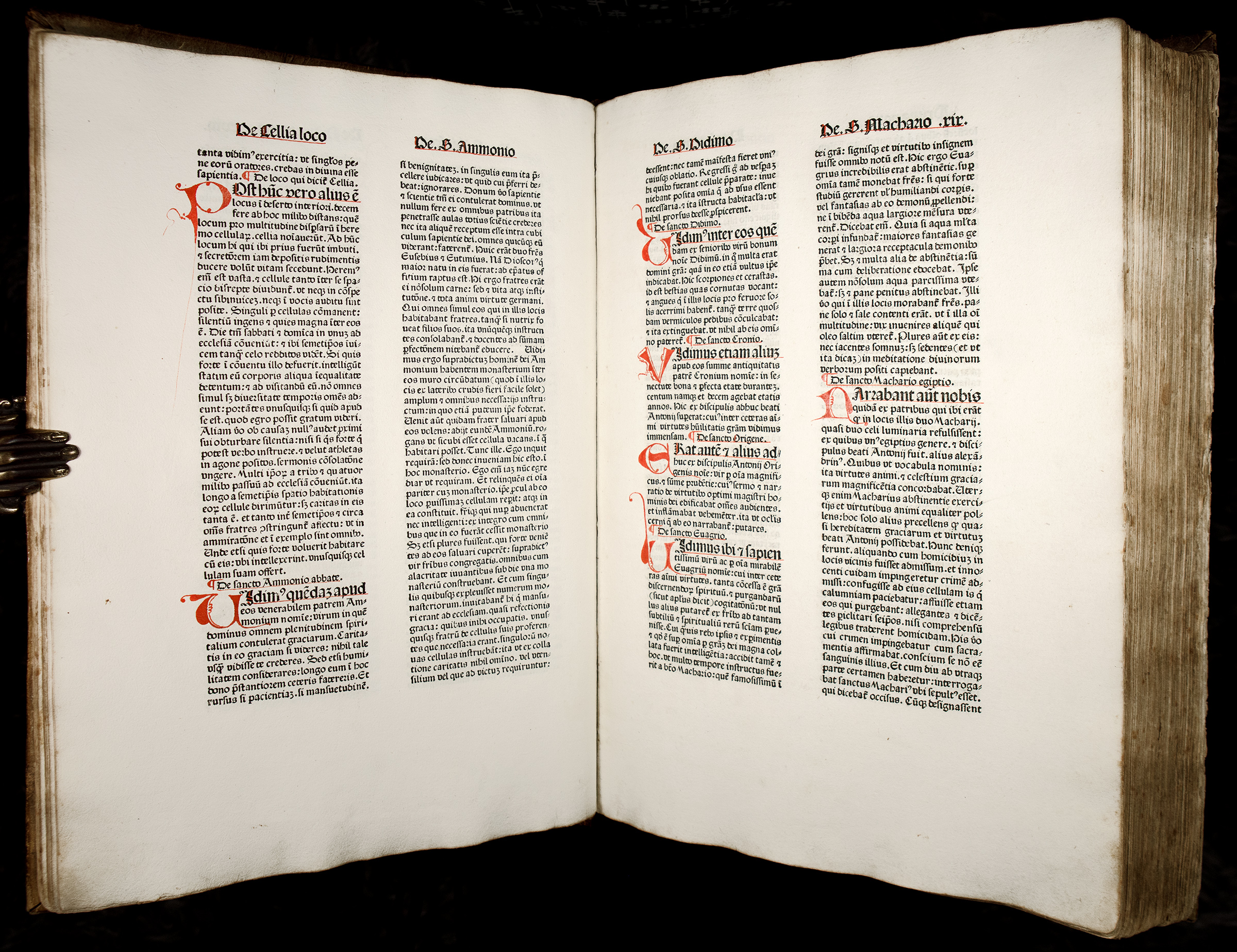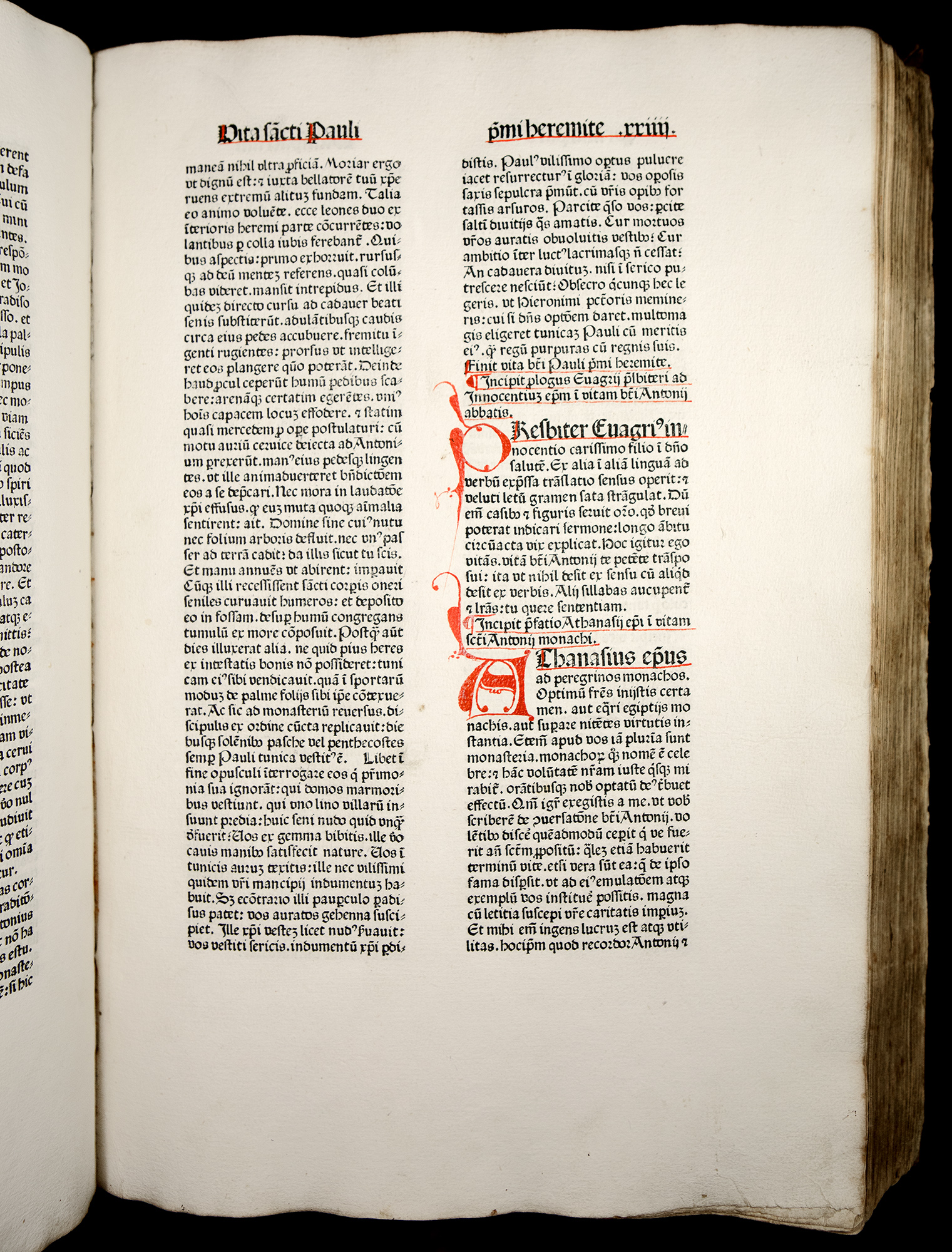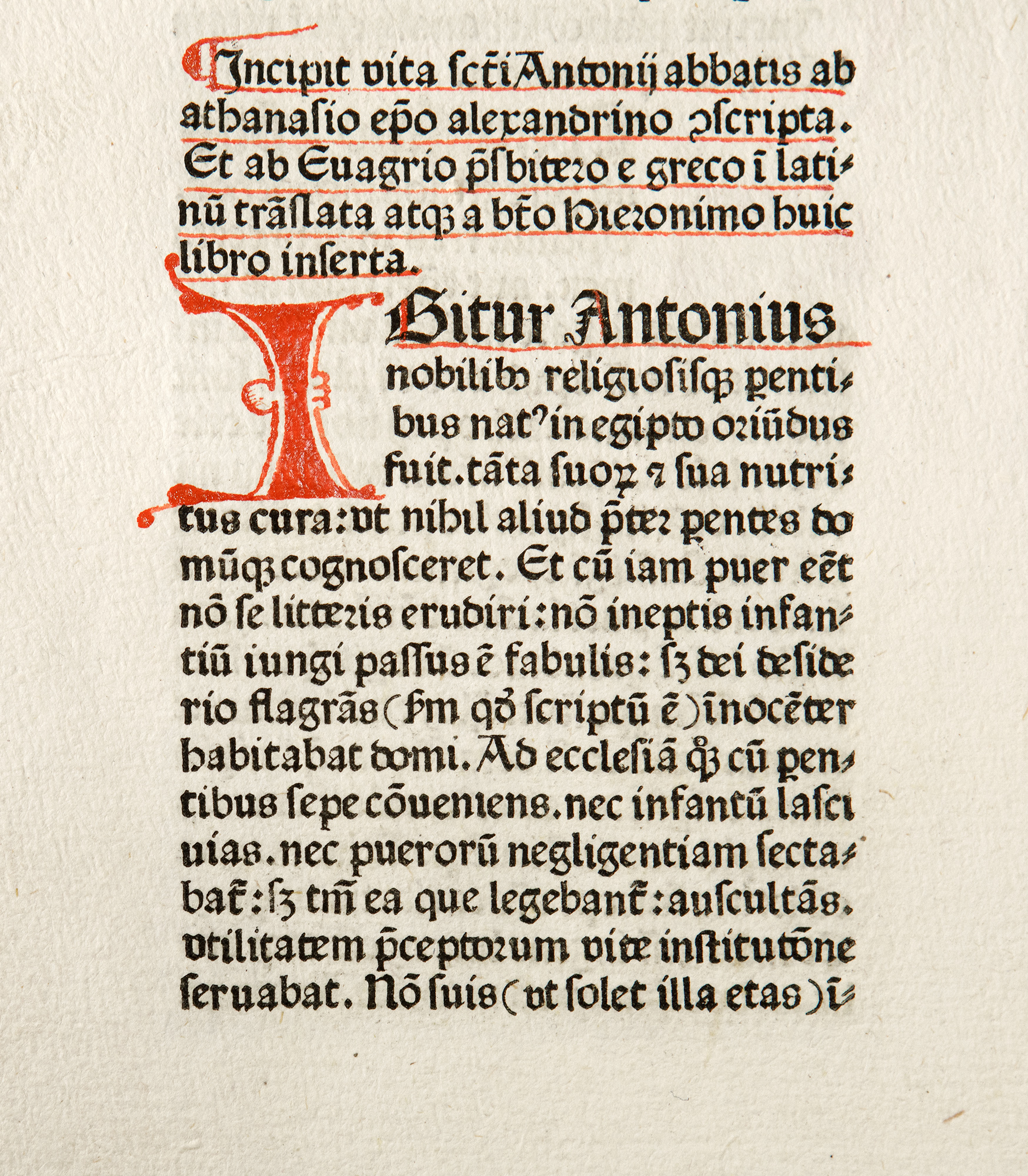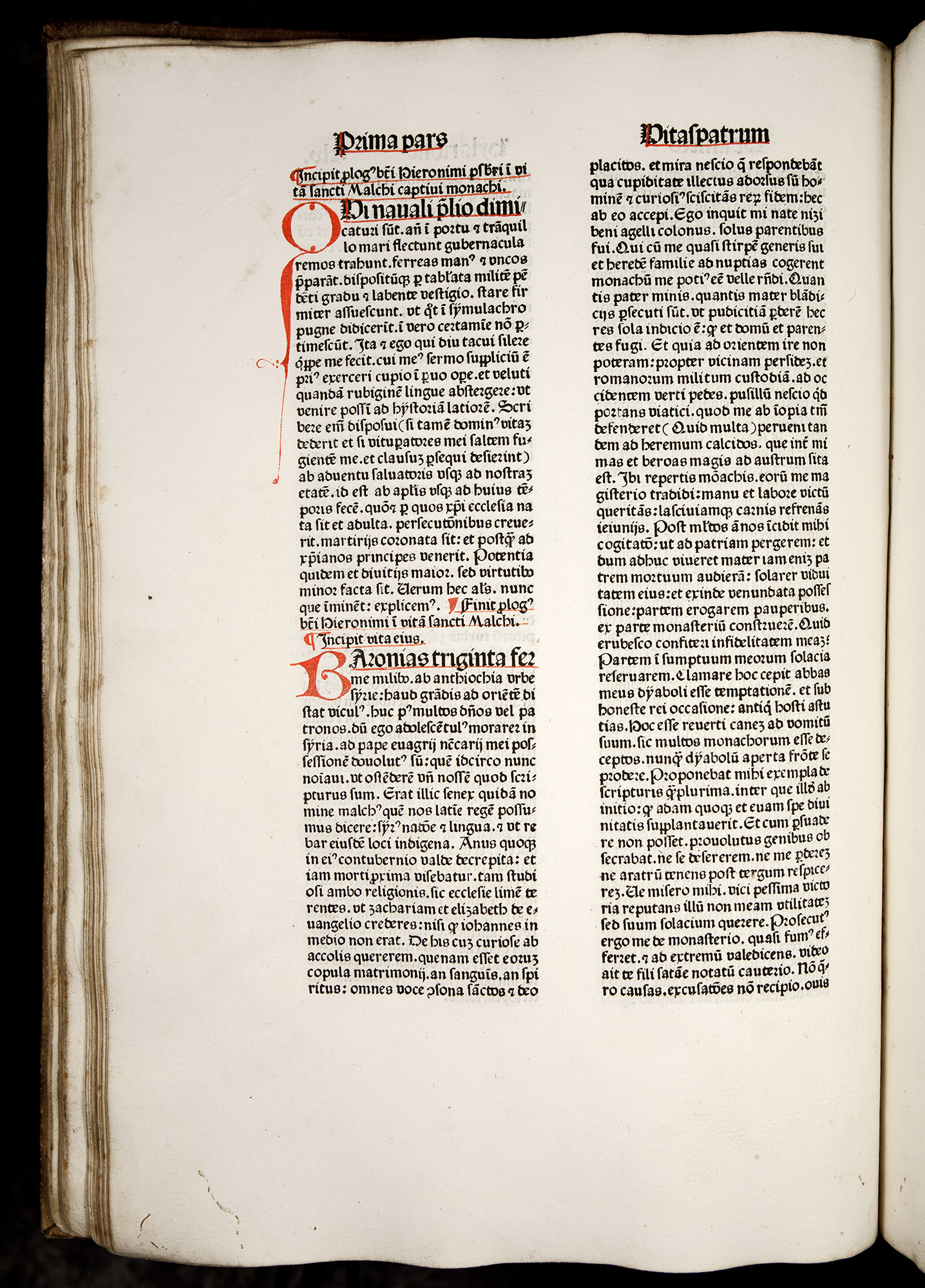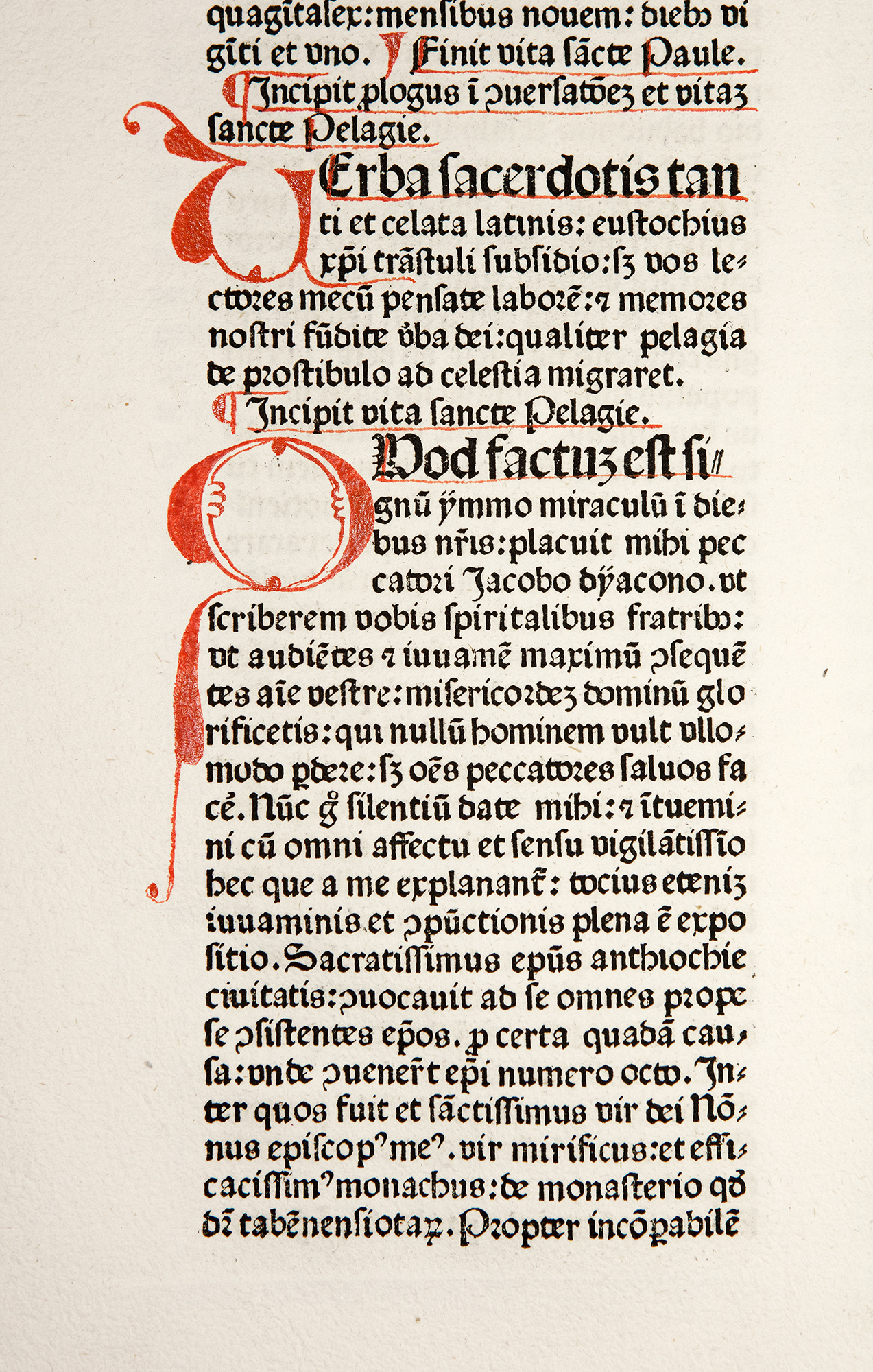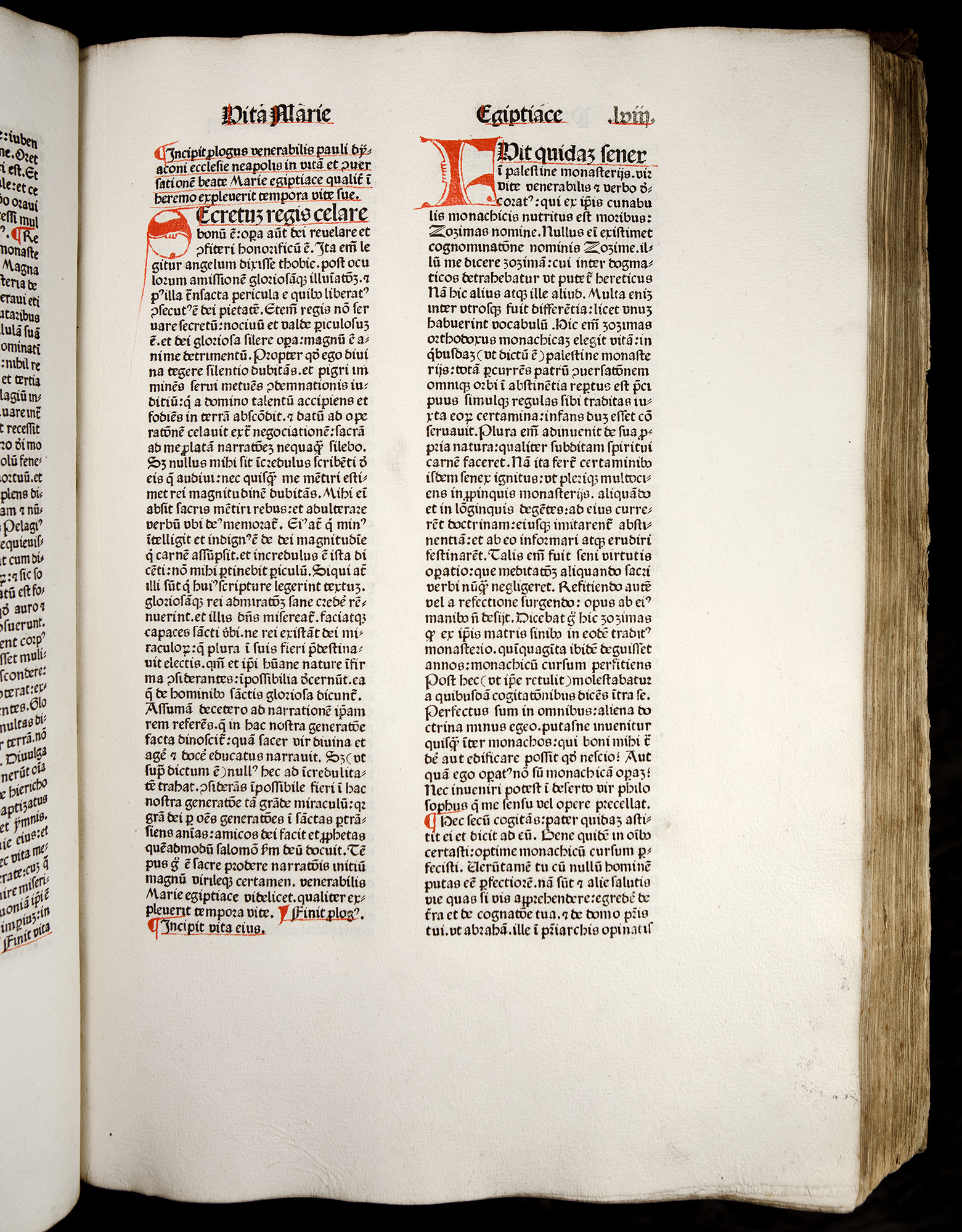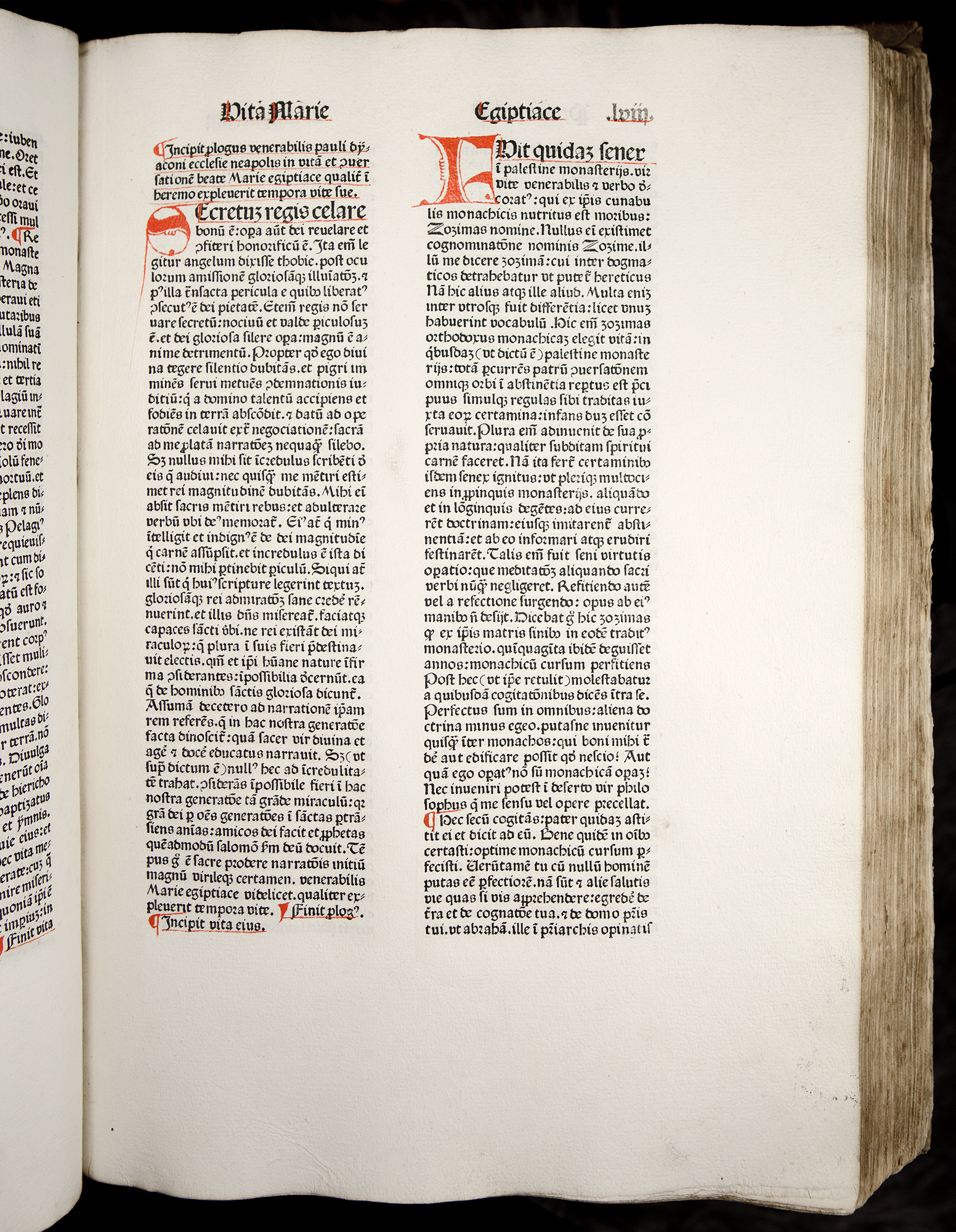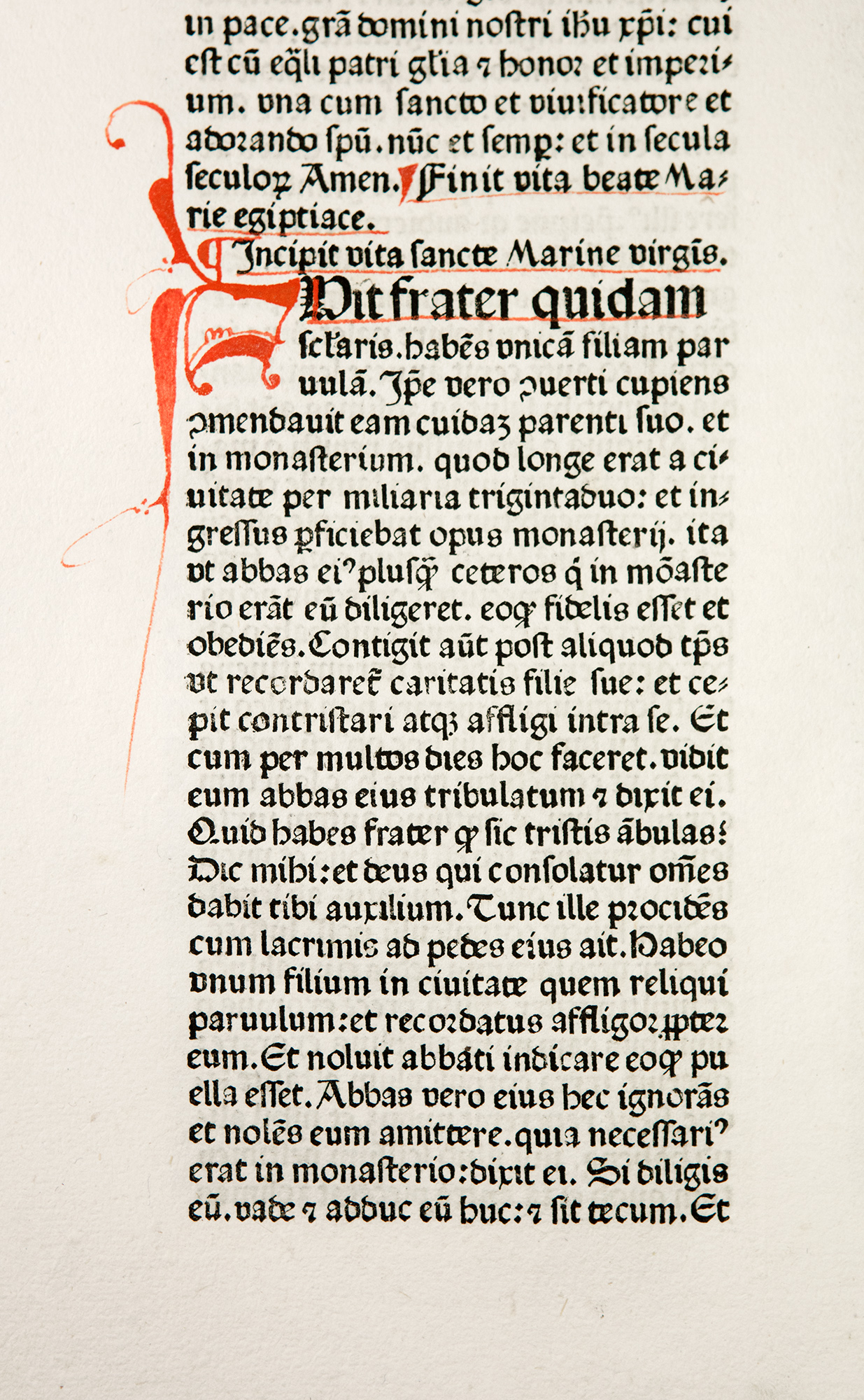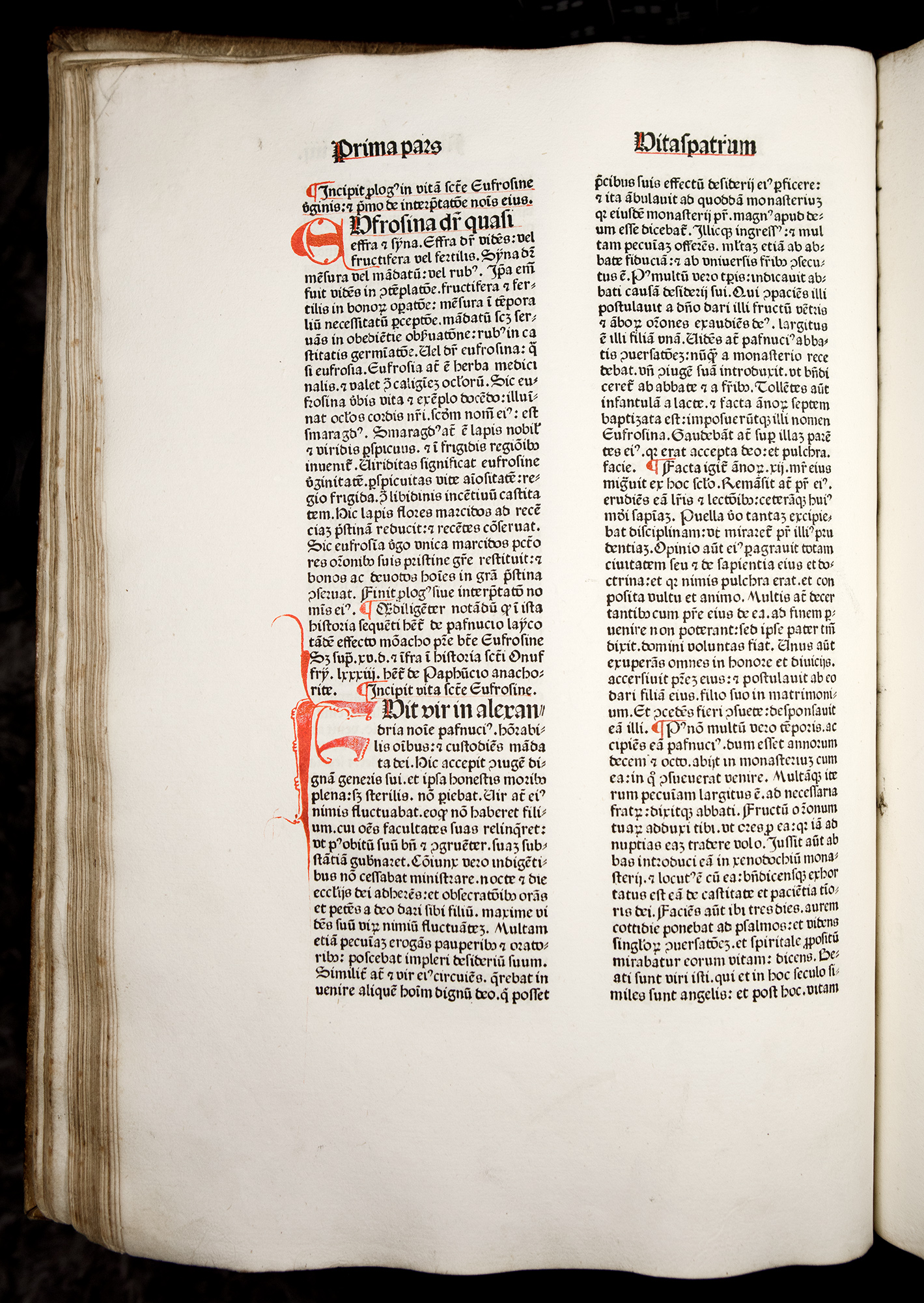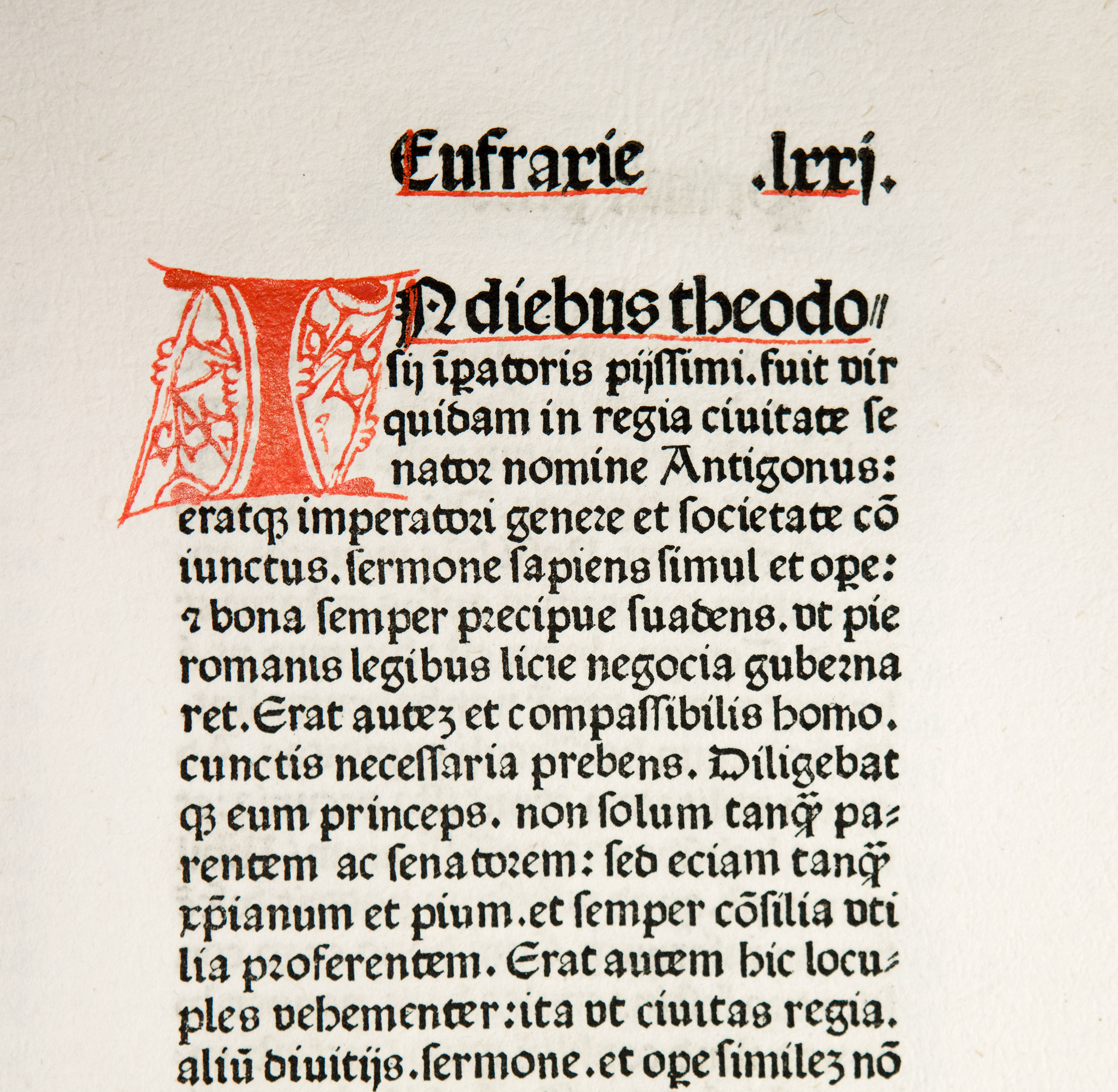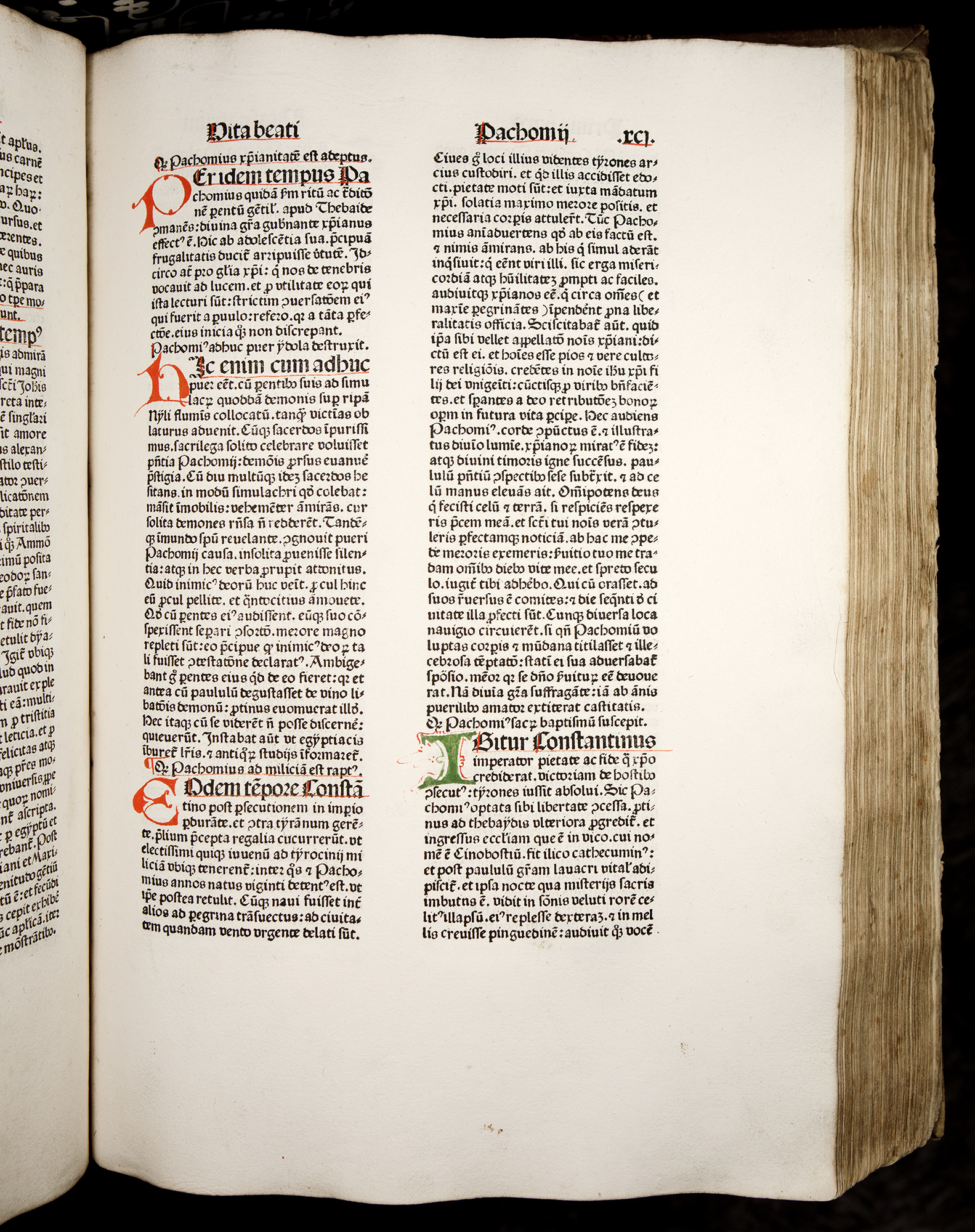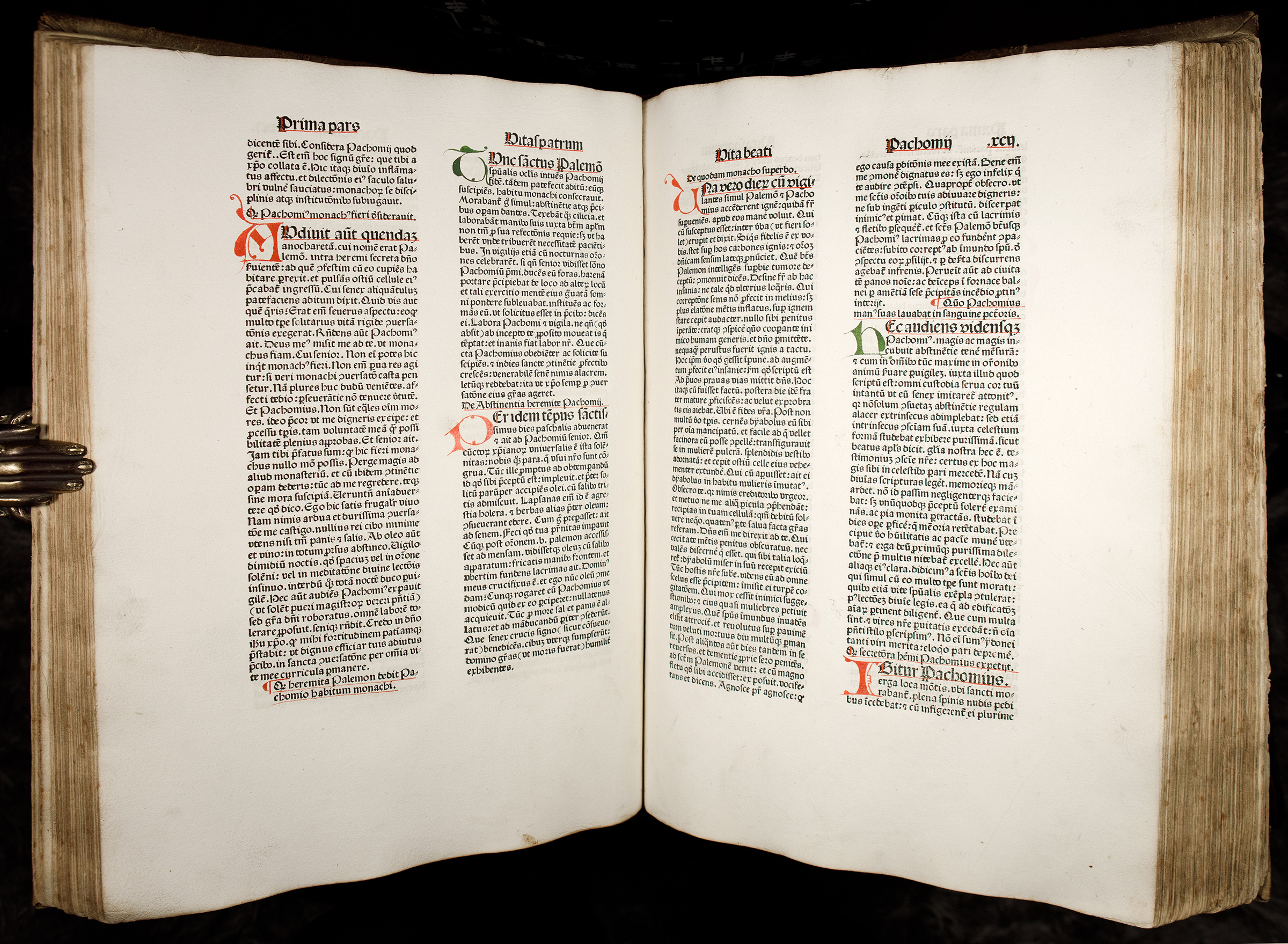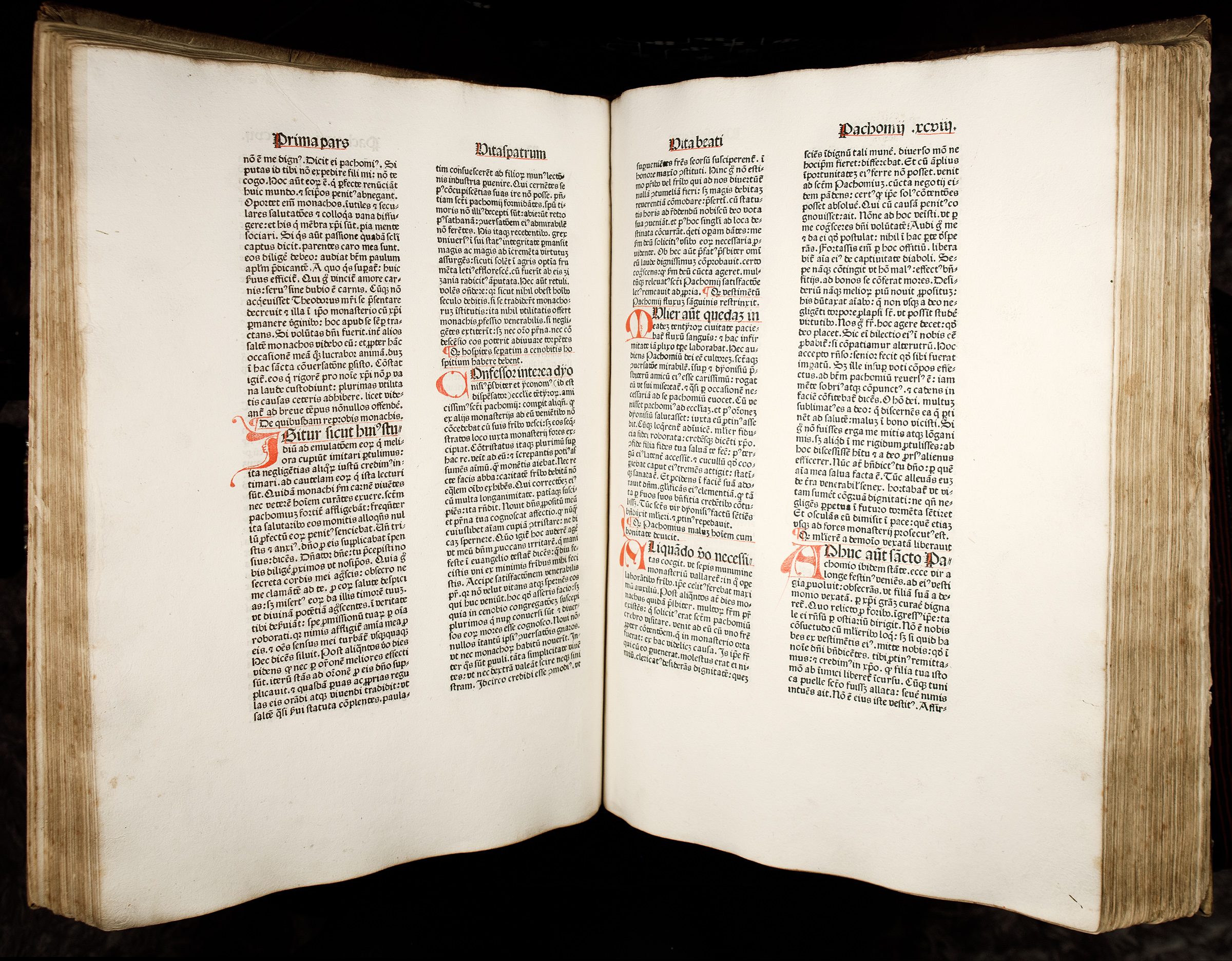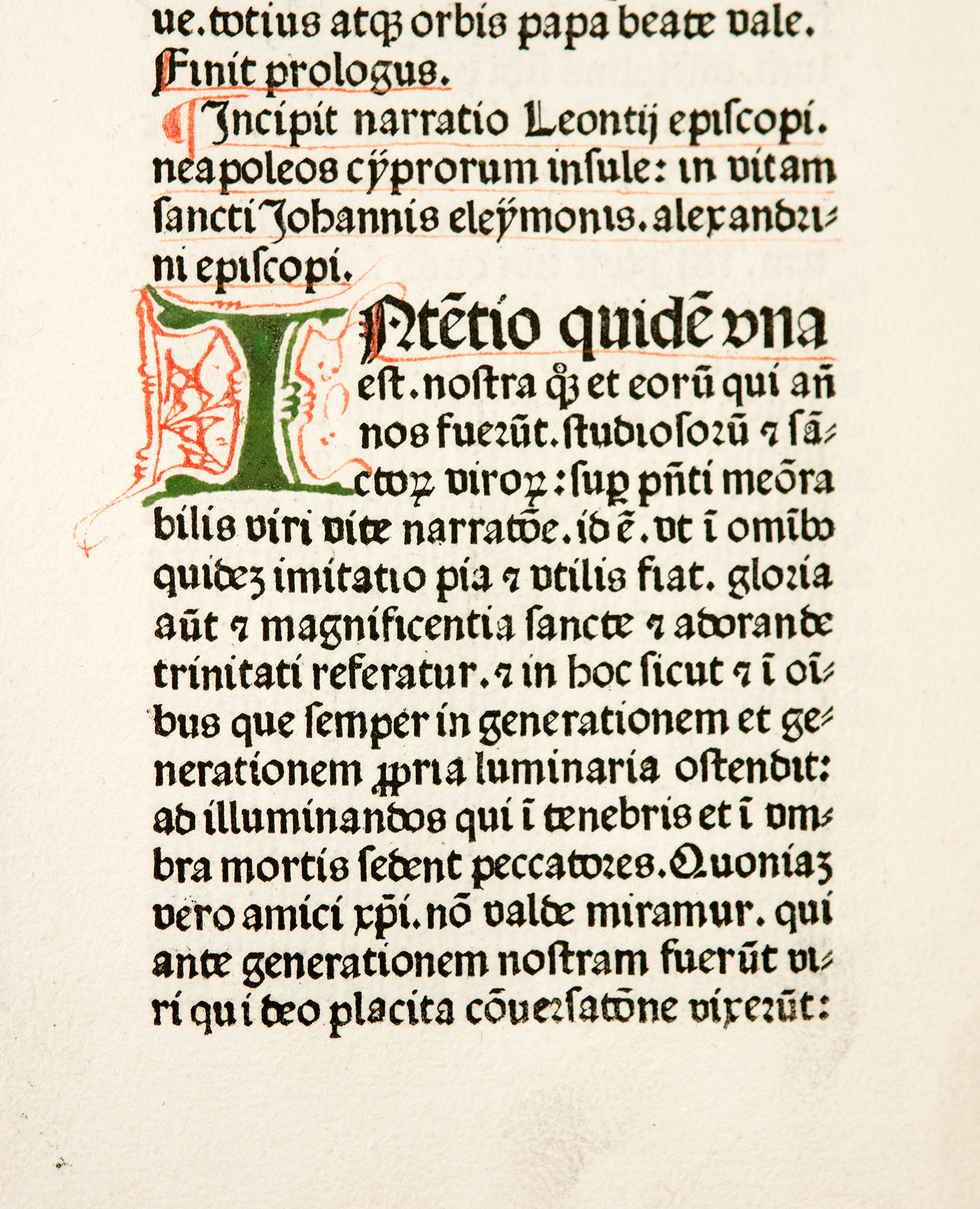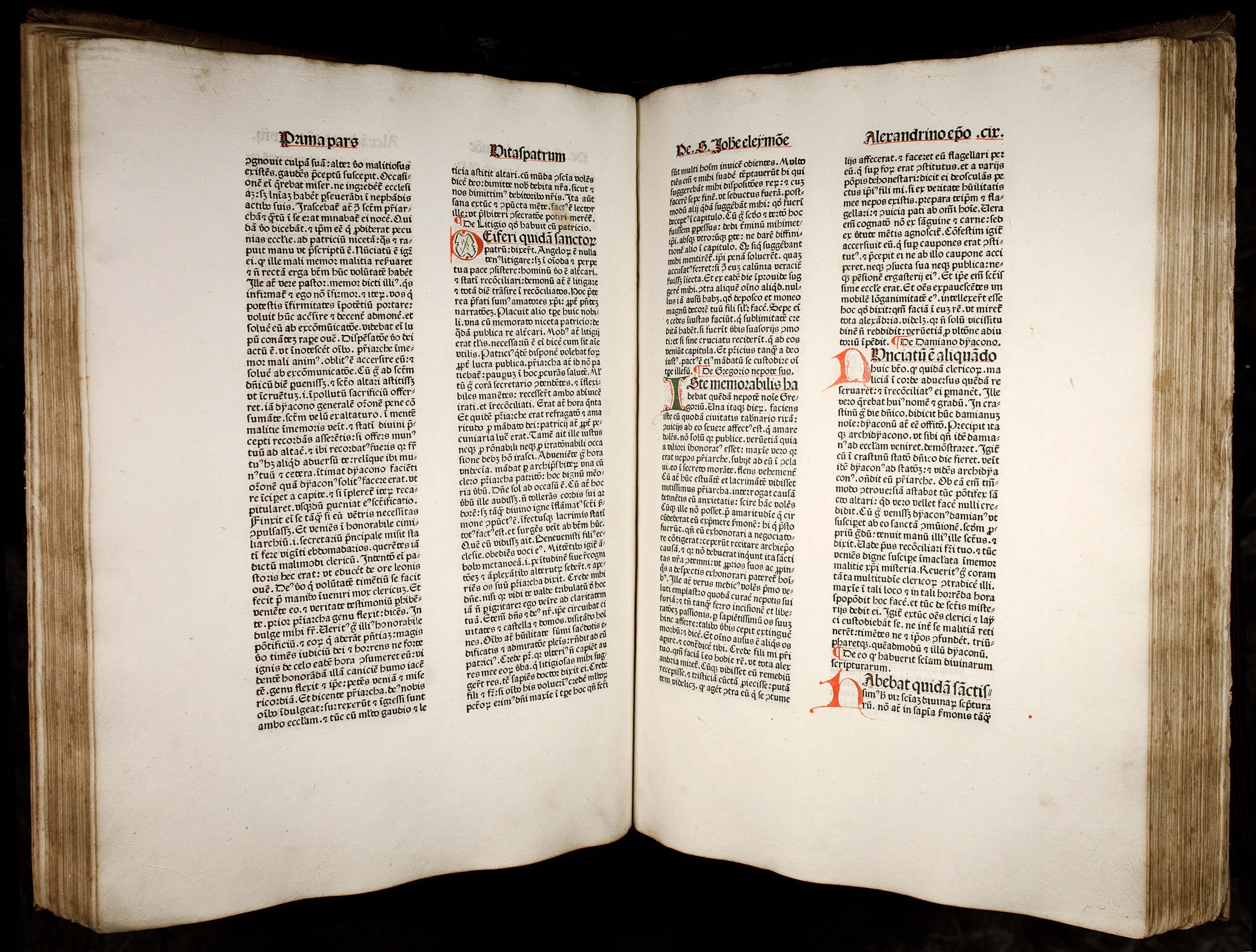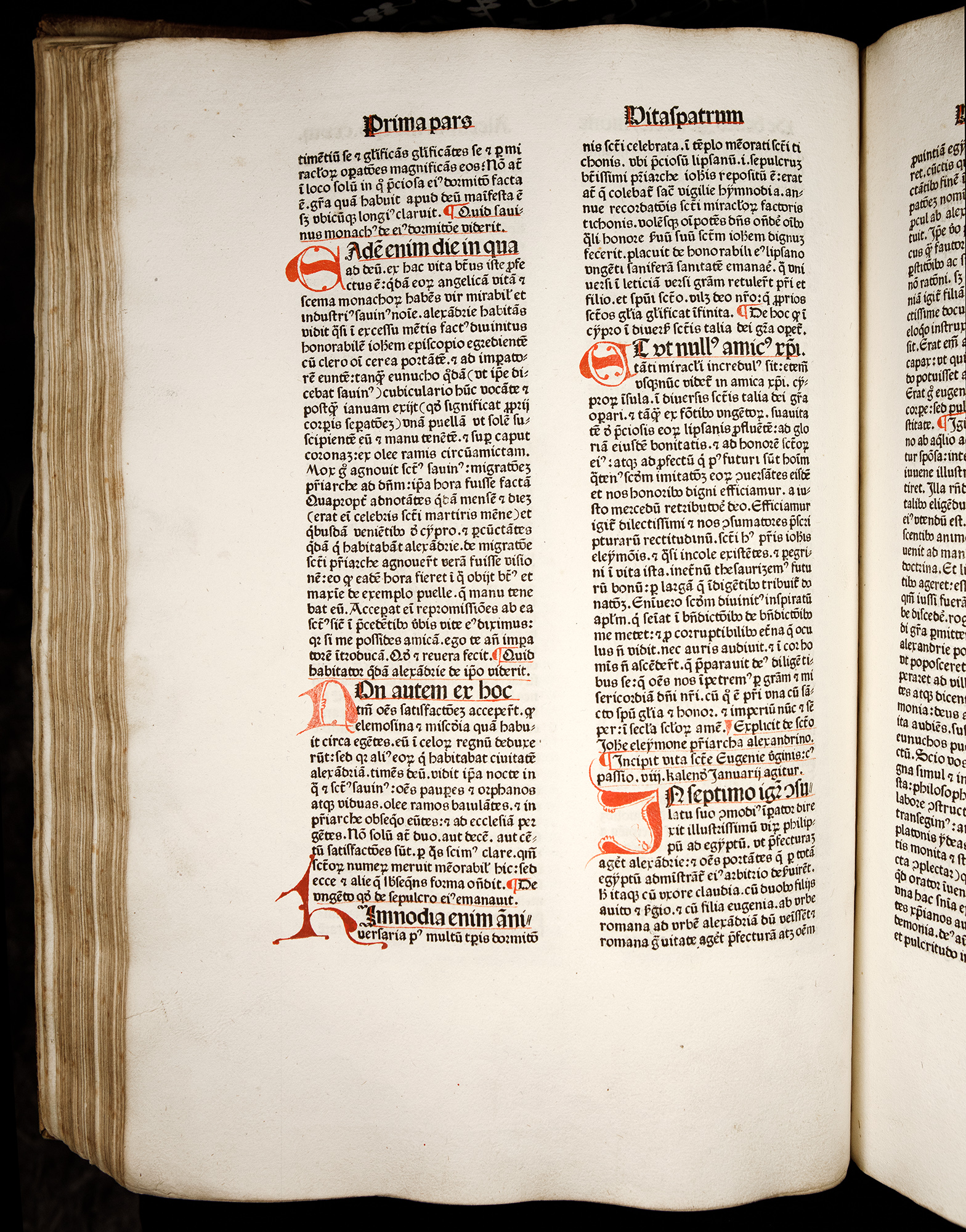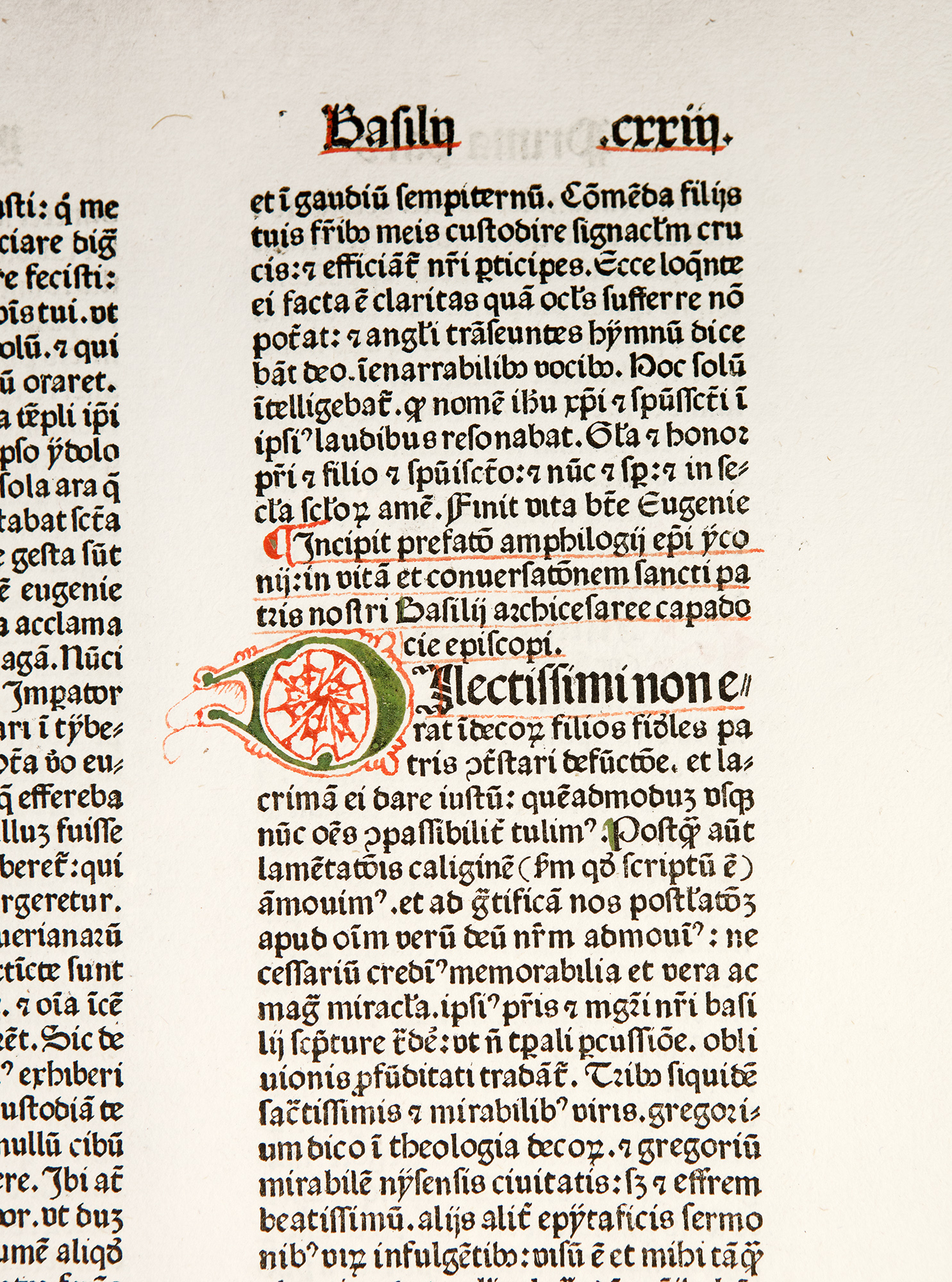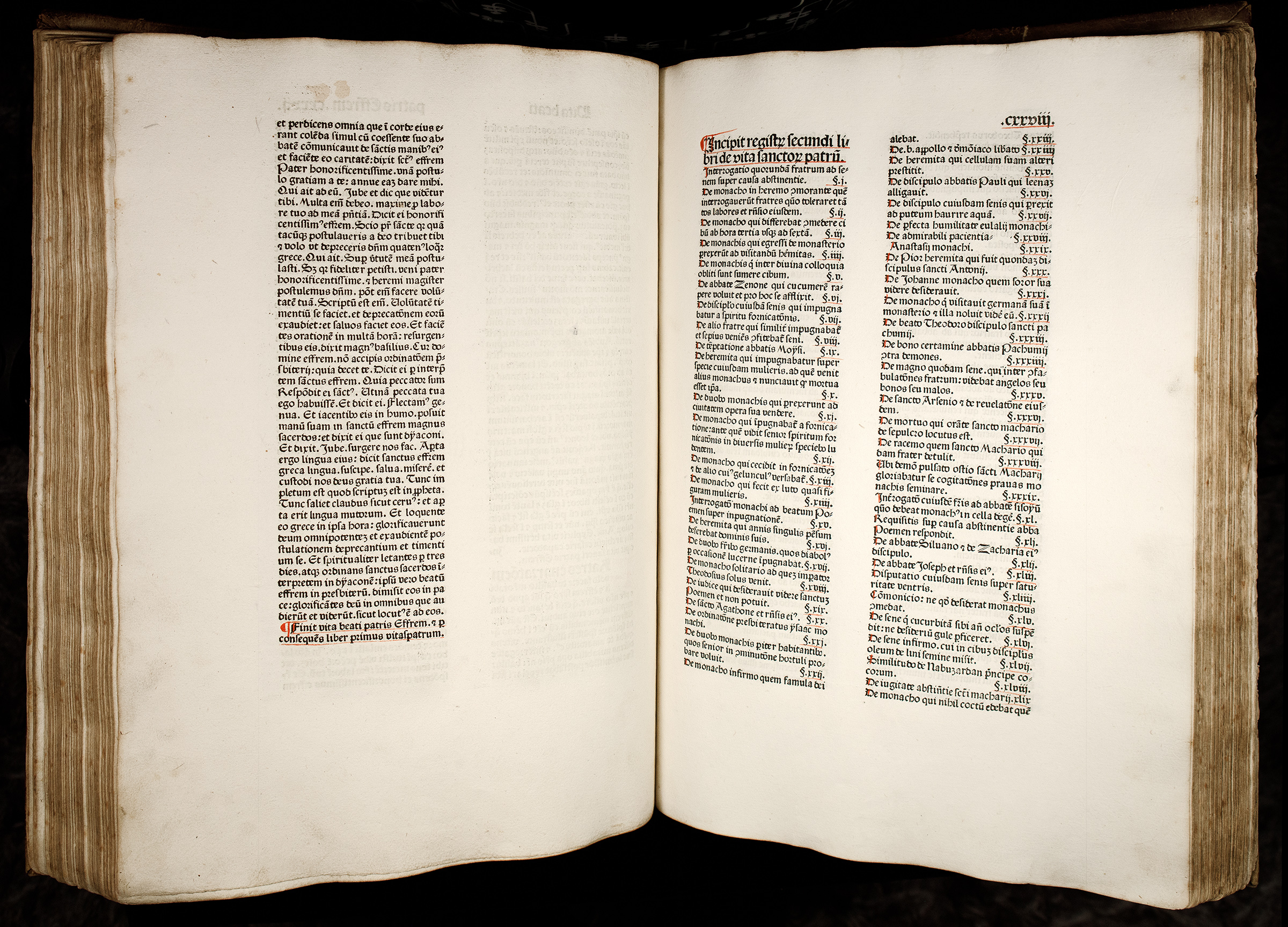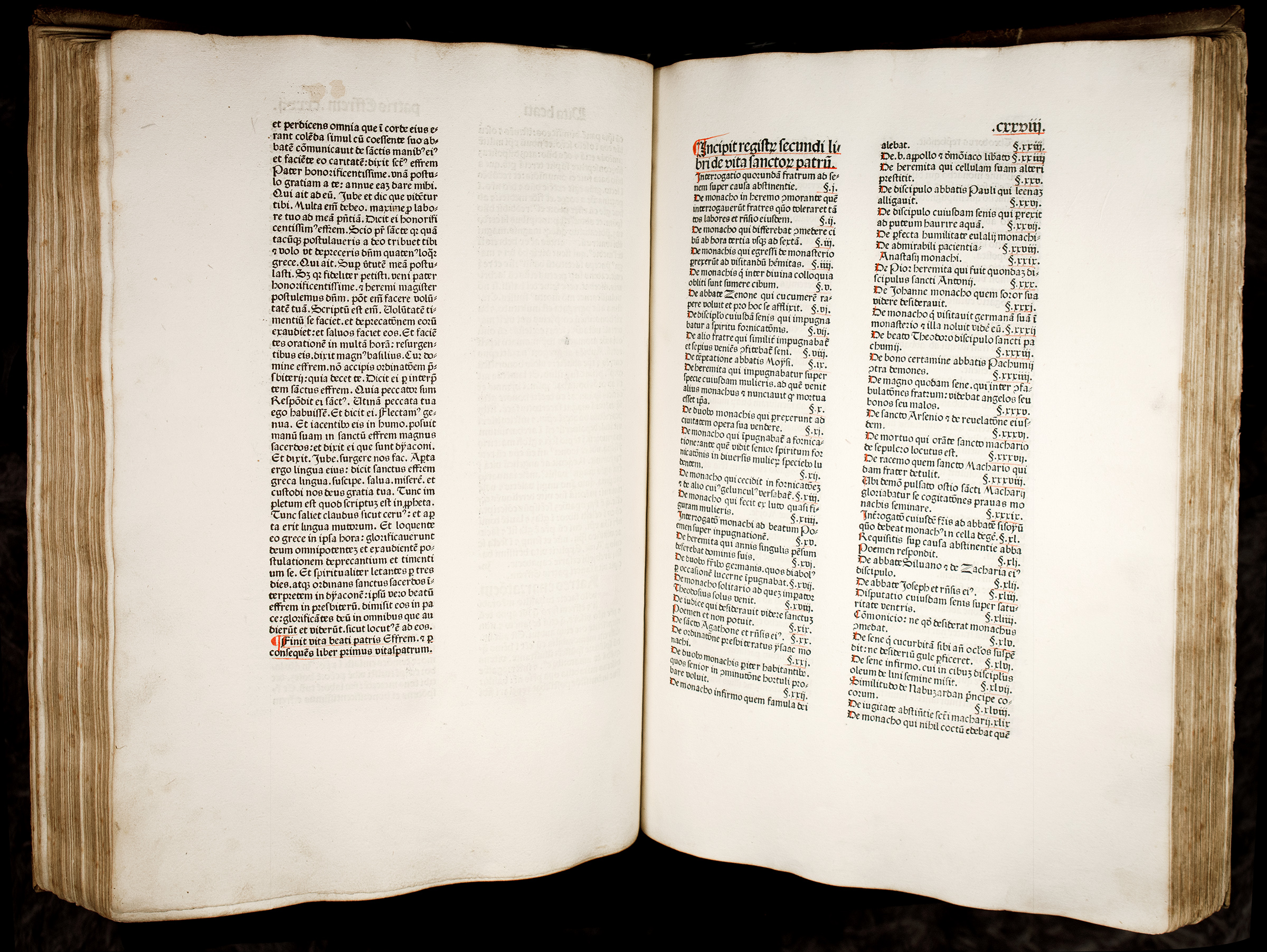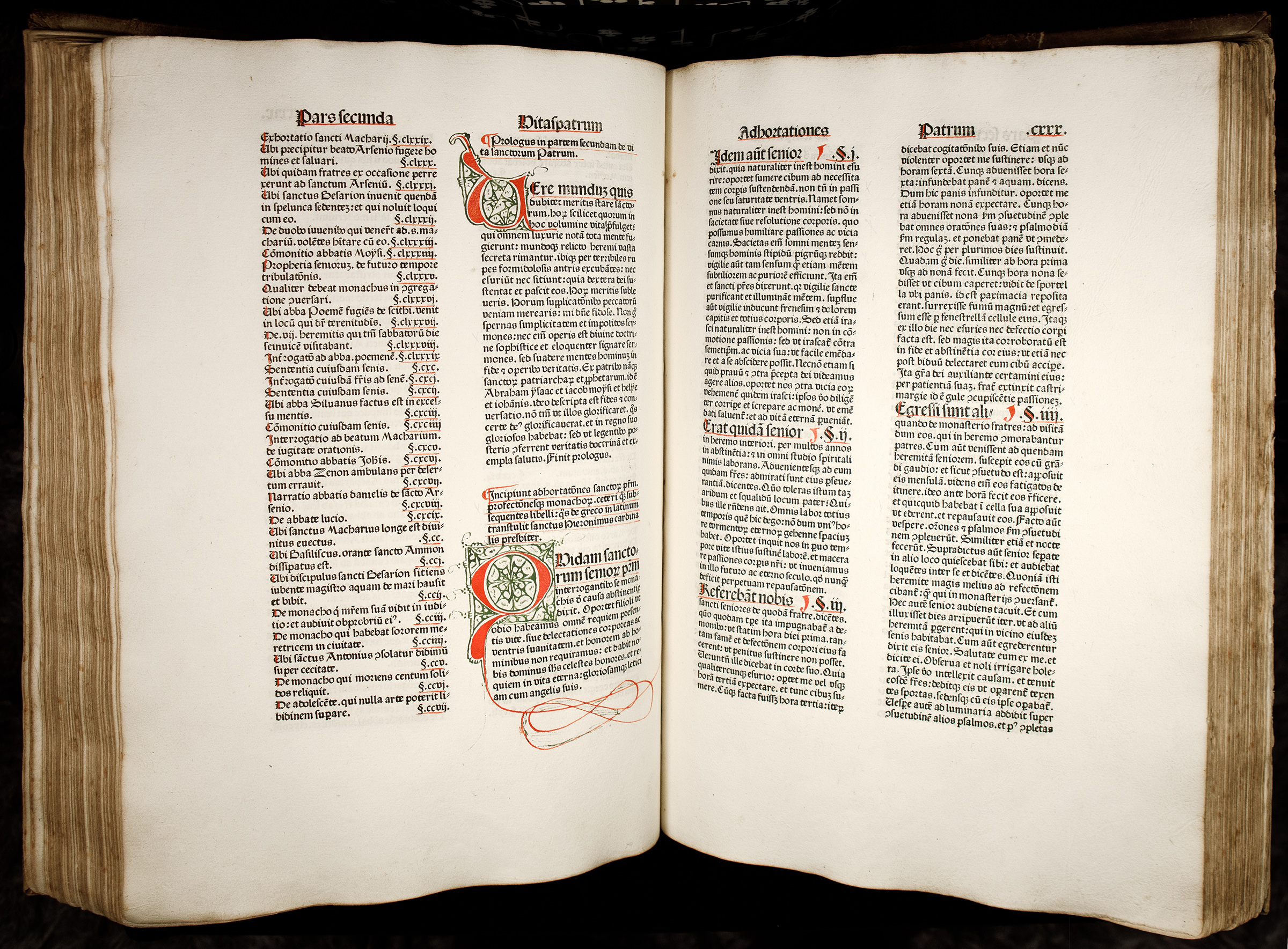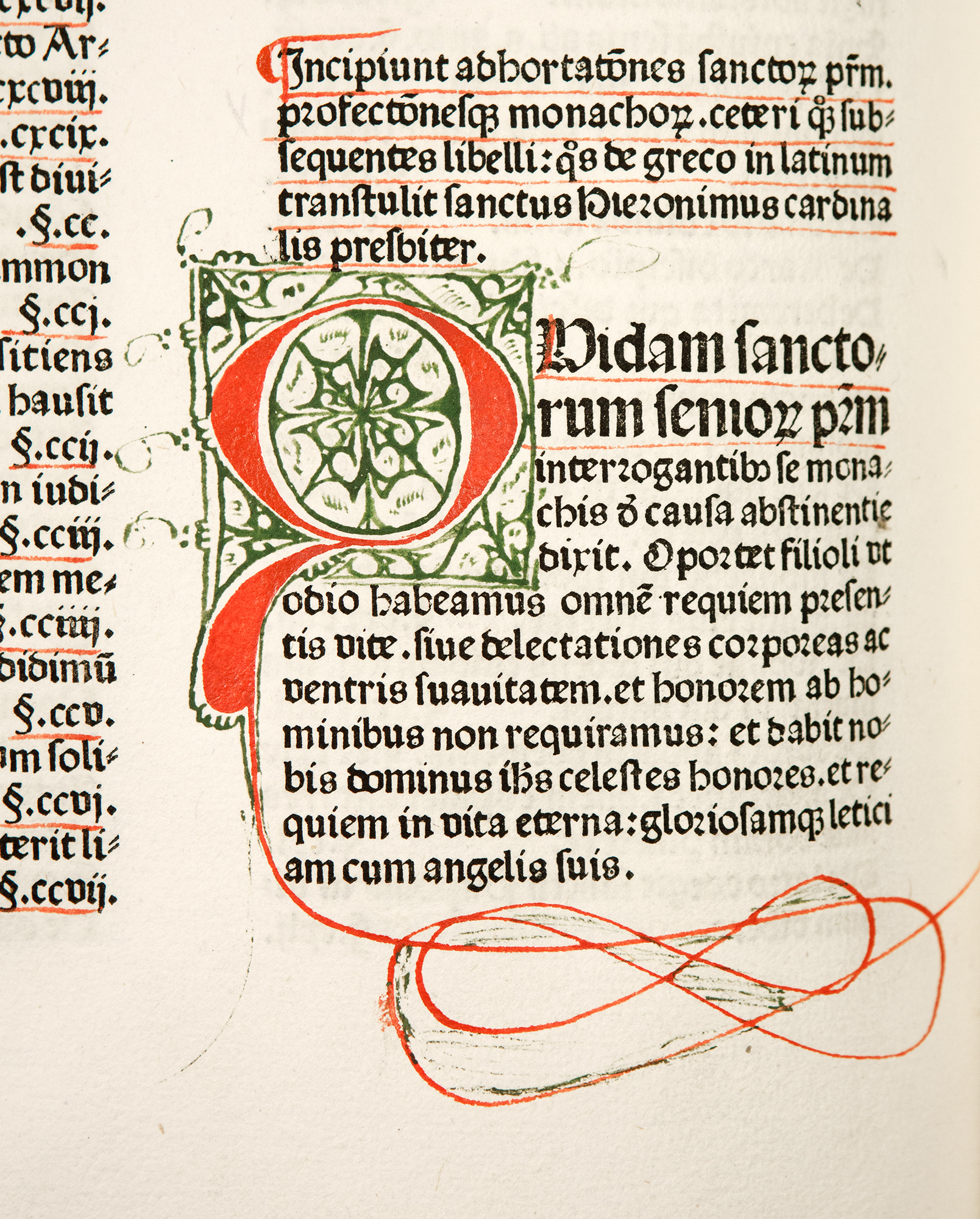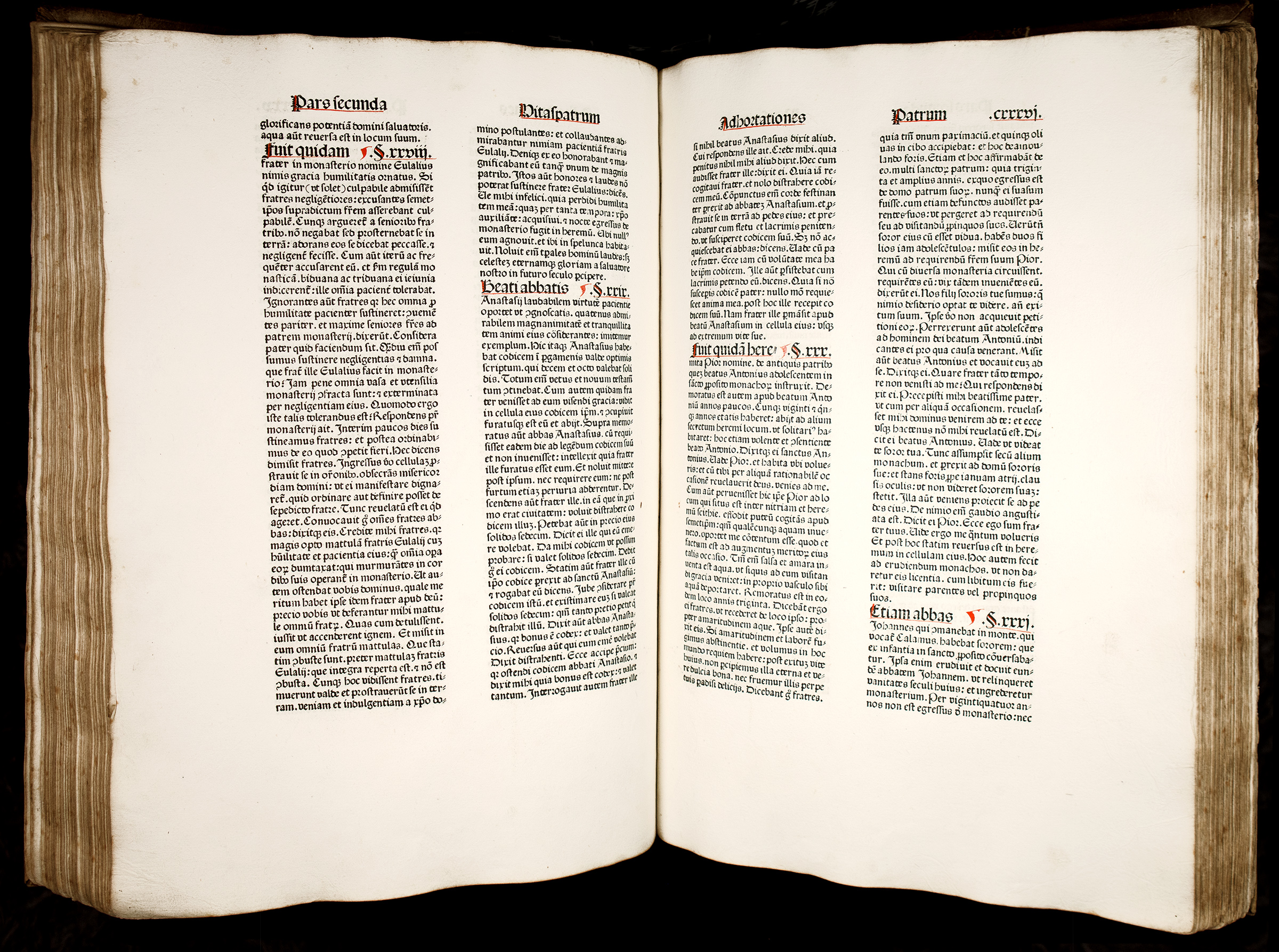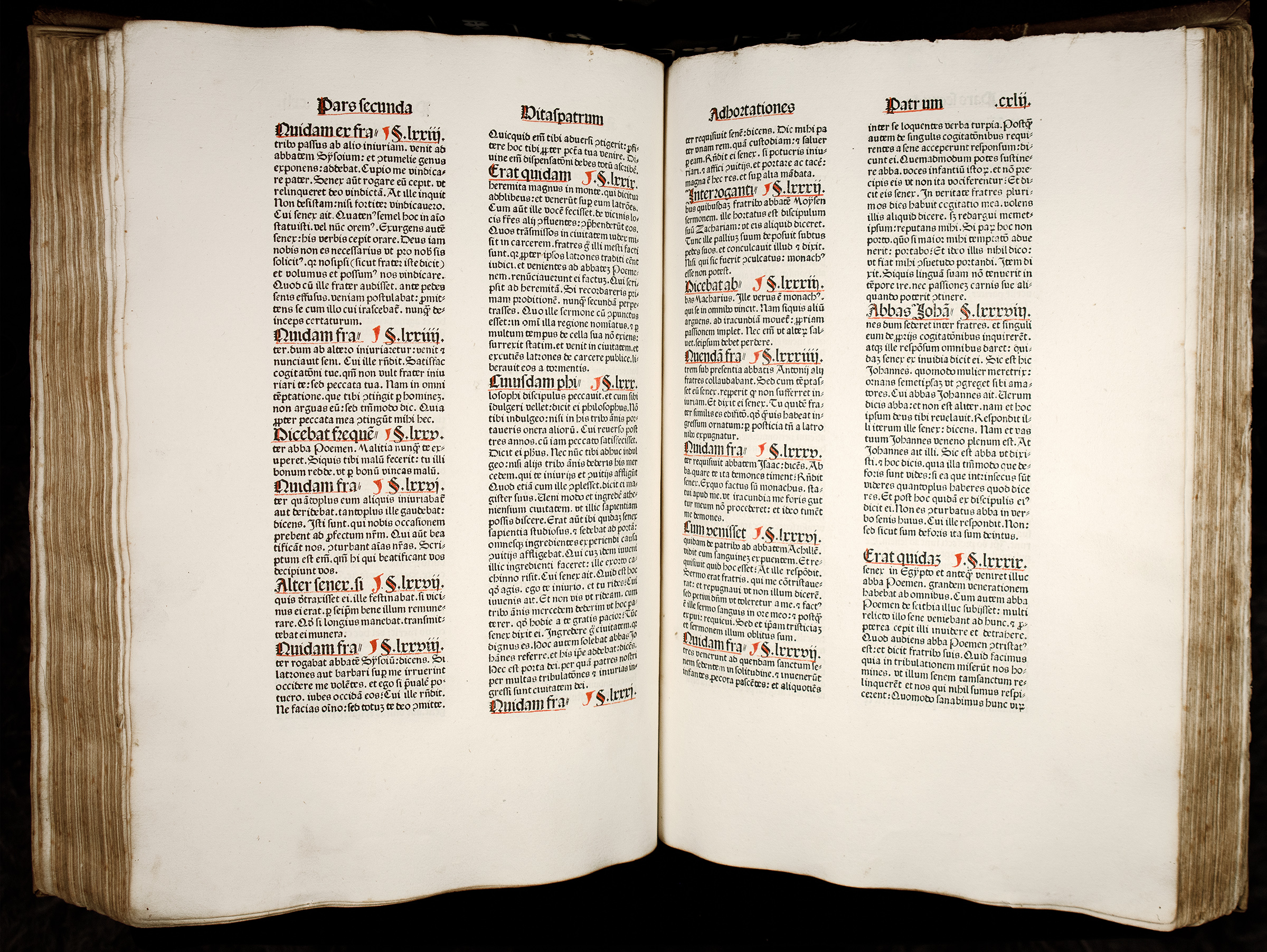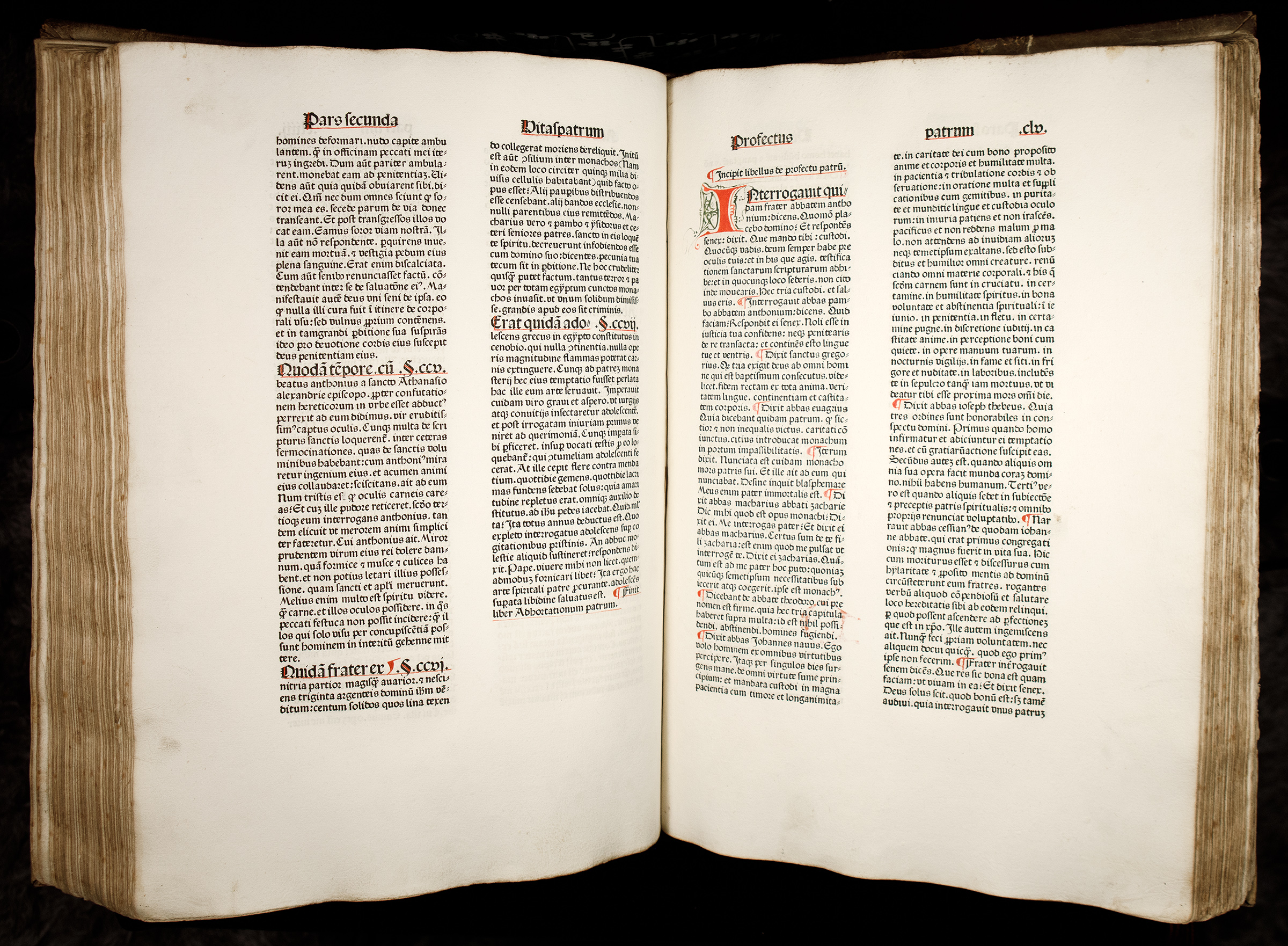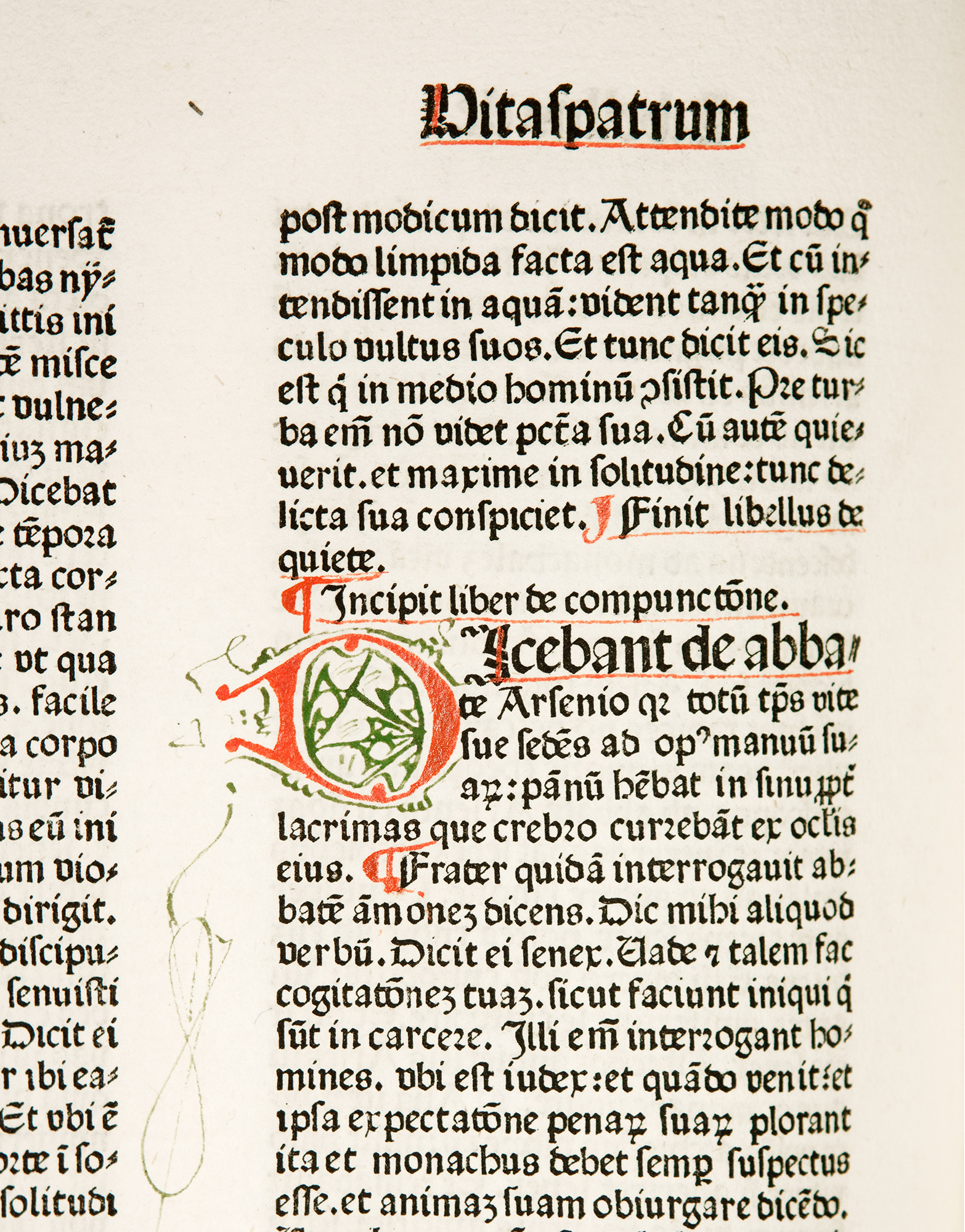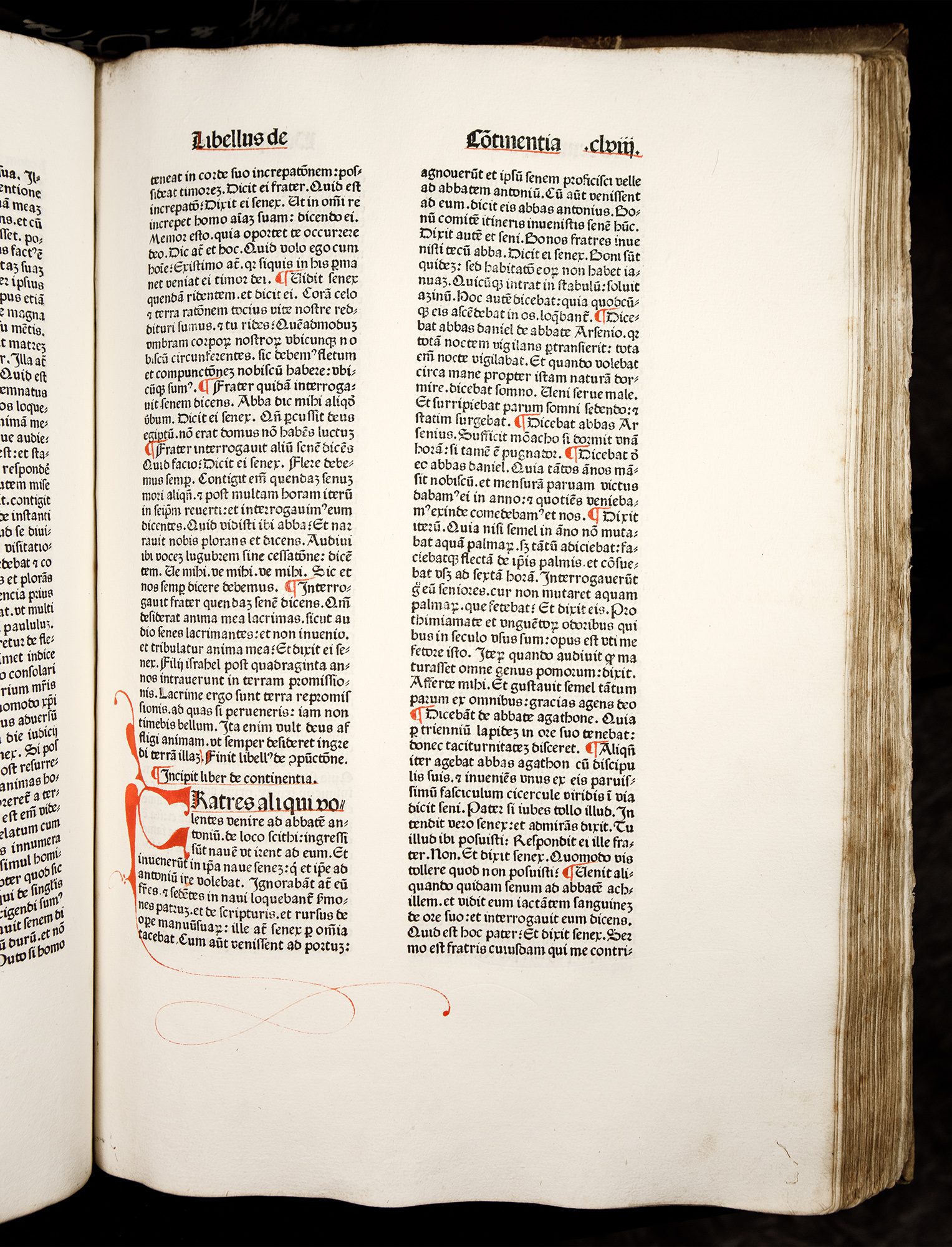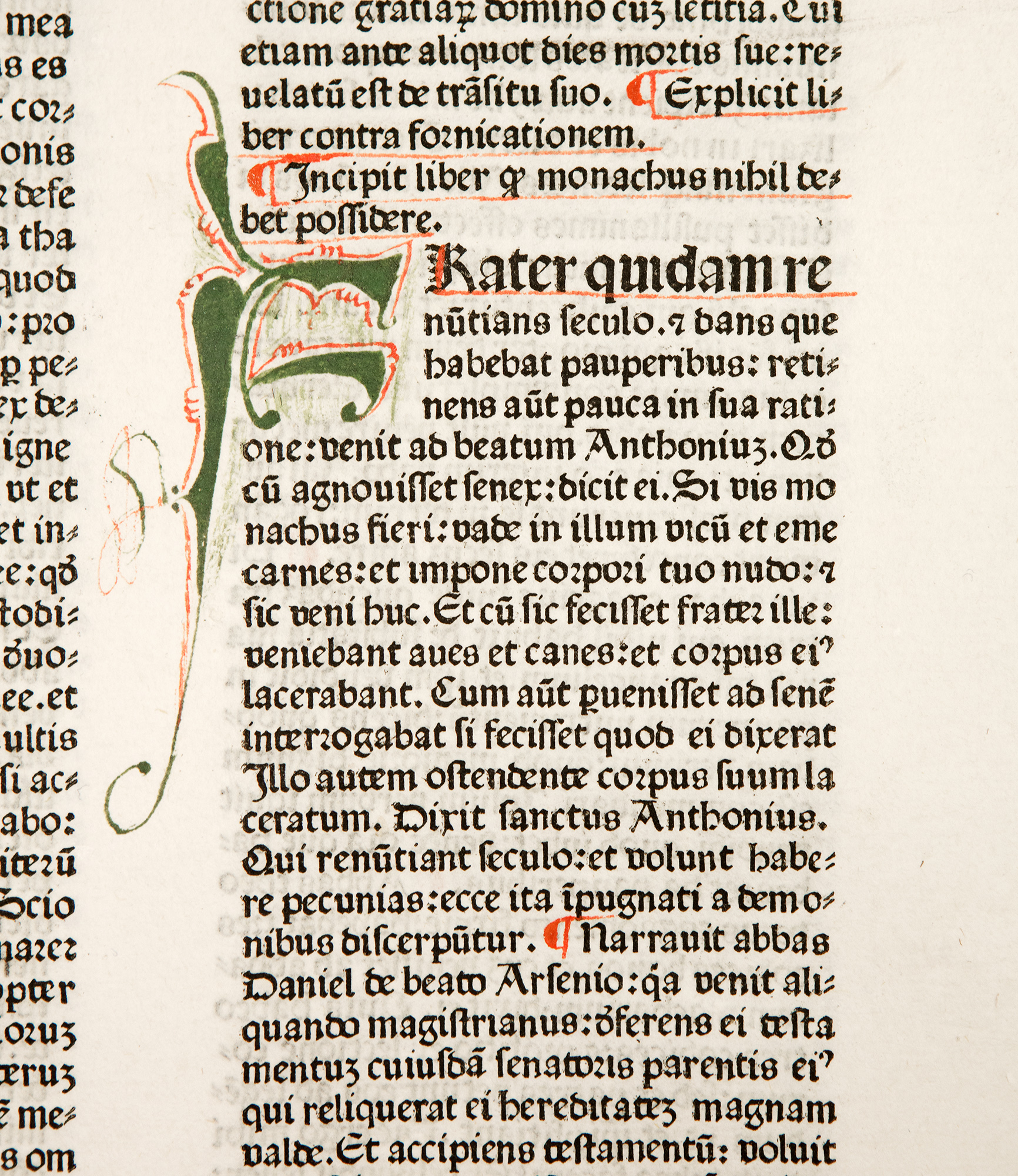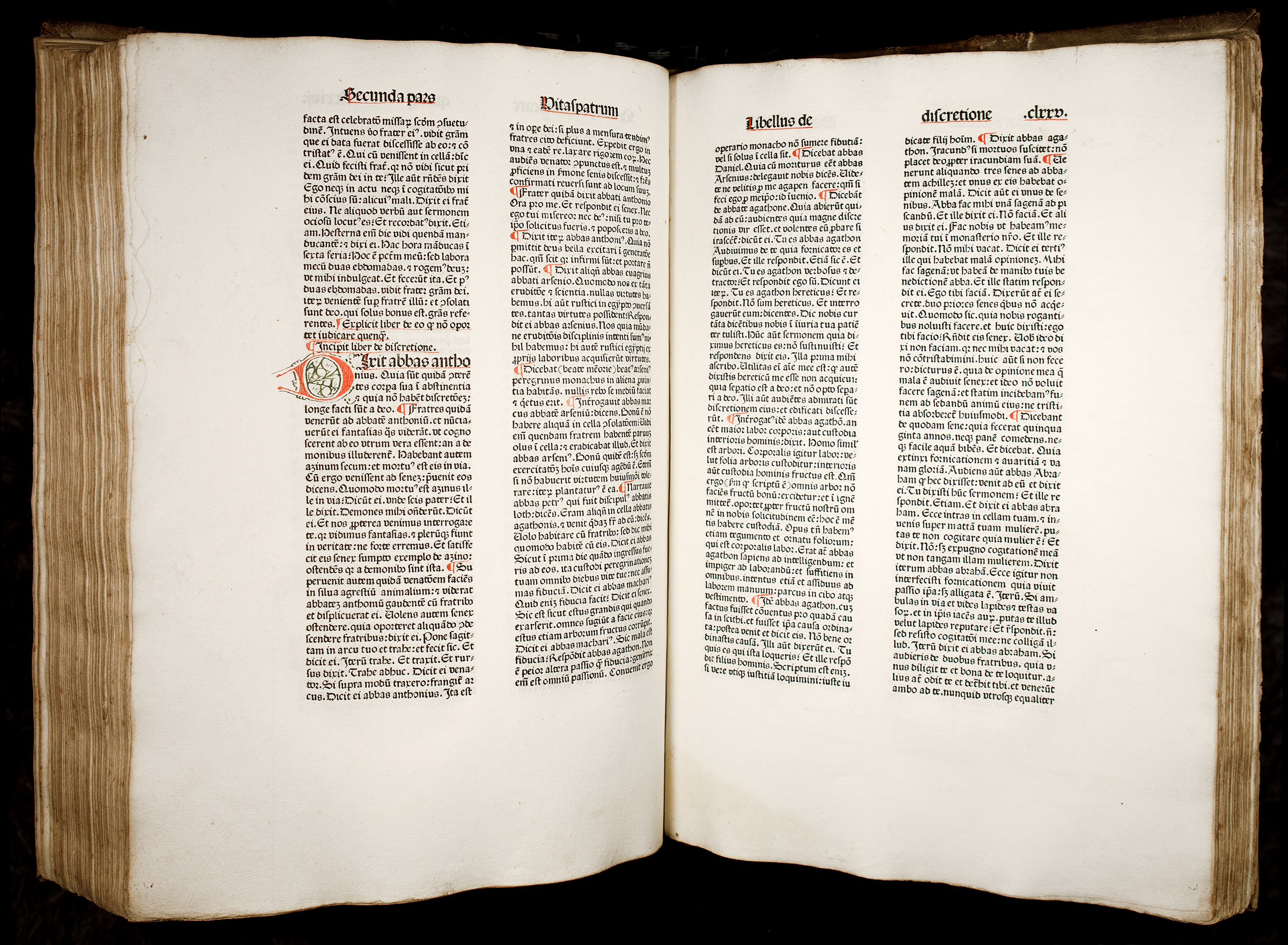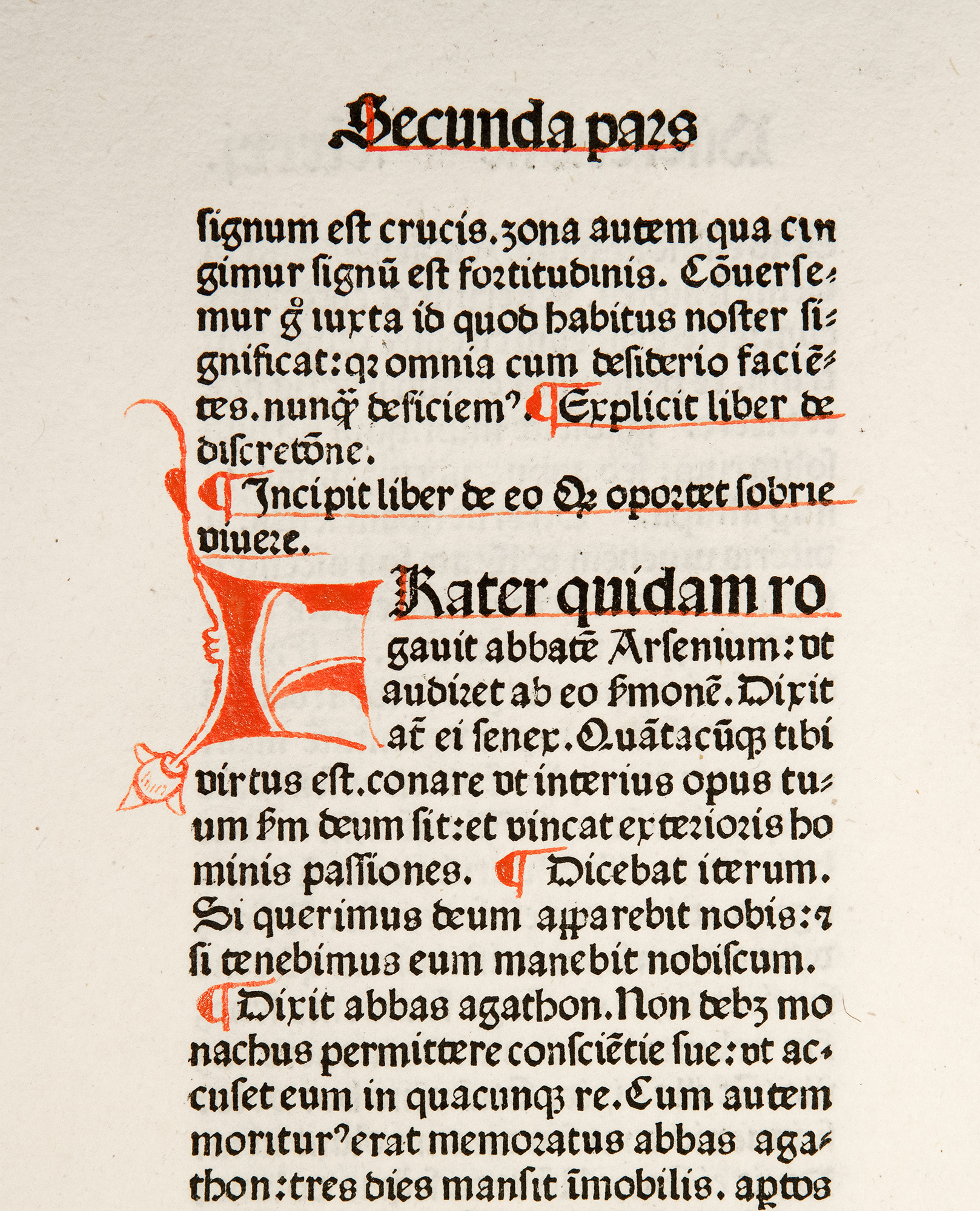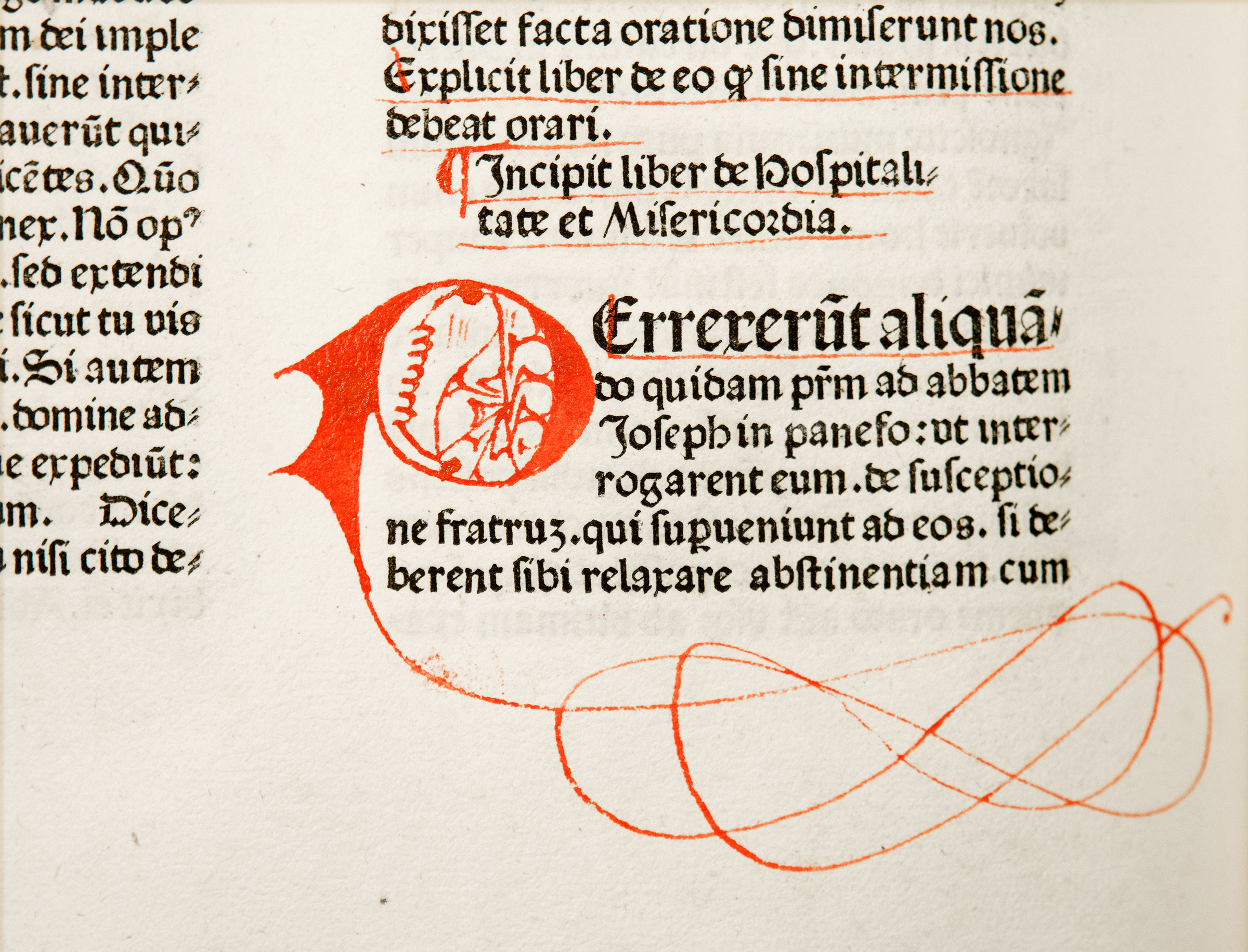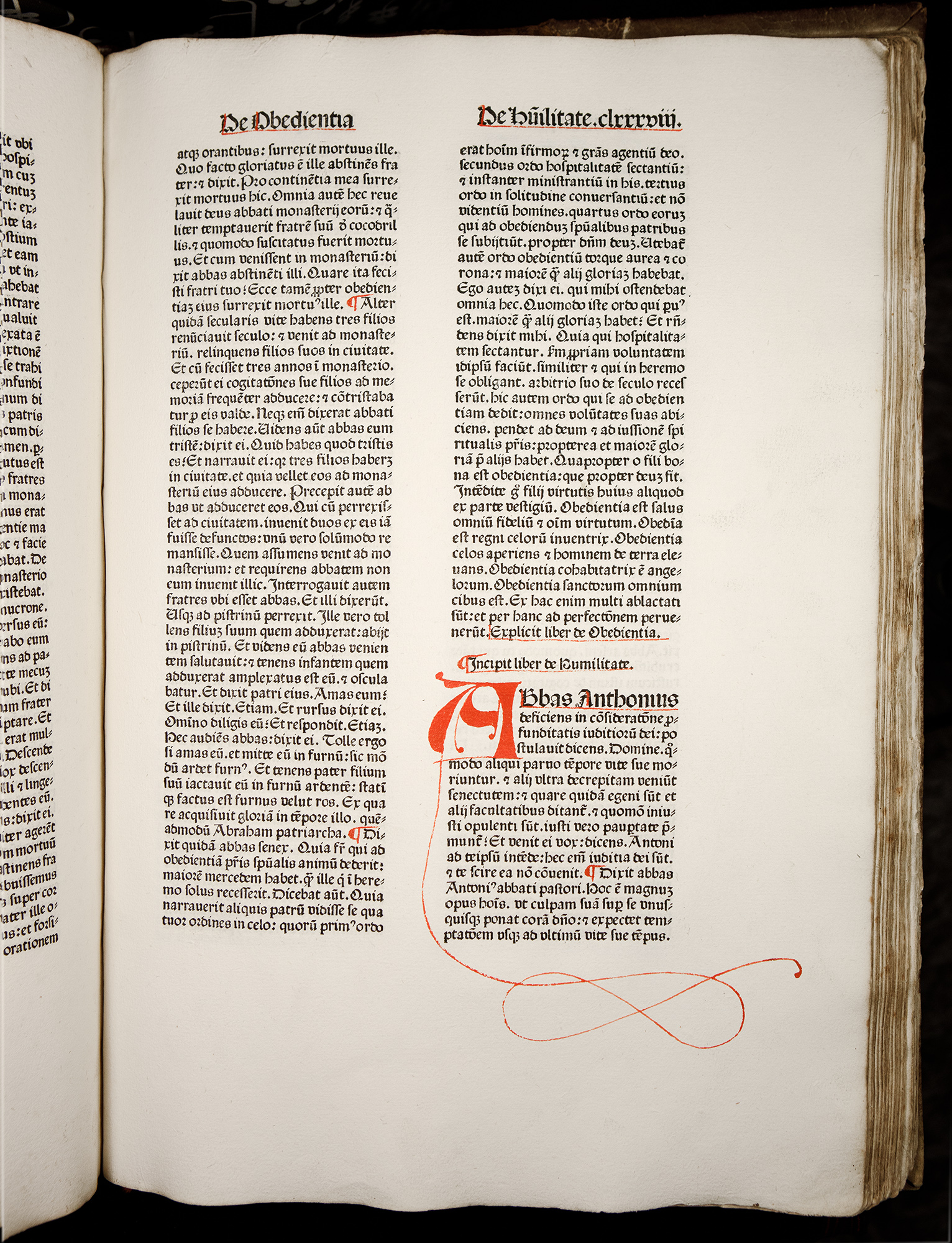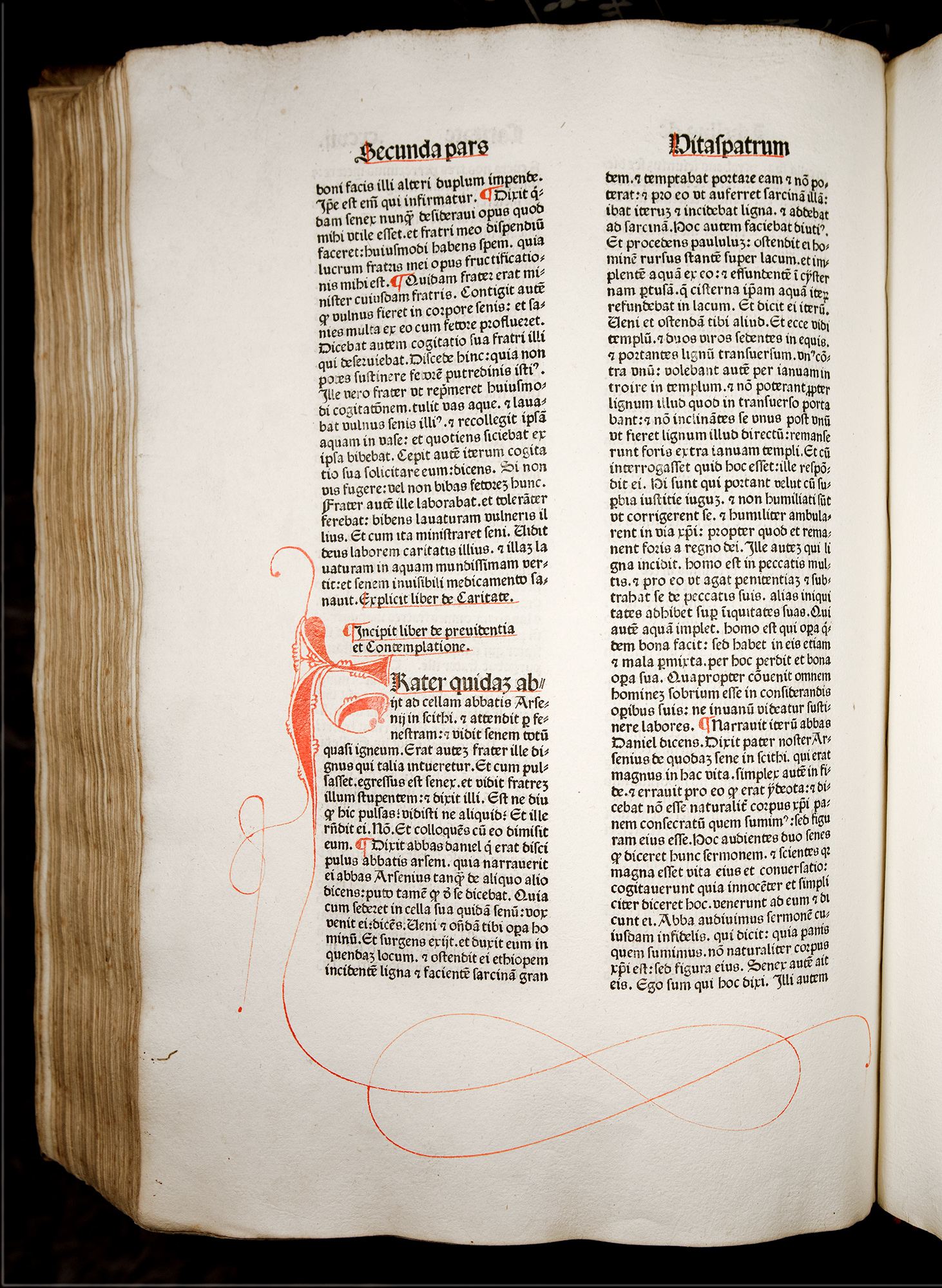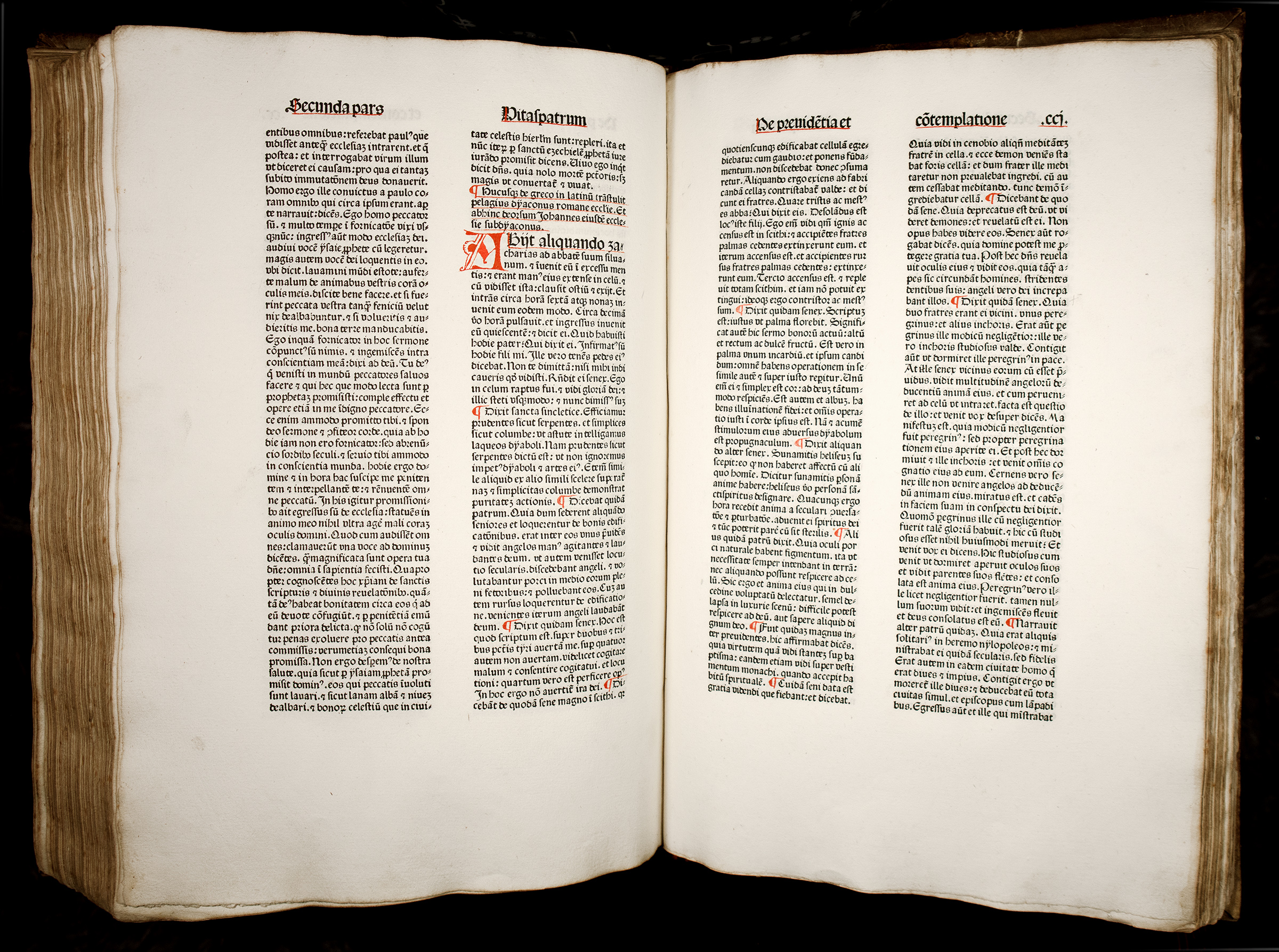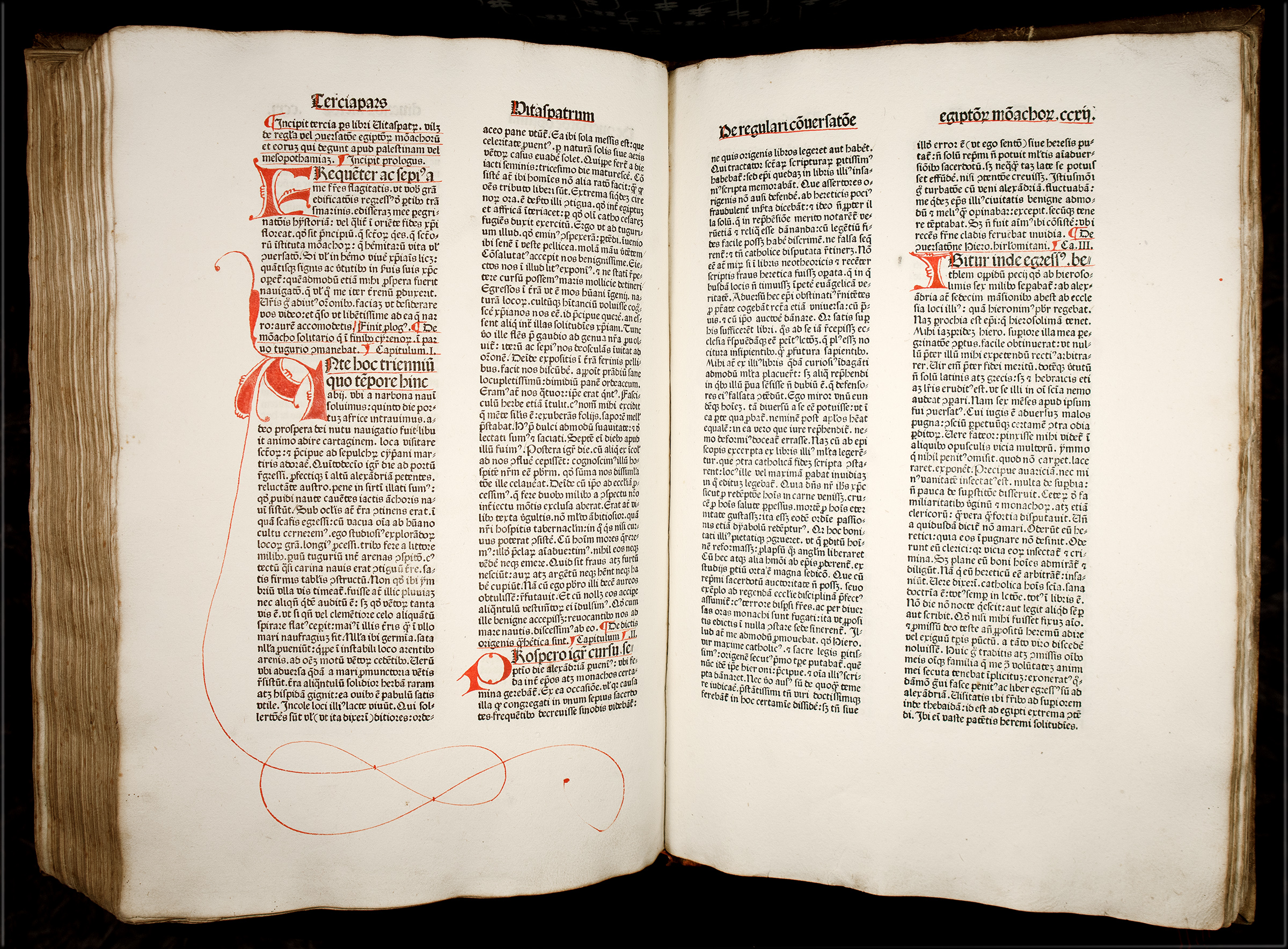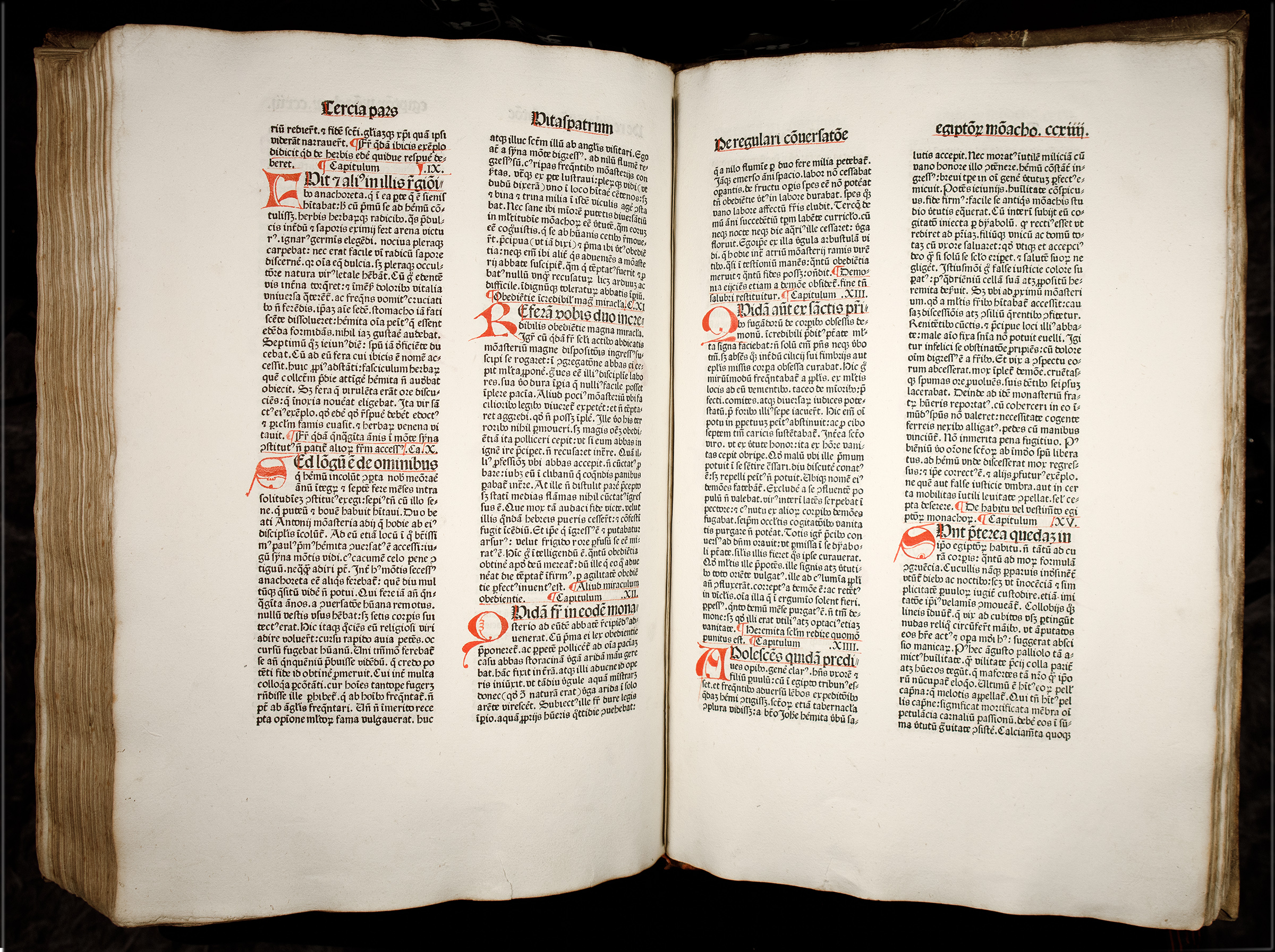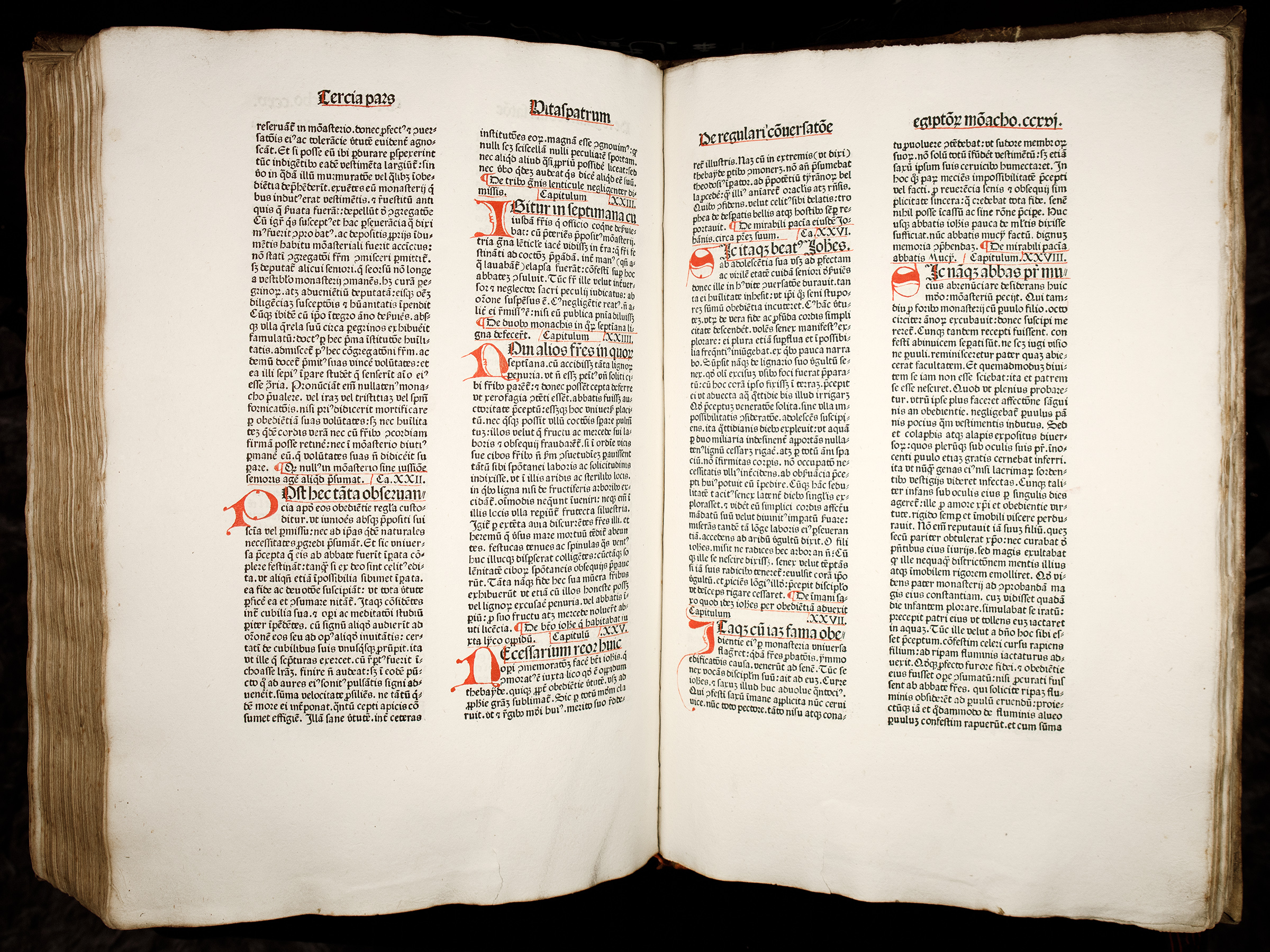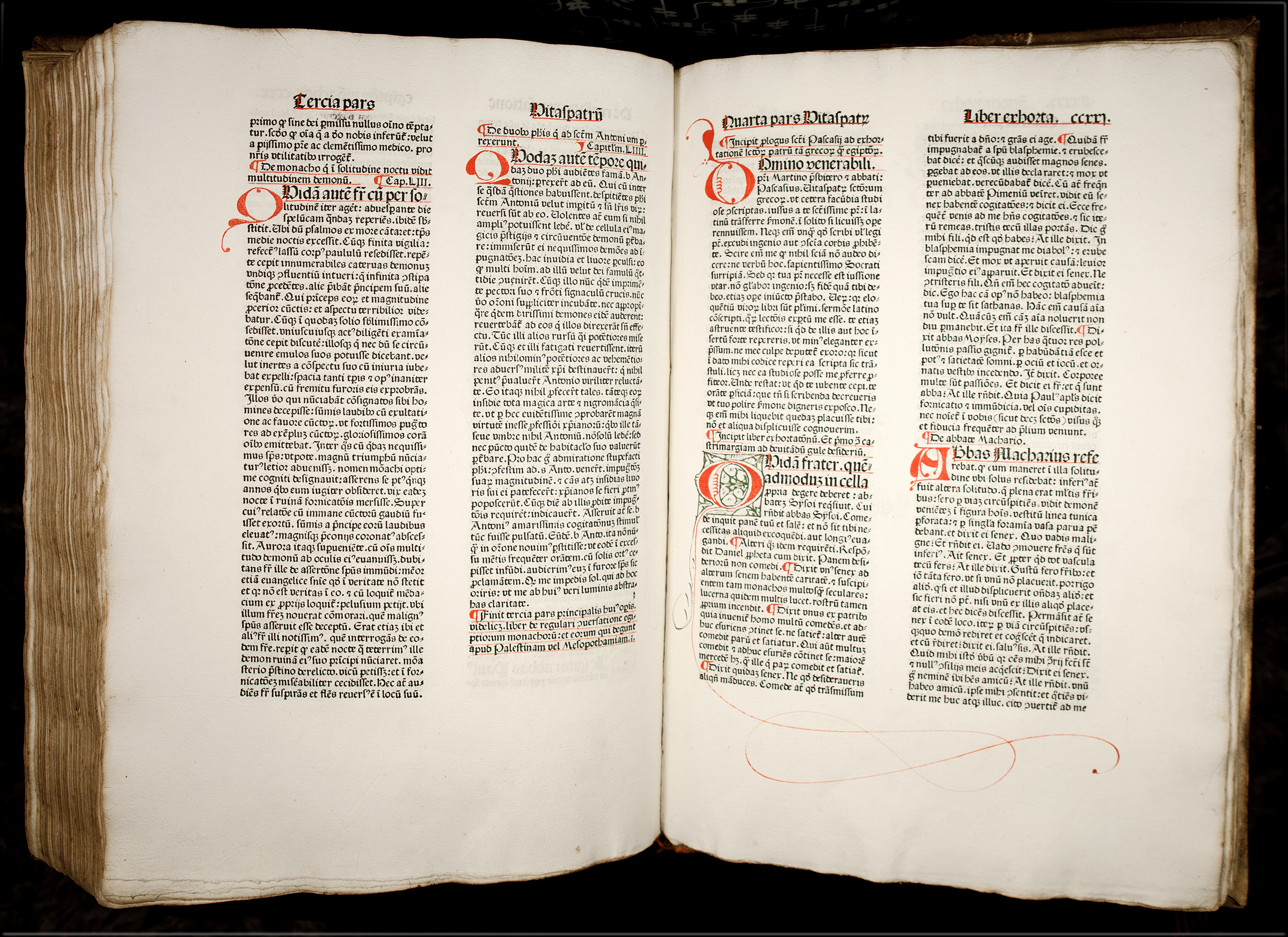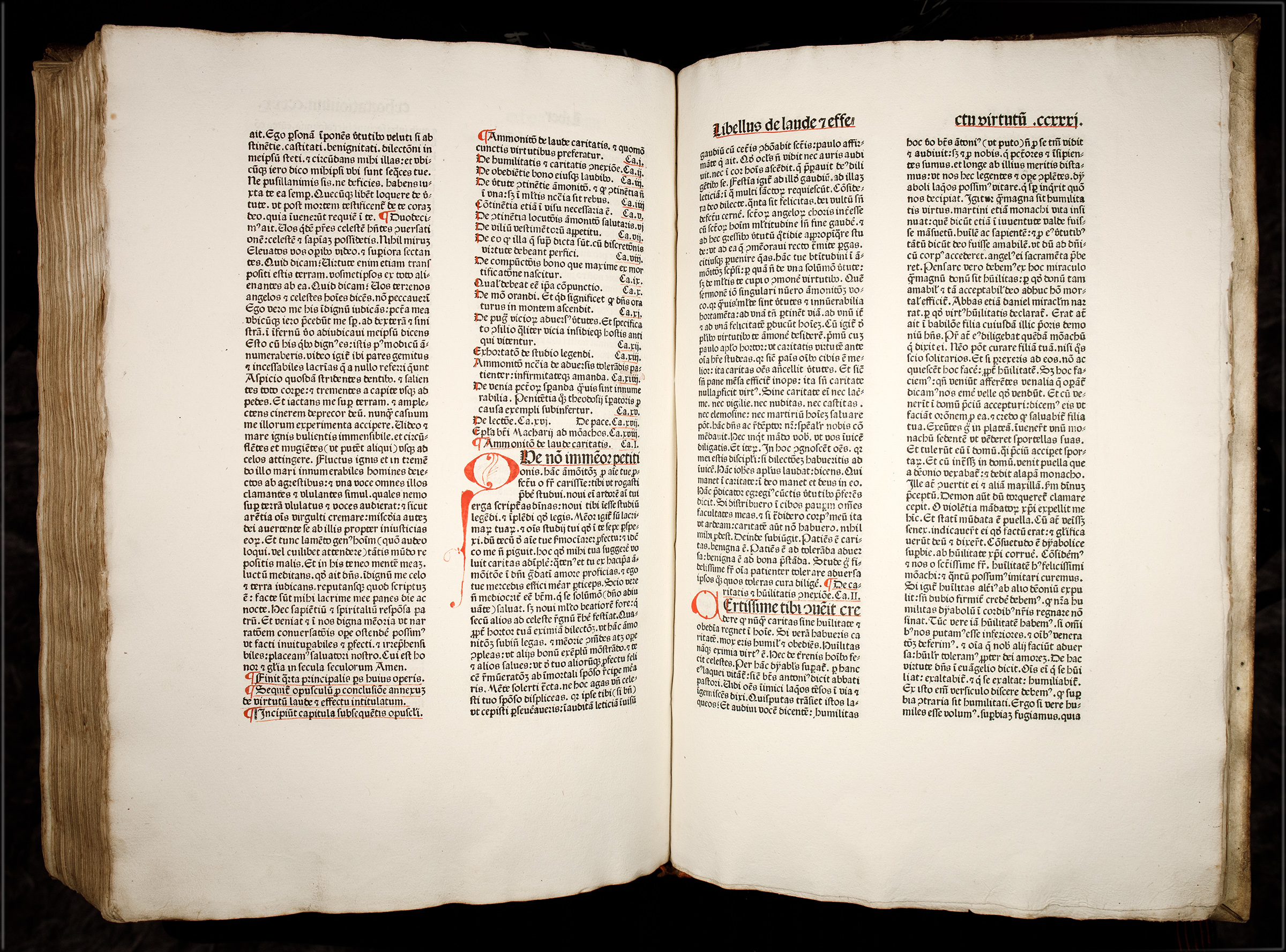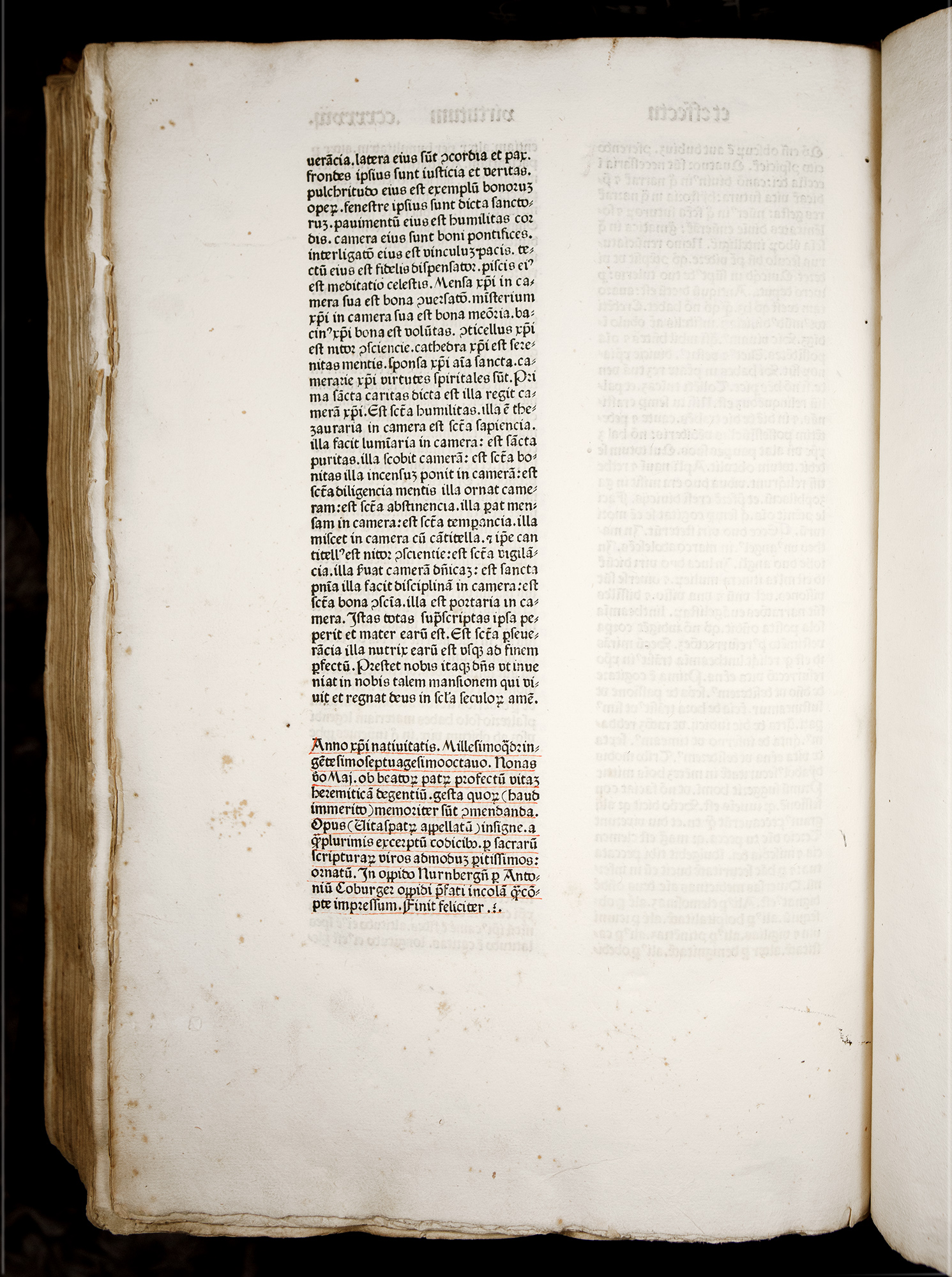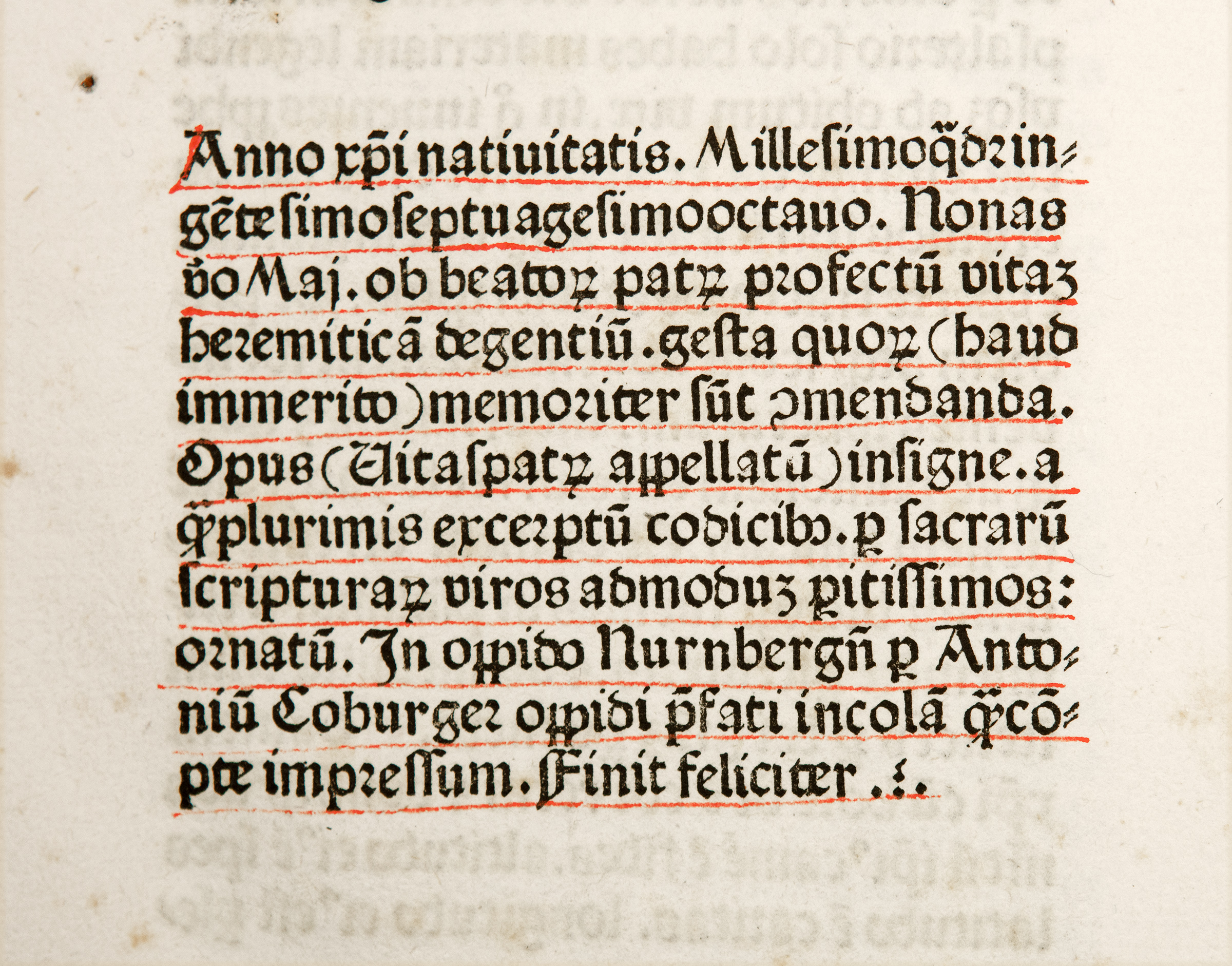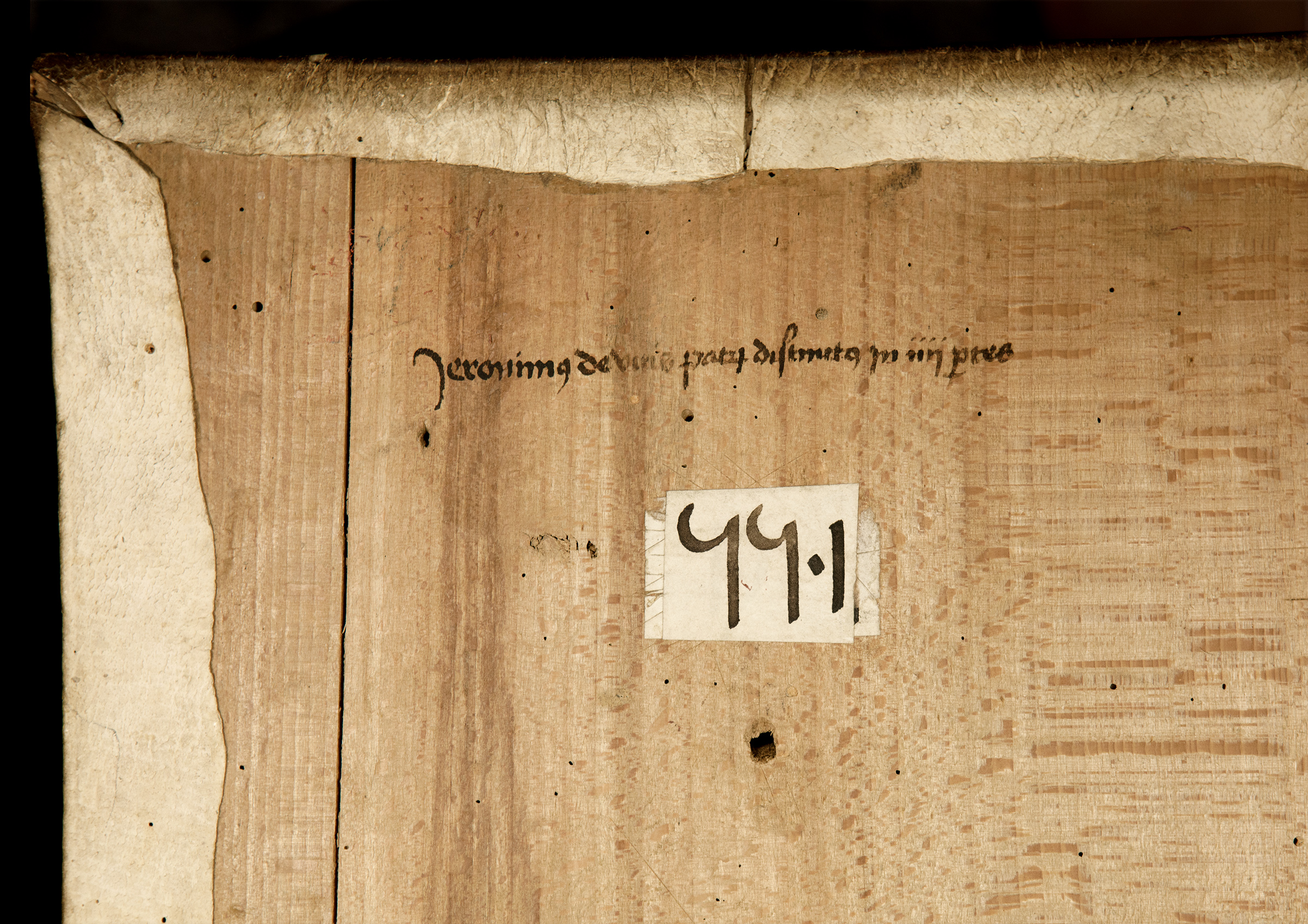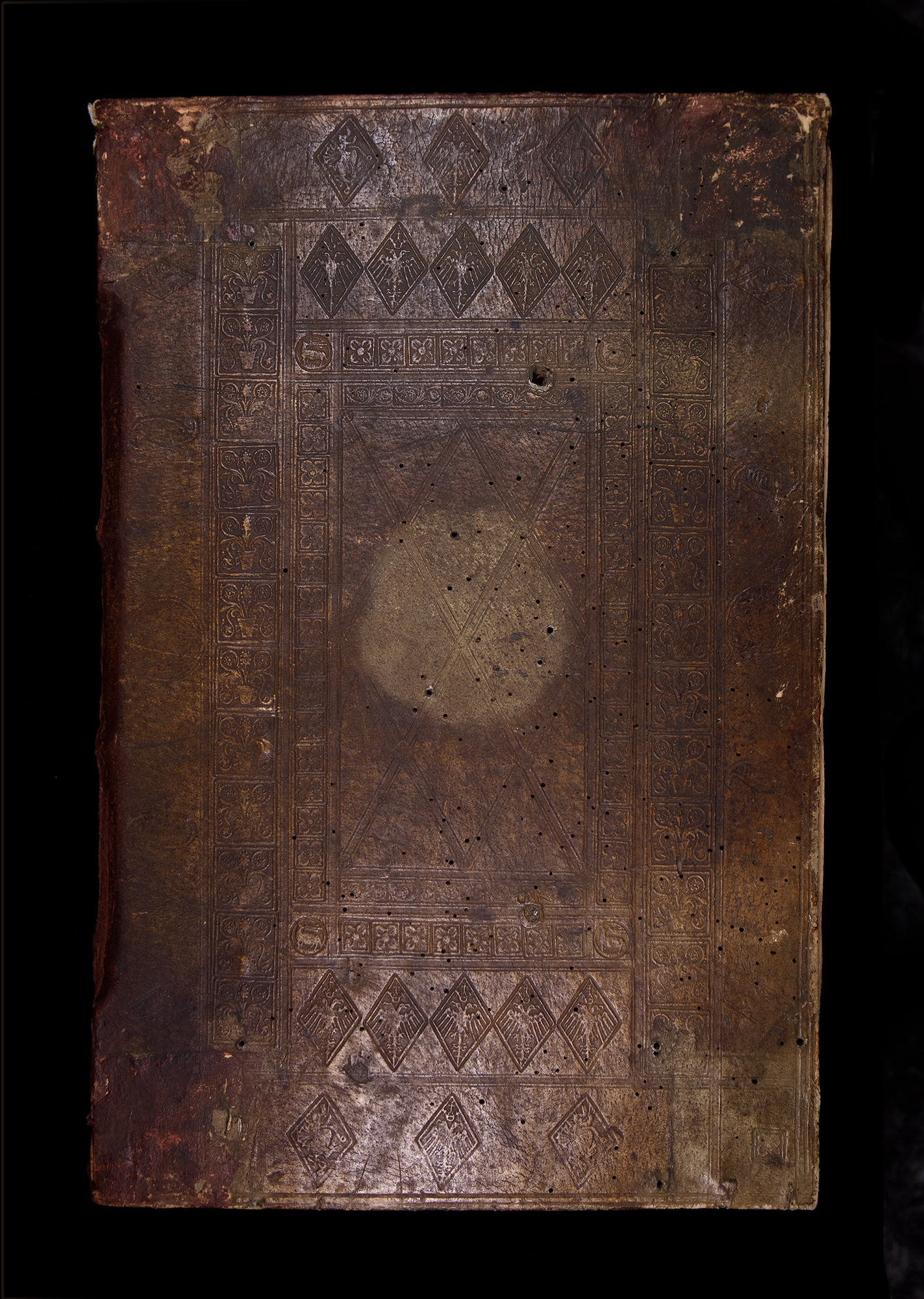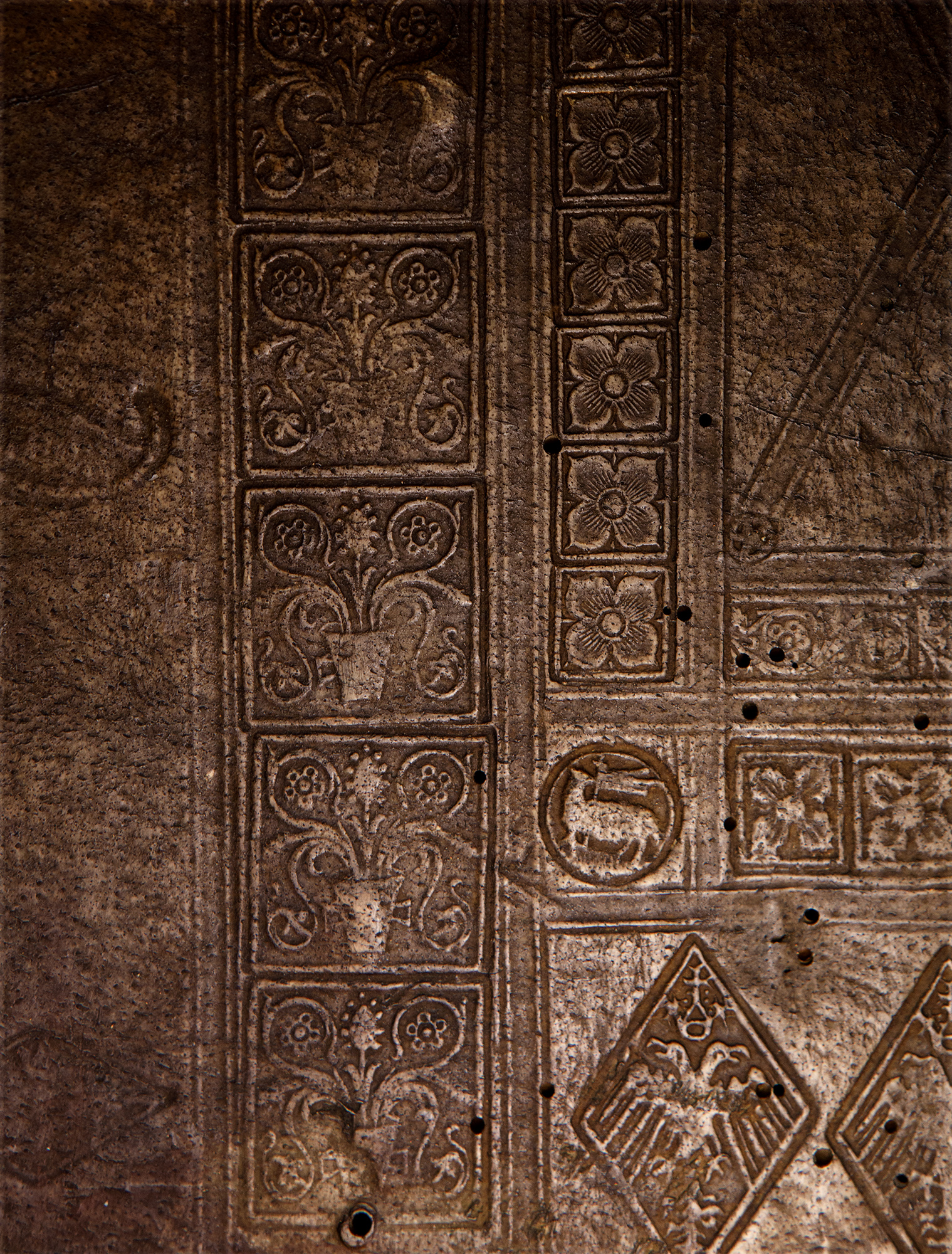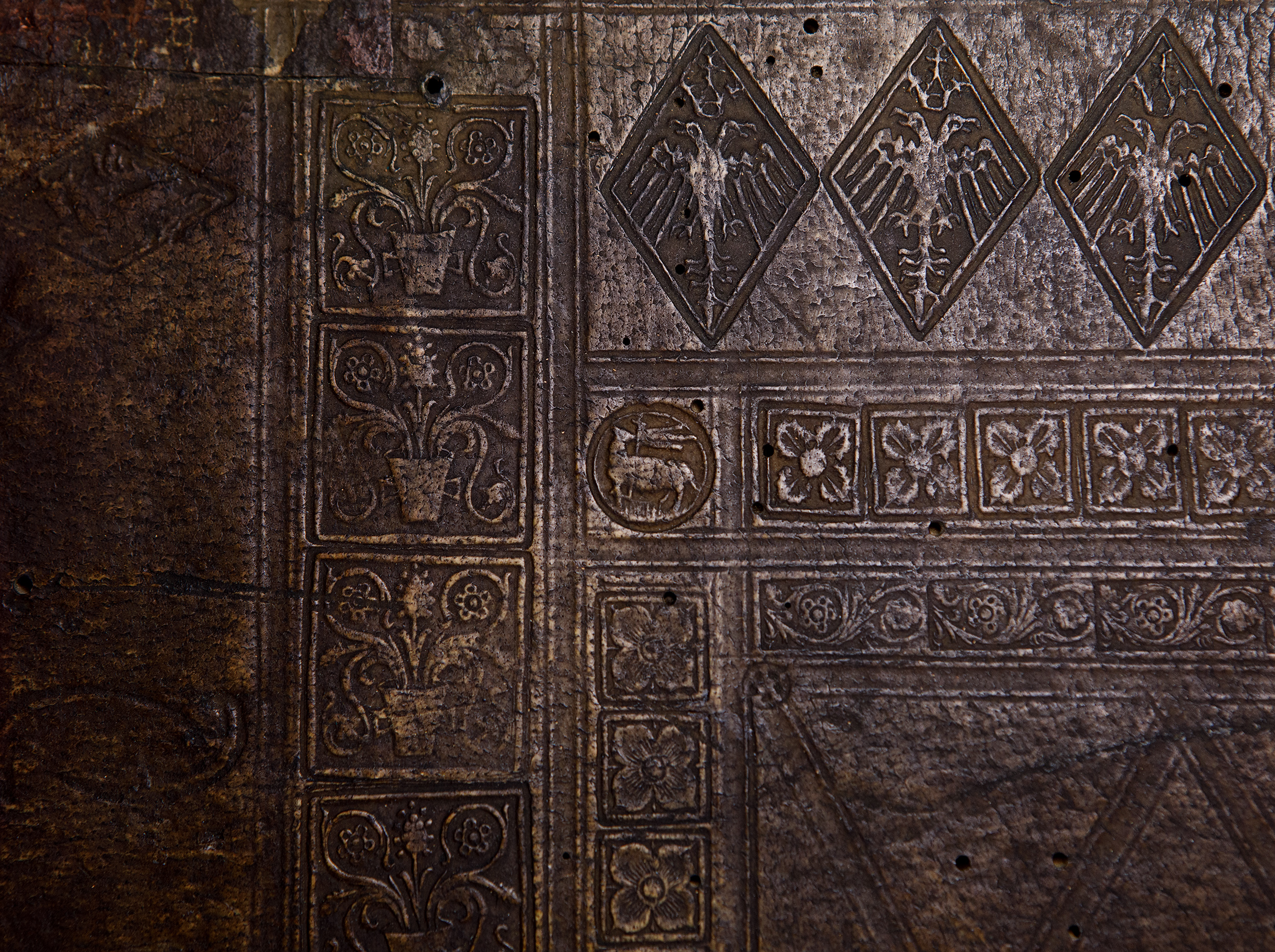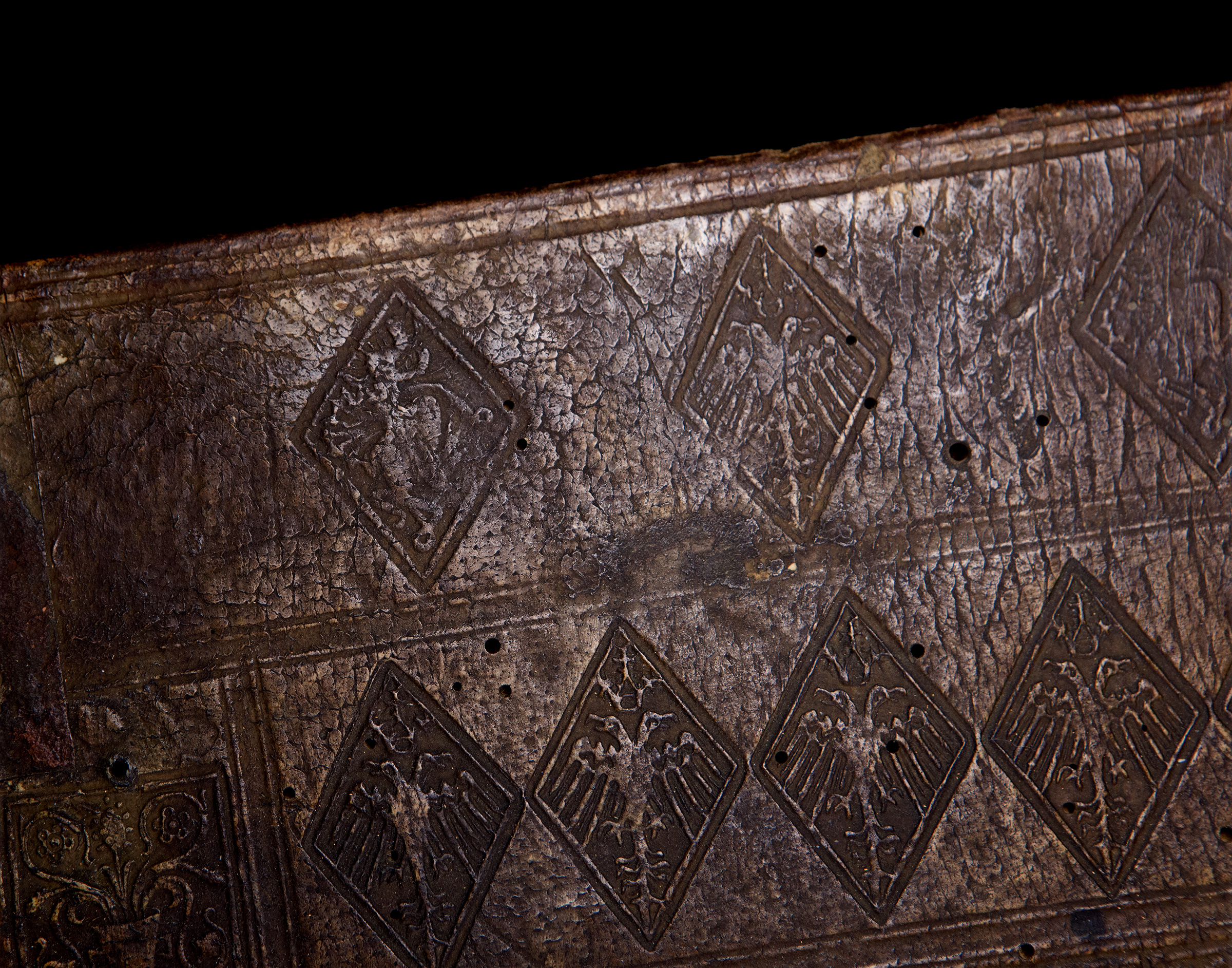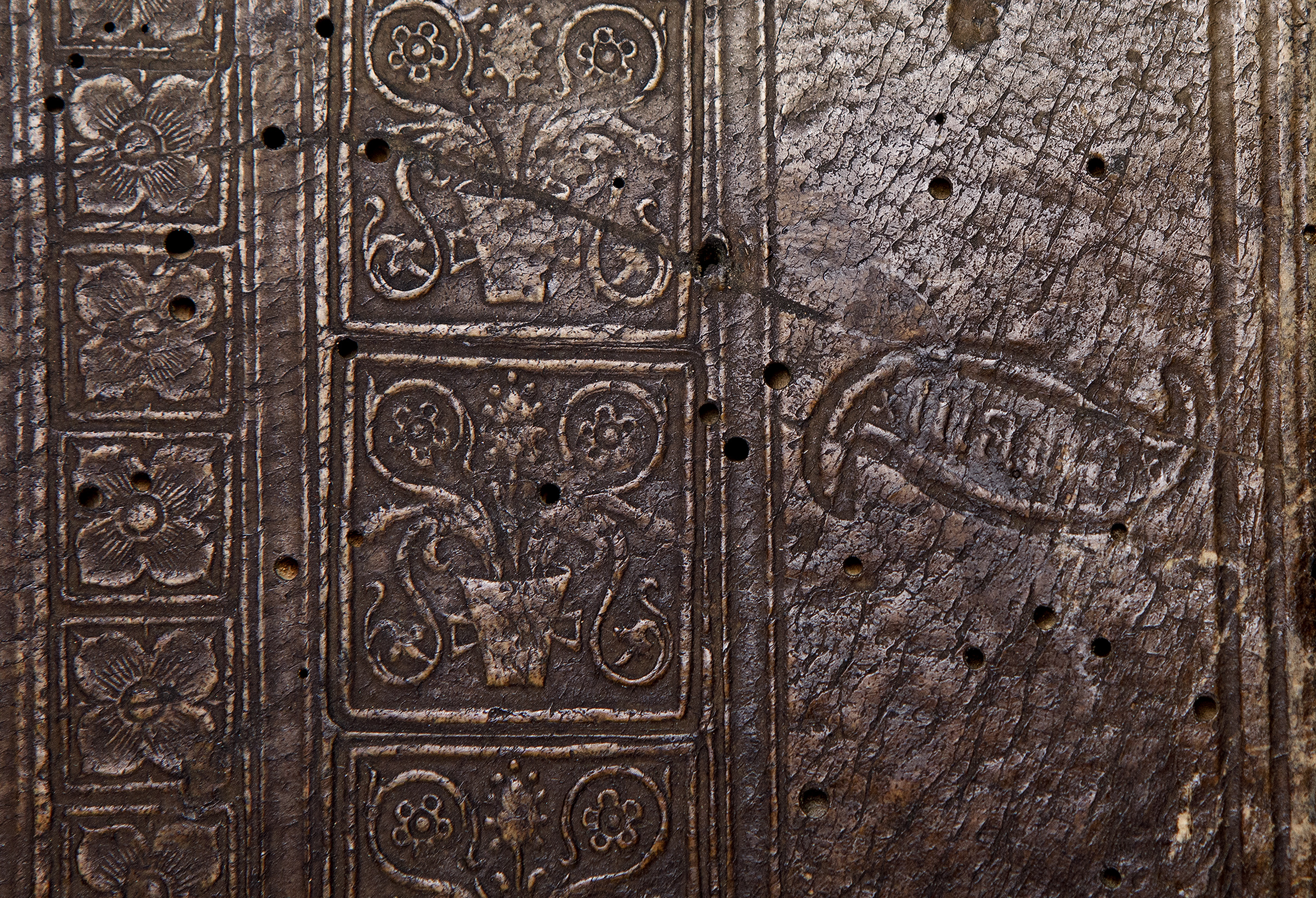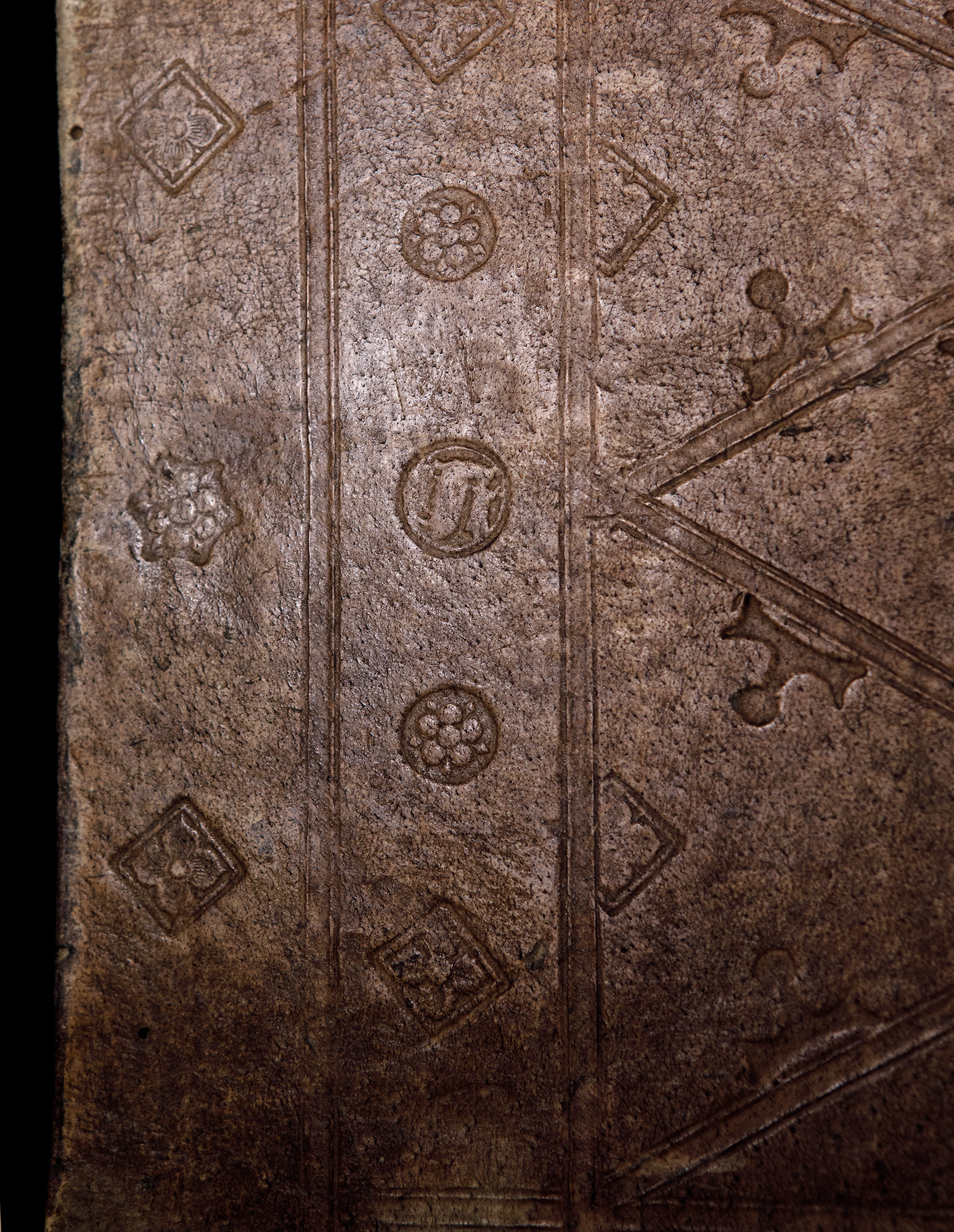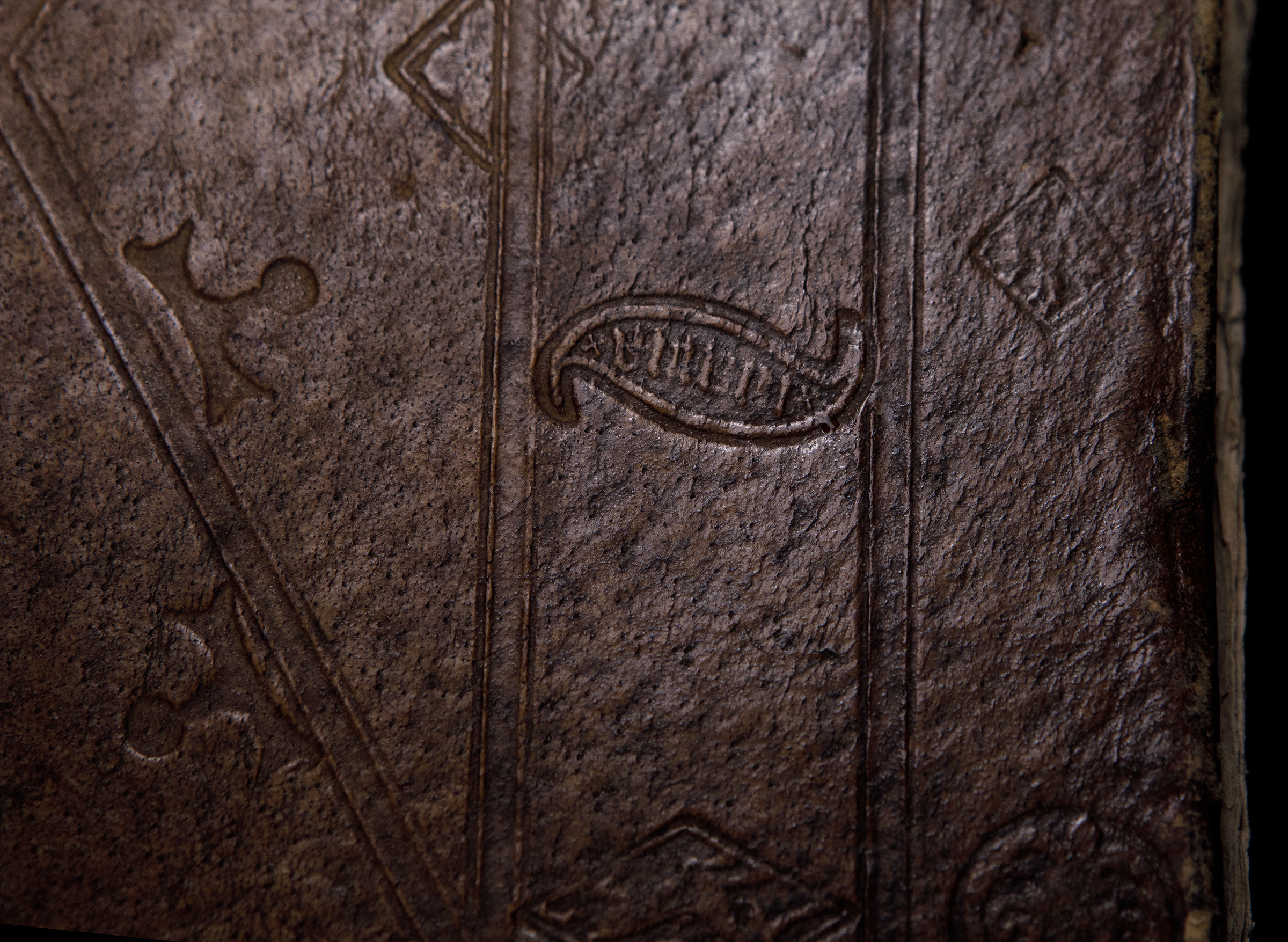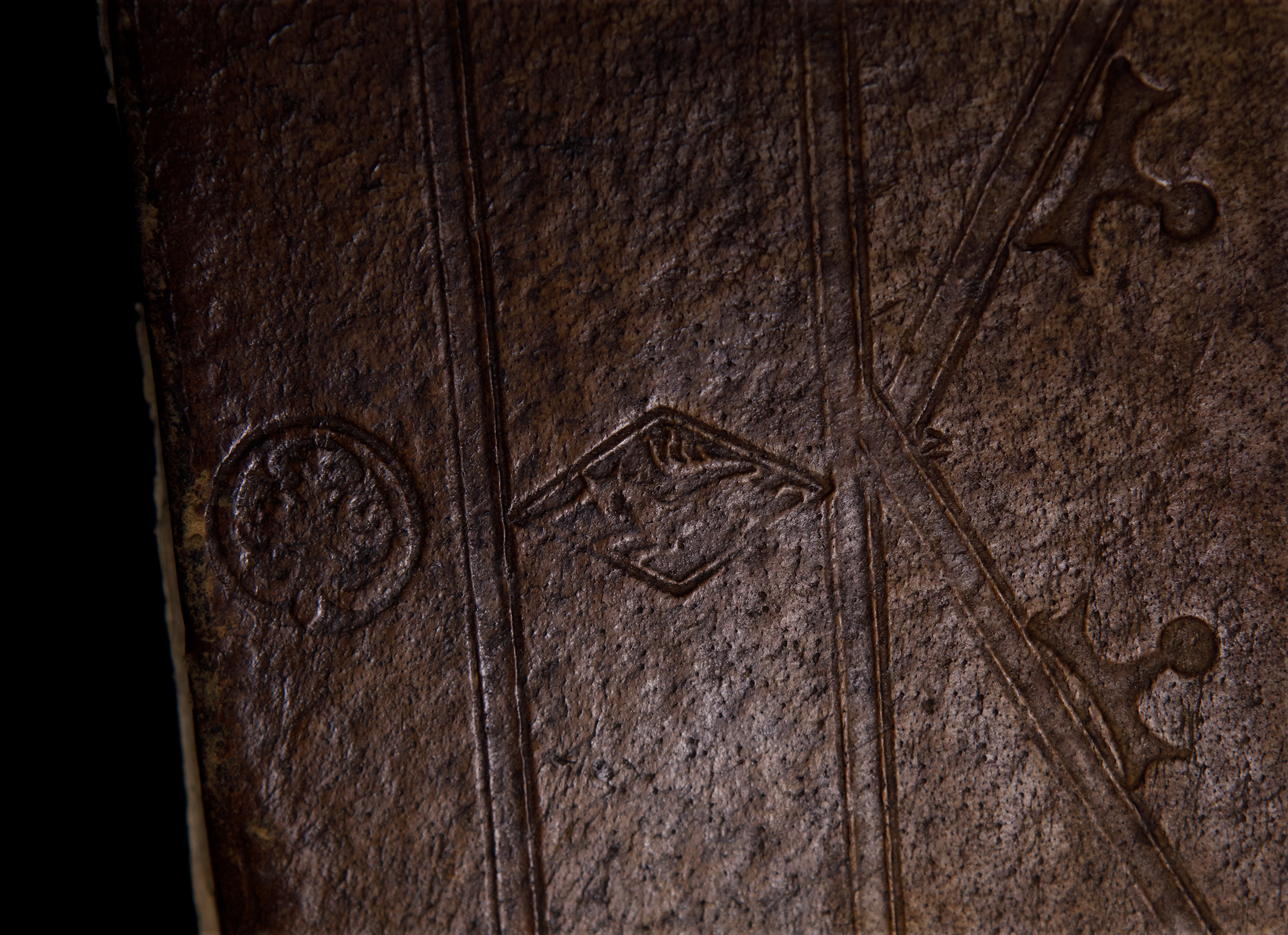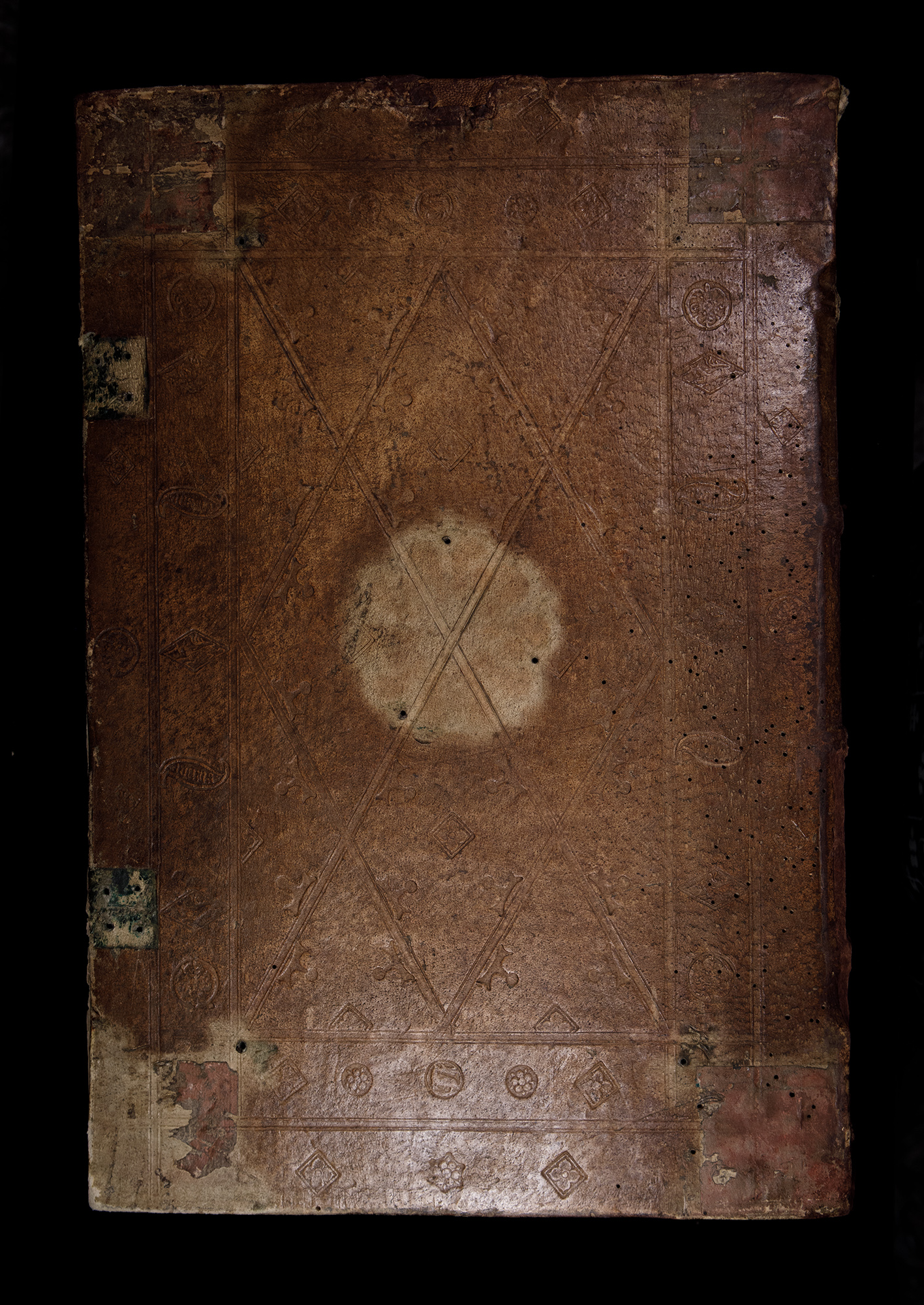
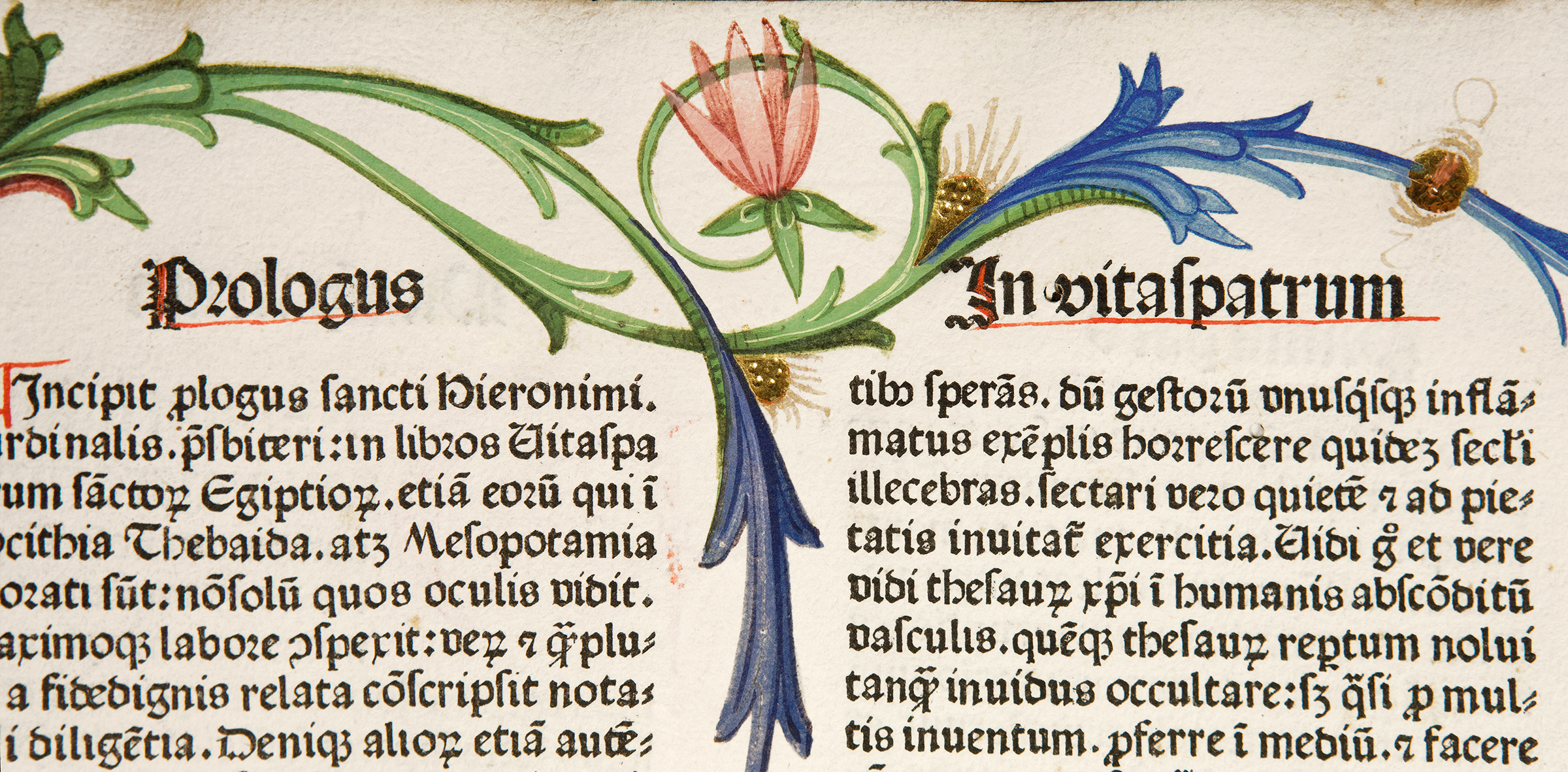
[Early Printing - Incunabula - Nuremberg] [Illuminated]
ST. JEROME (ATTRIBUTED TO)
Vitae sanctorum patrum,
sive Vitas patrum.
[WITH]
De laude et effectu virtutum.
[AND]
Pseudo-Macarius: Epistola ad monachos
Nuremberg: Anton Koberger, 7 May 1478. First edition thus.
WE ARE PLEASED TO OFFER A STUNNINGLY BEAUTIFUL EXAMPLE OF THIS MAGNIFICENT EARLY NUREMBERG INCUNABLE - COMPLETE, AND ENTIRELY UNTRIMMED AND PRESERVED IN ITS ORIGINAL MONASTIC BINDING, AND WITH ITS OPENING PAGE GORGEOUSLY ILLUMINATED IN GOLD AND COLORS, WITH ITS VAST OPENING INITIAL INHABITED WITH A CHARMING MINIATURE OF ST. JEROME AND HIS LION!
This is the rare 1st Edition edition of the longer version of the famous Vitas patrum, an extremely popular collection of the lives of the desert fathers, including also saying and exhortations ascribed to them.
Vitae patrum sanctorum (or Vitas patrum, as it is often called) is one of the most important sources on the early history of monasticism (cenobitism) and the 'Desert Fathers,' i.e. the ascetics and heremits in Egypt, Palestine and Mesopotamia of the first five centuries A.D. It served as the source of inspiration for St. Benedict who wrote the first monastic rule in the 6th century.
As an indispensable document of the early Christian history and the beginning of Christian monasteries, Vitas patrum were extremely popular in Medieval times (especially in the 14th and 15th century), and were traditionally (but erroneously) attributed to Saint Jerome, or Eusebius Sophronius Hieronymus (c.340-420), the author of the Vulgate translation of the Bible.
However, the Vitas patrum is, in fact, "not a single work of St. Jerome's, but an assemblage of lives of the early desert saints by Rufinus and others, Starting with Jerome's lives of St. Paul, the Hermit, Hilarius, and Malchus." (Sotheby's Cat. of Donaueschingen Incunabula sale, July 1994, no.155). Other sources from which material was incorporated into the Vitas patrum, included, for example, the Historia Lausiaca by Palladius and the Historia monachorum in Aegypto by Rufinus (who, probably, only translated it from an anonymous Greek original), which purports to describe a series of visits in the winter of 394-5 AD to several hermits and monks in the Thebaid and Lower Egypt.
The accounts of lives of these extraordinary human beings, as presented in the Vitas patrum, include reports of numerous miracles such as clairvoyance, the control of wild animals, miraculous healing and exorcisms. Most of the Desert Fathers practiced an extreme asceticism, which, among other things, often involved getting by on only one meal a week.
The work was translated into various European languages: the English translation completed by William Caxton in 1491 shortly before his death was published in 1495 by Wynkyn de Worde.
"The Desert Fathers' (and Mothers') extreme asceticism, their miracles and spectacular encounters with demons and their sparse, gnomic wisdom have thrilled readers from the fourth century until our times. To anchorites and ascetic monks, the Desert Fathers were an unreachable but fascinating ideal as well as a literary model for their own self-definition: no one could seriously hope to duplicate the Fathers' ascetic feats, but they were an inexhaustible source of narrative patterns and images.” (Monika Otter, Goscelin of St Bertin: the Book of Encouragement and Consolation, p.4)
Remarkably, the work contains lives and sayings of eleven female hermits (the 'desert mothers'). Four of them - St Marina, St Euphrosyne, St Pelagia and St Eugenia, - have often been called the "cross-dressing saints" for having worn men's clothes, and have recently been a subject of studies by feminist scholars (see e.g. S. Lowerre, To Rise beyond their Sex: The Representation of Female Cross-Dressing Saints in Caxton’s Vitas Patrum, in Riddles, Knights and Cross-Dressing Saints. Essays on Medieval English Language and Literature, ed. Thomas Honegger, pp.55-94)
This monumental edition of the Vitas patrum also includes De laude et effectu virtutum, which is a variant recension of the Admonitio de profectu animae, a treatise on the ascetic life attributed to Adalgerus, 10th-century bishop of Augsburg, as well as the Epistola ad monachos (‘A Letter to the Monks’) spuriously attributed to Macarius of Egypt (c. 300 – 391), aka Macarius the Great, a Coptic Christian monk and hermit. Born in Lower Egypt, Macarius “was practically the founder of Scete [monastic center] and was the master of Evagrius of Pontus. Hence he is really the fountainhead of the desert school of mystical theology. […] The Epistola ad Monachos was long thought to be genuine, but is almost certainly not by Macarius. […] [It] deals with the ideal of the monastic life, the ‘conversion’ to that true good which man desires by his very nature and which God makes accessible to him by grace. He considers the way of perfection in the spiritual life, especially apatheia and the need for humility. […] This is the proper spirituality of monks and contemplatives, although rather limited in its views. It is an early psychology of the contemplative life.” (Thomas Merton, A Course in Desert Spirituality, p.77-8).
This monumental edition was produced by Anton Koberger (c. 1440 - 1513), the famous German printer, publisher and bookseller, famous for having printed the Nuremberg Chronicle (1493), a landmark of incunabula. Koberger was born to an established Nuremberg family of bakers. In 1470 he married Ursula Ingram and after her death he remarried another member of the Nuremberg patriciate, Margarete Holzschuher. In all he fathered twenty-five children, of whom thirteen survived to adulthood. Initially working as a goldsmith in Nuremberg, Koberger turned to printing in 1470. He quickly became the most successful publisher in Germany, absorbing his rivals over the years to build a large capitalist enterprise, with twenty-four presses in operation, printing numerous works simultaneously and employing at its height 100 workers: printers, typesetters, typefounders, illuminators, and the like. Constantly improving his business prospects, he sent out traveling agents and established links with booksellers all over Western Europe, including Venice, Milan, Paris, Lyon, Vienna and Budapest. At the supply end, he acquired two papermills. Koberger was the godfather of the great German Renaissance artist Albrecht Dürer, who was born in 1471 (one year after Koberger started his press) and whose family lived on the same street.
Physical description:
Royal Folio; leaves measure 415 mm x 285 mm, with vast margins, apparently untrimmed. Bound in 15th-century blind-stamped South-German pigskin over wooden boards. Covers richly decorated in blind using both rolls and individual stamps, including flowerpots, dragon, double-headed eagle, ‘lamb of God’, text banners, etc; rear cover of somewhat different design with more geometric patterns. The quality of tooling - both in workmanship and in the detailing of the stamps - is superb. Most likely a formerly chained binding with evidence of several formerly present metal bosses, corner-pieces and clasps (all now gone). Old manuscript title to top spine compartment.
246 leaves (forming total of 492 pages);
foliated in roman numerals: [7], ccxxxviii, [1] ff.
Collation: [16 2-1310.8 14-1510 16-2510.8 26-278 286].
COMPLETE, including all three integral blanks [11, 21, 286]!
Printed in double column; 51 lines per page and headline. Text in fine large gothic letter: Type: 3:110aG (text), 4:160G (headings and headlines).
Rubricated throughout in contemporary hand: 3- to 6-line lombard initials supplied in red and/or green, some with intricate penwork infill decorations and/or long marginal extensions, paragraph marks and capital strokes in red. Opening 14-line initial ‘B’ on 22r splendidly illuminated by contemporary South-German artist: the delicately painted letter ‘B’ filled with intricate tracery in lighter shades of blue is inhabited with a fine scene of St Jerome with his lion and an open book on a lectern (painted in red, white, brown and orange), all against the solid liquid gold background; the initial’s extensions form winding vines terminating in large flowers and gold bezants, painted with consummate skill! in shades of blue, green and pink.
Includes general Index (tabula) on leaves 12r-6v and index to part II on leaves 161r-2v.
Colophon on 285v.
Condition:
Very Good antiquarian condition. Complete, including all three integral blanks. Binding rubbed, with wear to extremities, several small holes to boards, minor repairs to spine; clasps and metal bosses perished. Inner hinges reinforced. Pastedowns removed (if ever present) revealing insides of the wooden boards. The index leaves (1st quire) with a few tiny wormholes (not affecting legibility). Texblock near fine with only minor occasional soiling; a few leaves at the end with fore-edge very lightly frayed. In all, a splendid, extremely attractive illuminated example of this massive, superbly printed early incunabulum with vast margins (likely uncut) in its original monastic binding.
Bibliographic references:
Goff H-199; Hain/Copinger 8595; BMC II 416; Bod-inc H-111; BSB-Ink V-250; Polain(B) 3992.
